2023/05/23: Flying Home
Category: General
Posted by: The Agnew Family
We had a great time in London and in Scotland but we are ready to go home. We picked a hotel quite close to the airport which worked out really well. Last night, once the car was unloaded we drove the 5 minutes to the car rental to return the car and walked the 2 minutes back to the hotel --- one way roads made the driving longer than the walking.
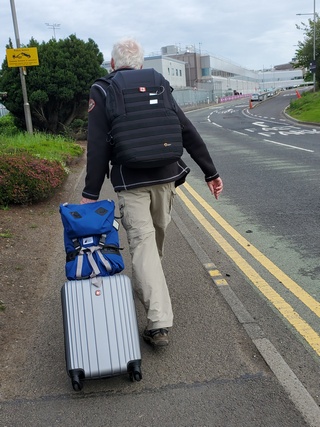
This morning we walked to the airport terminal which took about 5 minutes.
The flight leaving Edinburgh left about 15 minutes late but we landed on time in London. We had about an hour and half between flights. After walking down a long hallway then taking an elevator down 2 flights (the escalator was broken) then riding the rapid transit one stop then up a couple of escalators and walking down another hallway we arrived at the gate for the flight to Toronto where boarding had started. Everyone was on board and we were ready to leave at the scheduled departure time. Except we didn't. Apparently, there was an issue in the cabin and by time that was fixed the tug that was going to push the plane off had left to move another plane. So we waited some more till the tug came back and finally took off about 2 hours late. Somehow the captain managed to speed up the flight and we arrived in Toronto only 1 hour late. Later in the evening I noticed an email from British Airways apologizing for the delay.
Luckily Ed and I were not bothered by the delay as Toronto was our final destination and our ride checked the estimated arrival time of the flight before he left home.
It's good to be home.

This morning we walked to the airport terminal which took about 5 minutes.
The flight leaving Edinburgh left about 15 minutes late but we landed on time in London. We had about an hour and half between flights. After walking down a long hallway then taking an elevator down 2 flights (the escalator was broken) then riding the rapid transit one stop then up a couple of escalators and walking down another hallway we arrived at the gate for the flight to Toronto where boarding had started. Everyone was on board and we were ready to leave at the scheduled departure time. Except we didn't. Apparently, there was an issue in the cabin and by time that was fixed the tug that was going to push the plane off had left to move another plane. So we waited some more till the tug came back and finally took off about 2 hours late. Somehow the captain managed to speed up the flight and we arrived in Toronto only 1 hour late. Later in the evening I noticed an email from British Airways apologizing for the delay.
Luckily Ed and I were not bothered by the delay as Toronto was our final destination and our ride checked the estimated arrival time of the flight before he left home.
It's good to be home.
2023/05/22: Inverness to Edinburgh
Category: General
Posted by: The Agnew Family
Today is the last touring day of our trip with our destination being a hotel within walking distance to the Edinburgh airport.
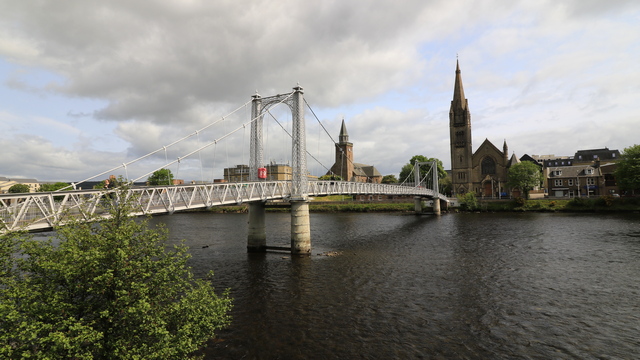
Downtown Inverness like most city and towns in Scotland is full of old buildings. One big difference is Inverness has the River Ness flowing through it.
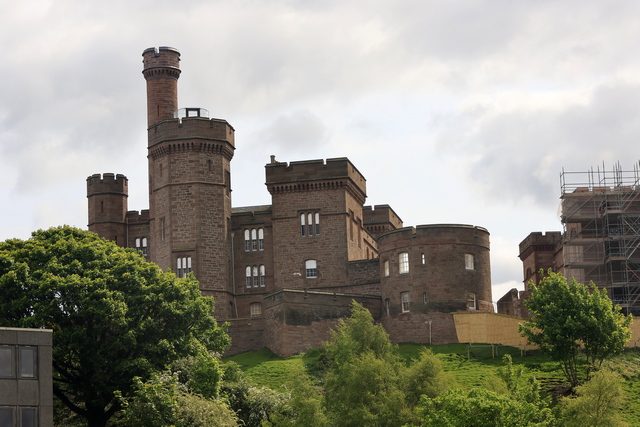
A huge restoration project is under way at Inverness Castle. You can see some of the scaffolding on the right side of the photo. A succession of castles have stood on this site since 1057, although the present structure dates from 1836.
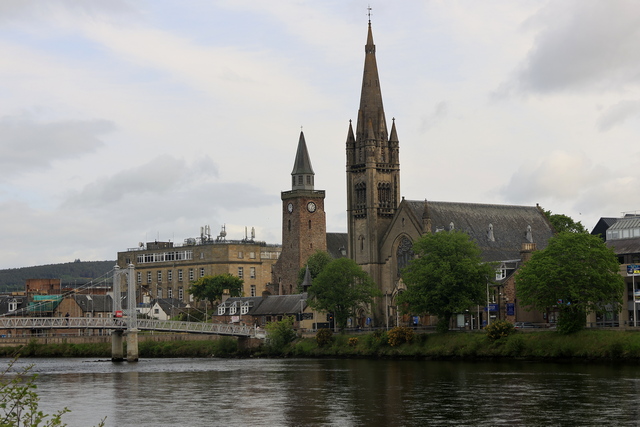
One of the many beautiful churches in Inverness.
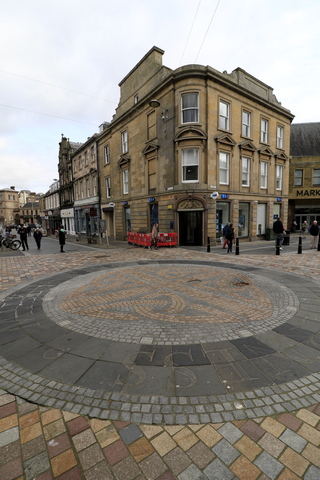
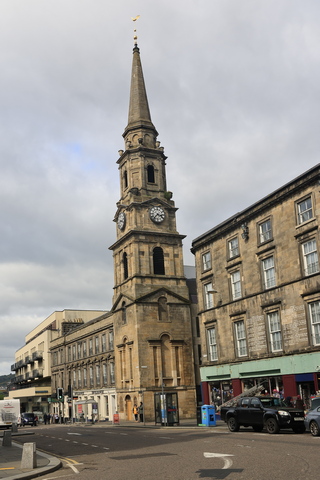
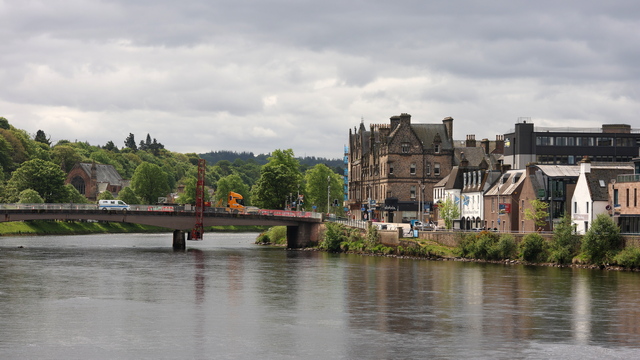
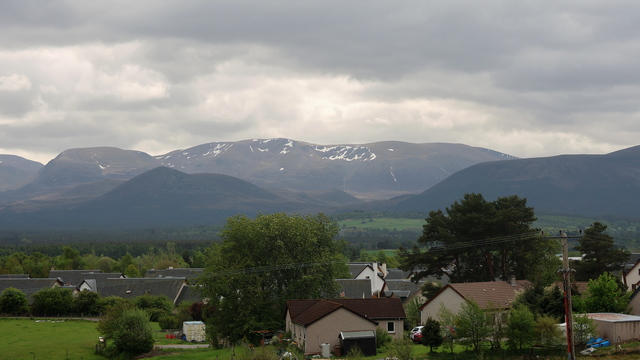
On our drive we could see snow on the mountain tops.
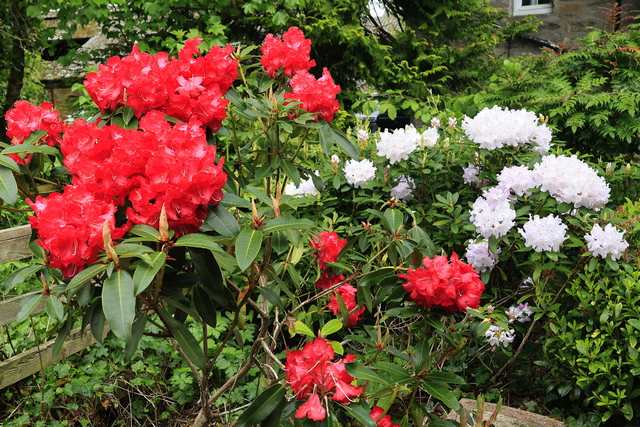
The Rhododendrons are in bloom. This was in Pitlochry a very cute small town.
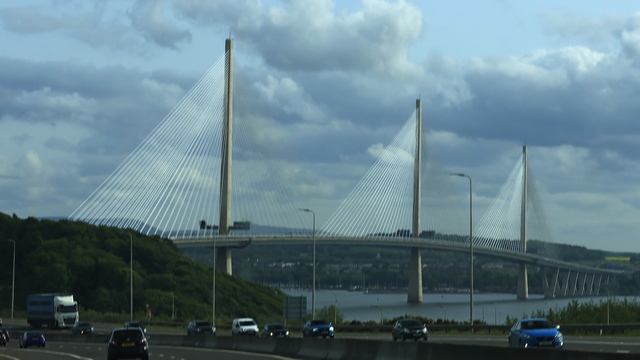
A beautiful bridge as we drove into Edinburgh area.

Downtown Inverness like most city and towns in Scotland is full of old buildings. One big difference is Inverness has the River Ness flowing through it.

A huge restoration project is under way at Inverness Castle. You can see some of the scaffolding on the right side of the photo. A succession of castles have stood on this site since 1057, although the present structure dates from 1836.

One of the many beautiful churches in Inverness.




On our drive we could see snow on the mountain tops.

The Rhododendrons are in bloom. This was in Pitlochry a very cute small town.

A beautiful bridge as we drove into Edinburgh area.
2023/05/21: Orkney to Inverness
Category: General
Posted by: The Agnew Family
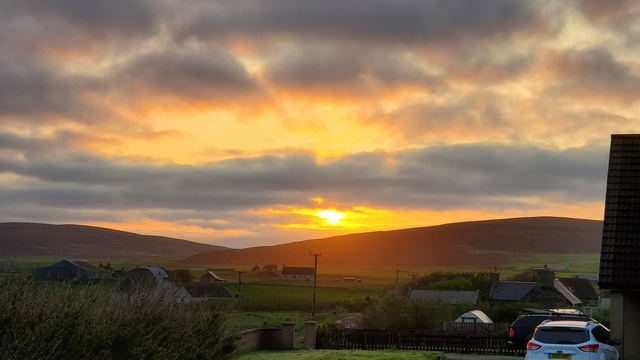
Good morning ... it's 5:15 am. Ed and I are up and driving to the ferry. When I originally planned the trip I booked a 9 am ferry. Due to unforeseen circumstances, the ferry schedule changed and we were booked onto a 6:30 am ferry. BTW sunrise was at 4:28 am.
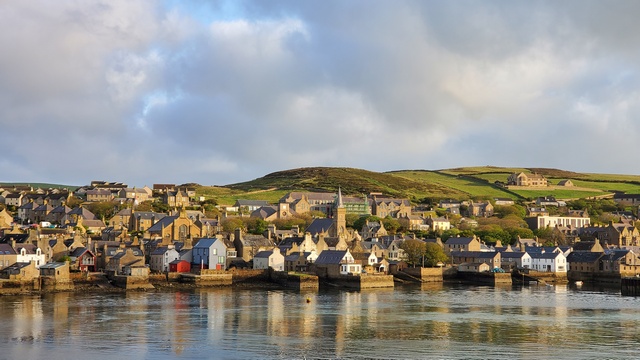
Stromness habour.
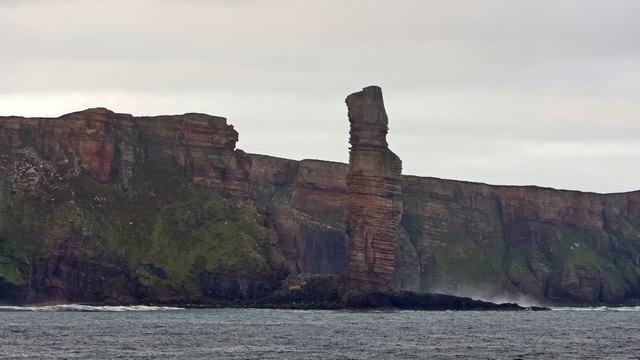
The Old Man of Hoy. Not enough sun to get a good photo but the haze was even worse on the way to Orkney. As the clouds are disappearing, the ferry riders later today should get good photos.
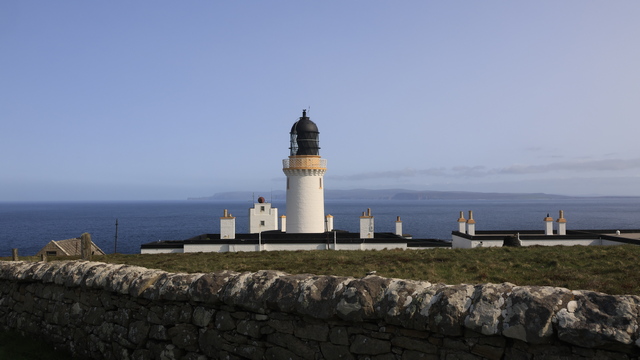
Dunnet Head lighthouse at the most northerly point in mainland Scotland.
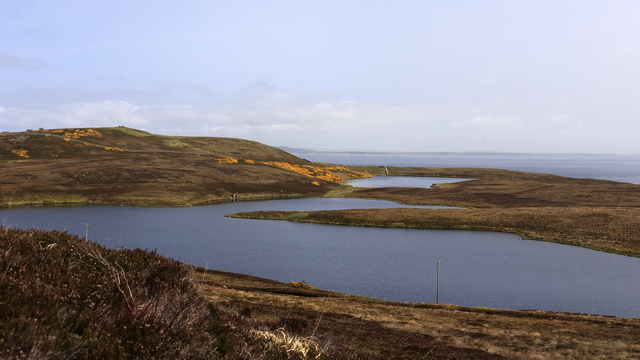
A view at Dunnet Head.
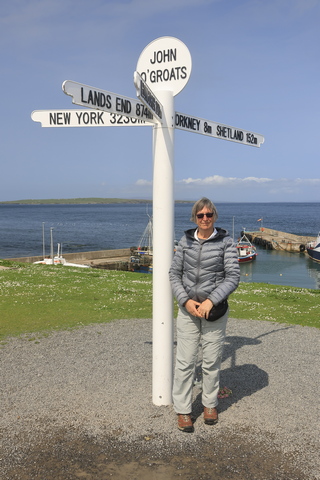
John o'Groats
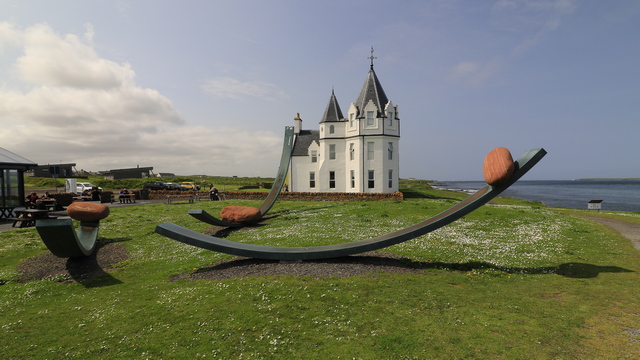
The Nomadic Bolders at John o'Groats
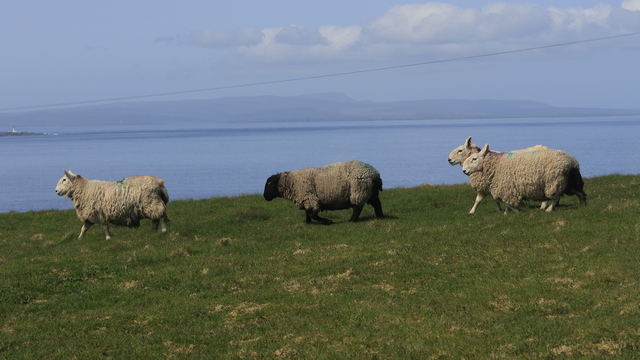
Sheep at Duncansby Head.
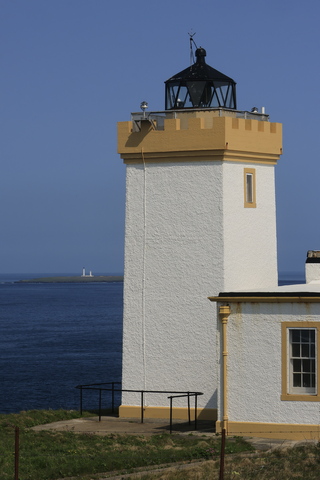
Finally a spot with really good visibility. We could see a lighthouse on a island several miles away. It's the two white lines on the horizon.
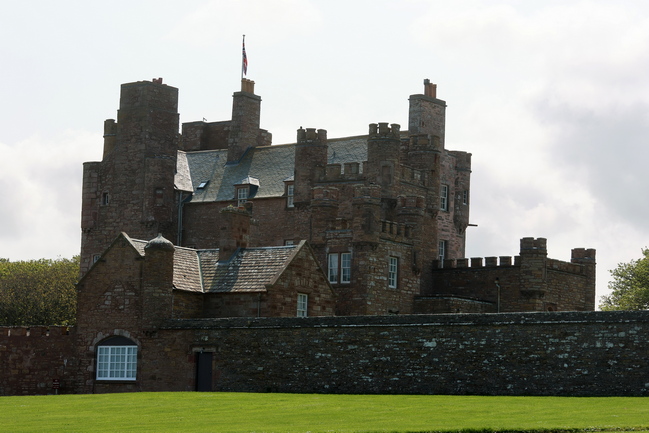
The Castle of Mey was built as a Z-plan castle between 1566 and 1572 by the fourth Earl of Caithness, it was bought from Captain Imbert-Terry by the Queen Mother in 1952. In 1996, when Her Majesty generously gifted it with an endowment to the Trust.
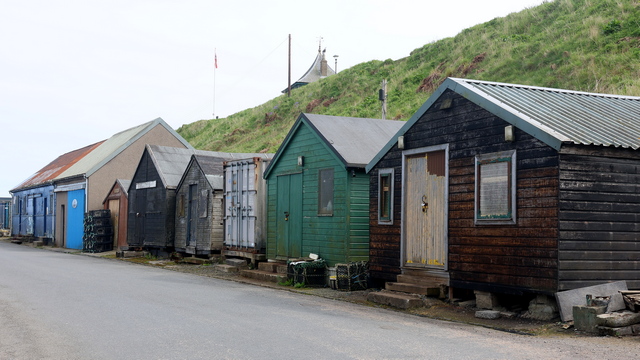
Sheds by the harbour in Wick.
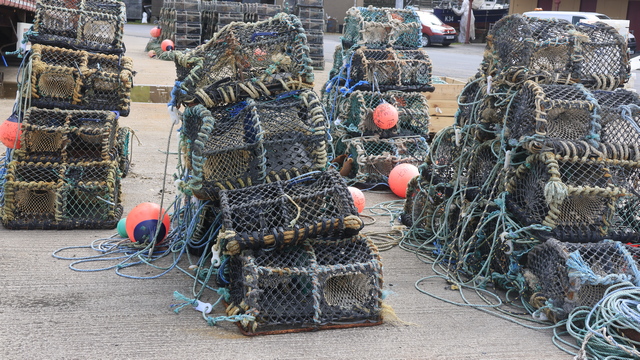
Langoustine trap. Langoustines, a relative of lobster, are smaller than lobster, however, growing in size to a maximum of only around 10 inches.
2023/05/20: Day 2 Exploring the Orkney Islands
Category: General
Posted by: The Agnew Family
I don't know if you noticed in the photos from yesterday, but there are essentially no trees on Orkney. When I say Orkney I mean Mainland and the islands that are joined to it by the Churchill causeways (more about them later). A few trees have been planted but in general the landscape is treeless. By 3500 BC, Orkney had seen a decline in forest cover. This was due to human activity and a deterioration in the climate. Orkney isn't flat but rather low gentle hills which are mainly grass but there are some moors. Beef cattle, dairy herds and sheep graze in the many green fields across the island.
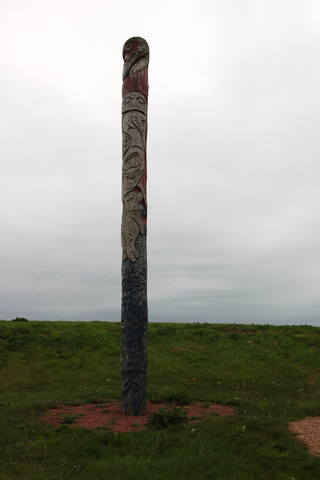
Yes, there really is a totem pole on Orkney. It was a joint project between local carvers and 4 Squamish Nation carvers in 2007.
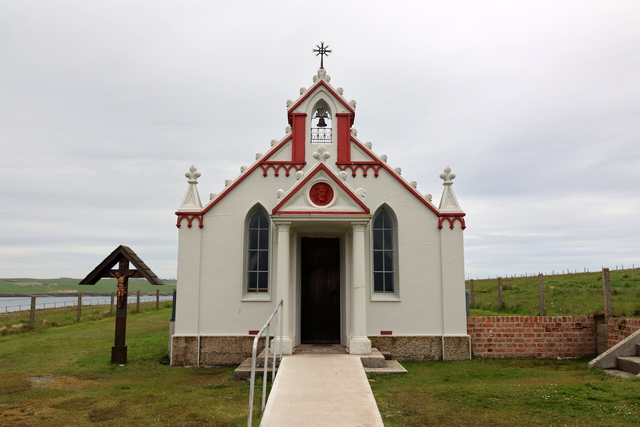
I find the story of the Italian Chapel to be fascinating. During WWI and WWII the British navy were based out of Scapa Flow (an area between several of the Orkney Islands). In October 1939 a German submarine sank the battleship HMS Royal Oak. Churchill decided that barriers needed to be built between several of the islands. Manpower was short but coincidentally at that time thousands of Italian soldiers fighting in North Africa were captured. Over 1,000 soldiers were brought to Orkney and under guise of bettering communications between the Orkney Islands, built the barriers. Following the request from the camp priest it was agreed that 2 Nissen huts would be joined together to provide a chapel. Among the Italians in Camp 60 was an artist, Domenico Chiocchetti, and he was given the task of transforming the two Nissen huts into a chapel. He was assisted by other tradesmen - in particular Giuseppe Palumbi, a blacksmith, and Domenico Buttapasta, a cement worker. This photo and the 3 following photos are the end result.
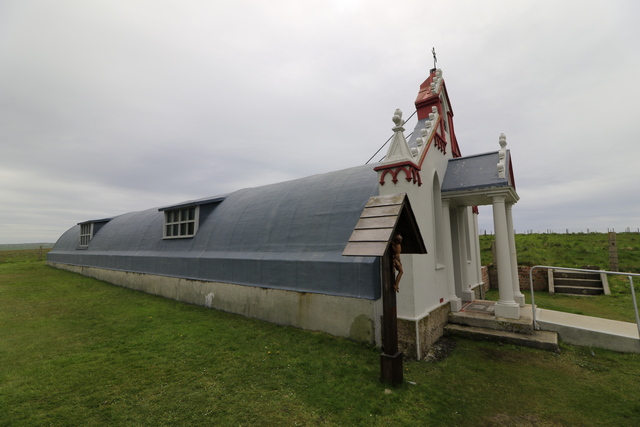
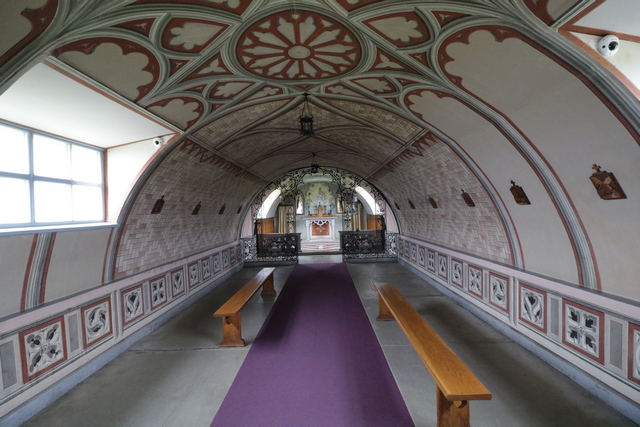
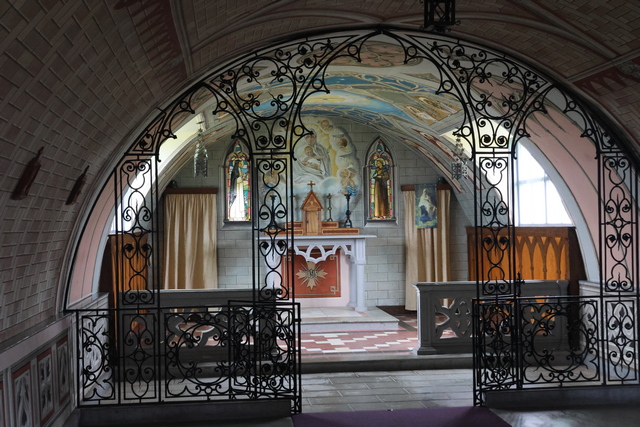
BTW the interior walls of the chapel are painted.
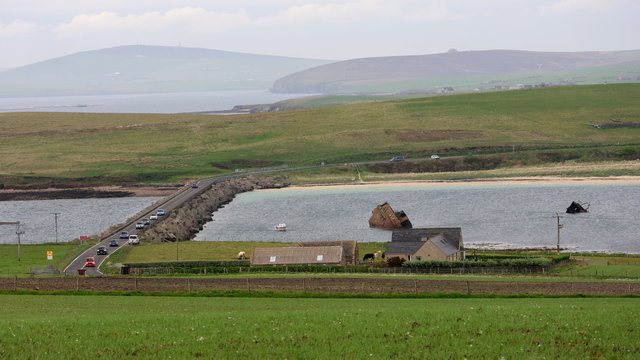
One of the 4 Churchill Barriers, a series of causeways linking South Ronaldsay to Orkney Mainland. Overhead cableways were set up, and 250,000 tons of rock dumped to form a base. The base of rocks was then topped by 66,000 concrete blocks, cut to 5 and 10-ton sizes. The 5-ton blocks were laid directly on the base, and the 10-ton blocks arranged randomly along the sloping sides, to break up wave patterns. Rock was quarried locally and the concrete was cast on Orkney and transported by railways to the site.
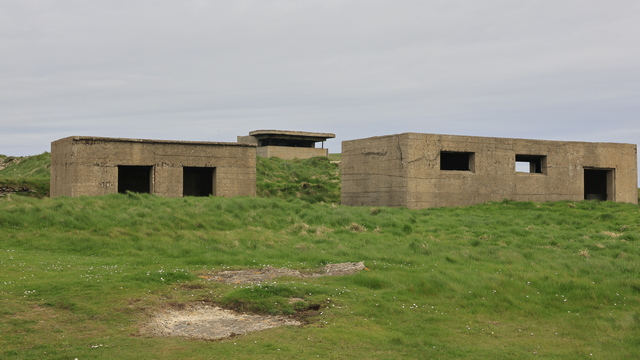
The remains of bunkers, gun mounts, etc. can be found on the islands linked by the Churchill barriers.
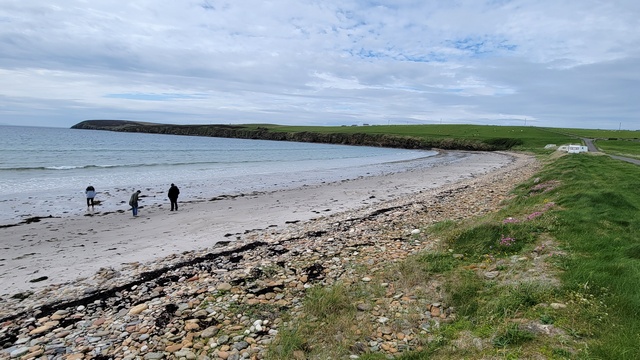
Sands of Wright ---- my maiden name is Wright so are these my sands?
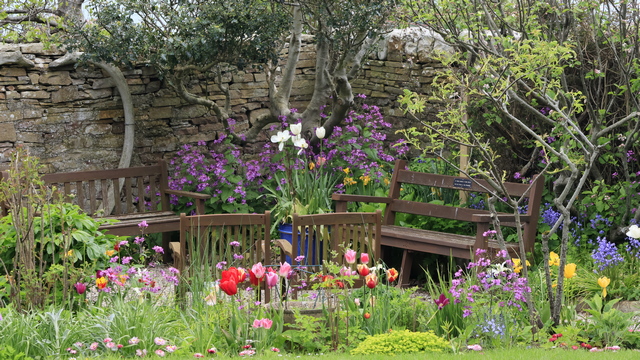
A beautiful community garden in St Margaret's Hope
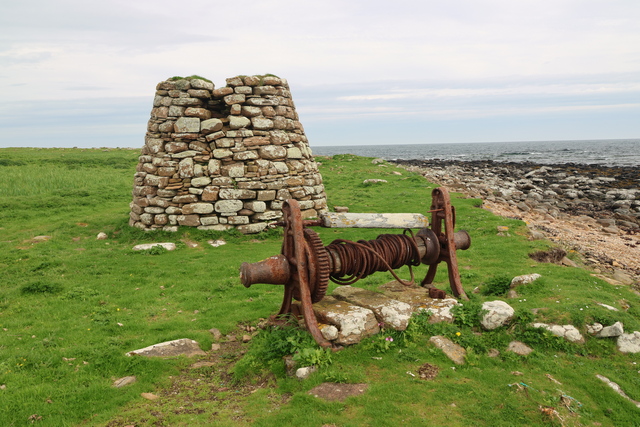
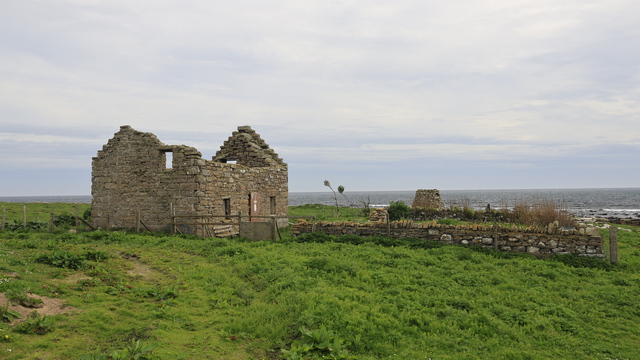
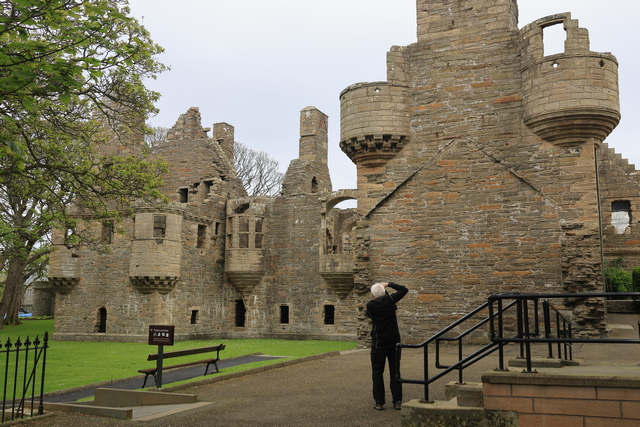
The Bishop's Palace, Kirkwall is a 12th-century palace built at the same time as the adjacent St Magnus Cathedral in the centre of Kirkwall. It housed the cathedral's first bishop, William the Old of the Norwegian Catholic church.
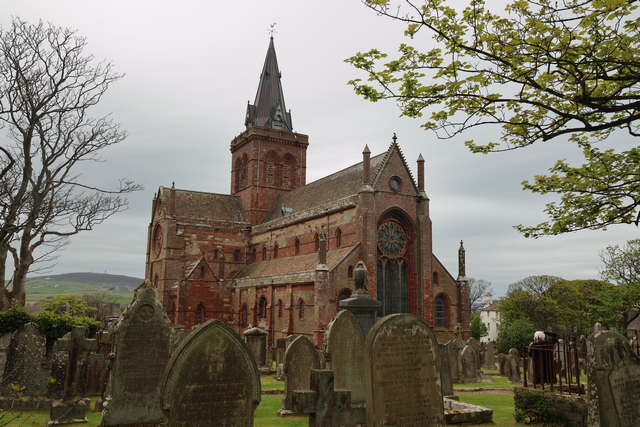
The back of St. Magnus Cathedral. The front of the church was crowded with people from a wedding.
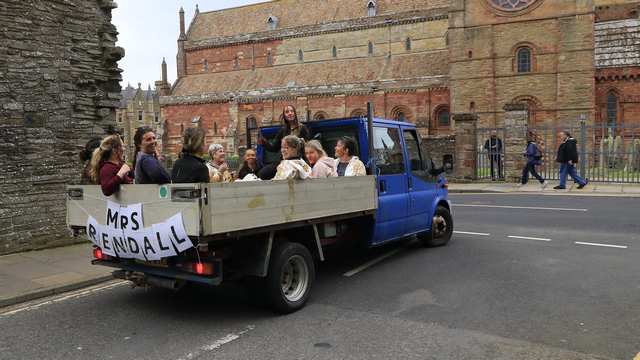
Ed and I are easily identifiable as tourists. These young ladies asked where we were from and we asked what they were doing? They told us the young woman sitting hirer than the rest was getting married in 6 weeks. I guess one of the things to do is get covered in goop, ride around in the back of a pickup truck making lots of noise. We saw a 2nd truck with a group of guys in it doing a similar thing.

Yes, there really is a totem pole on Orkney. It was a joint project between local carvers and 4 Squamish Nation carvers in 2007.

I find the story of the Italian Chapel to be fascinating. During WWI and WWII the British navy were based out of Scapa Flow (an area between several of the Orkney Islands). In October 1939 a German submarine sank the battleship HMS Royal Oak. Churchill decided that barriers needed to be built between several of the islands. Manpower was short but coincidentally at that time thousands of Italian soldiers fighting in North Africa were captured. Over 1,000 soldiers were brought to Orkney and under guise of bettering communications between the Orkney Islands, built the barriers. Following the request from the camp priest it was agreed that 2 Nissen huts would be joined together to provide a chapel. Among the Italians in Camp 60 was an artist, Domenico Chiocchetti, and he was given the task of transforming the two Nissen huts into a chapel. He was assisted by other tradesmen - in particular Giuseppe Palumbi, a blacksmith, and Domenico Buttapasta, a cement worker. This photo and the 3 following photos are the end result.



BTW the interior walls of the chapel are painted.

One of the 4 Churchill Barriers, a series of causeways linking South Ronaldsay to Orkney Mainland. Overhead cableways were set up, and 250,000 tons of rock dumped to form a base. The base of rocks was then topped by 66,000 concrete blocks, cut to 5 and 10-ton sizes. The 5-ton blocks were laid directly on the base, and the 10-ton blocks arranged randomly along the sloping sides, to break up wave patterns. Rock was quarried locally and the concrete was cast on Orkney and transported by railways to the site.

The remains of bunkers, gun mounts, etc. can be found on the islands linked by the Churchill barriers.

Sands of Wright ---- my maiden name is Wright so are these my sands?

A beautiful community garden in St Margaret's Hope



The Bishop's Palace, Kirkwall is a 12th-century palace built at the same time as the adjacent St Magnus Cathedral in the centre of Kirkwall. It housed the cathedral's first bishop, William the Old of the Norwegian Catholic church.

The back of St. Magnus Cathedral. The front of the church was crowded with people from a wedding.

Ed and I are easily identifiable as tourists. These young ladies asked where we were from and we asked what they were doing? They told us the young woman sitting hirer than the rest was getting married in 6 weeks. I guess one of the things to do is get covered in goop, ride around in the back of a pickup truck making lots of noise. We saw a 2nd truck with a group of guys in it doing a similar thing.
2023/05/19: Day 1 Exploring the Orkney Islands
Category: General
Posted by: The Agnew Family
We took the ferry from Scrabster to Stronmess on Mainland, the largest of the Orkney Islands. We spent the day visiting several ancient sites as well as the tidal island of Brough of Birsay.
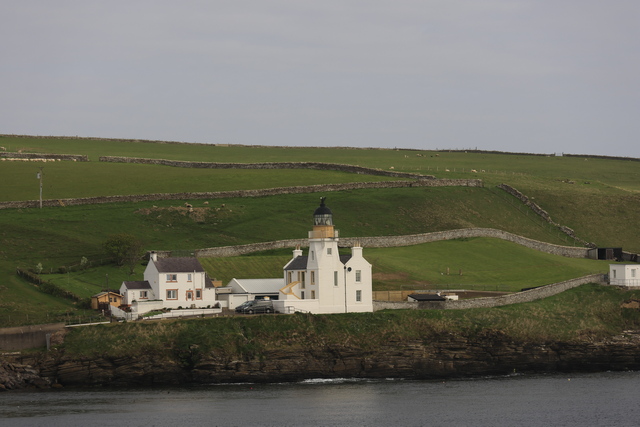
The lighthouse in Scrabster. Goodbye mainland.
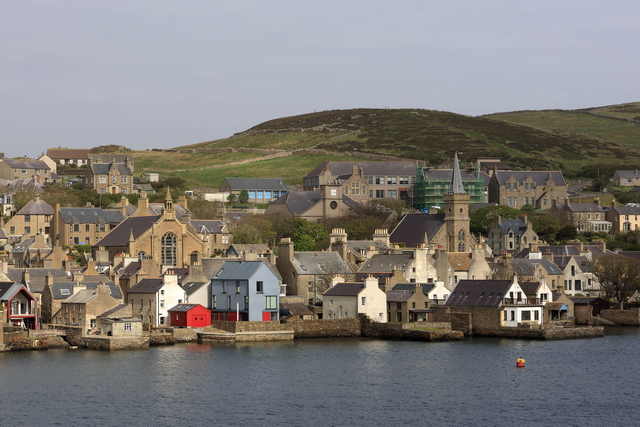
The village of Stromness Orkney. Hello Mainland --- that's the name of this island in Orkney.
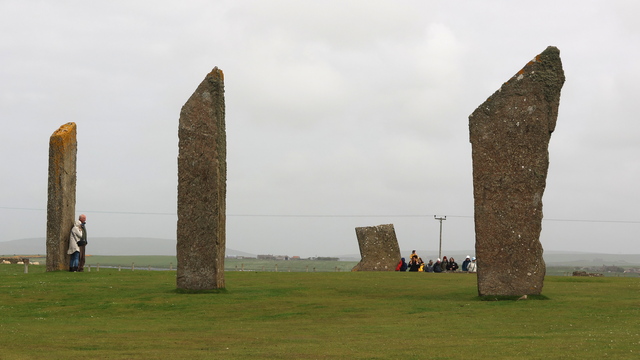
The Standing Stones of Sterness are over 5000 years old and may be the earliest henge monument in the British Isles. The enormous Stones of Stenness are all that remains of a great stone circle on an ancient ceremonial site.
The Stones of Stenness today consist of four upright stones up to 6m in height in a circle that originally held 12 stones. The focus of the interior was a large hearth. The stones were encircled by a large ditch and bank, the form of which has been lost over time by ploughing. Thanks Historic Environment Scotland. I'll be using you a lot today.
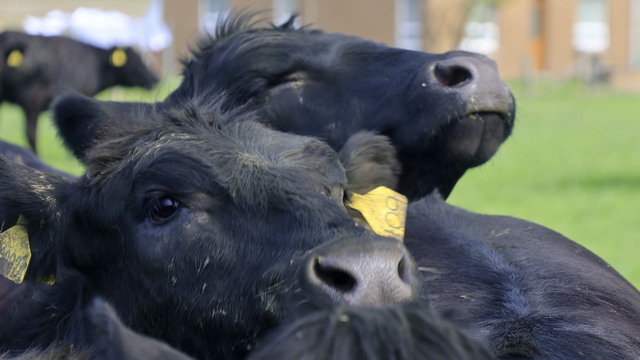
Cows greeting us at the Maeshowe visitors centre.
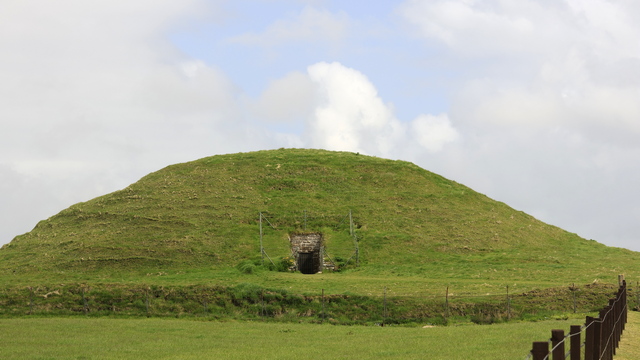
Maeshowe Chambered Cairn. Maeshowe, a monumental chambered tomb, is the finest Neolithic building to survive in north-west Europe. Built around 5,000 years ago, it is a masterpiece of Neolithic design and construction – not least because of its use of massive stones.
Creating such a huge building must have been a major challenge for our remote ancestors, working without metal tools or powered machinery. It also clearly shows a tremendous social commitment.
From the outside, Maeshowe looks just like a large grassy mound. (The word ‘howe’ comes from the Old Norse for ‘hill’.) To appreciate its size and significance, visitors must enter Maeshowe, stooping to walk its long passageway to reach the central, stone-built chamber.
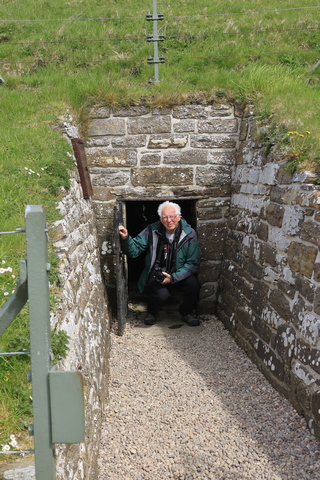
Ed exitting Maeshowe.
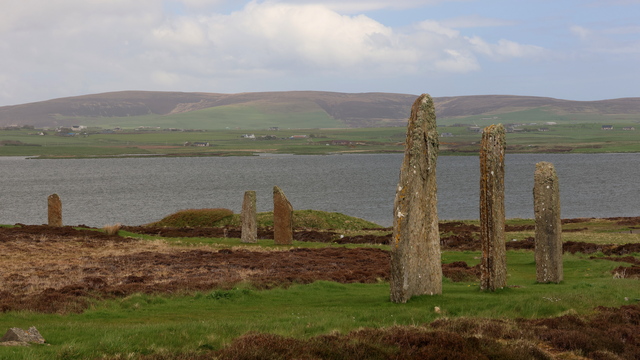
The Ring of Brodgar Stone Circle and Henge is an enormous ceremonial site dating back to the 3rd millennium BC. The Ring of Brodgar comprises:
A massive stone circle, originally consisting of 60 stones – 36 survive today
At least 13 prehistoric burial mounds
A large rock-cut ditch surrounding the stone circle
The age of this site is unknow as it hasn't been excavated. The three sites I've mention so far very close. A 4th site, the Ness of Brodgar is only open for a short time in the summer. The Ness of Brodgar site has been under excavation since 2004, revealing a massive complex of monumental Neolithic buildings dating from the centuries around 3000BC.
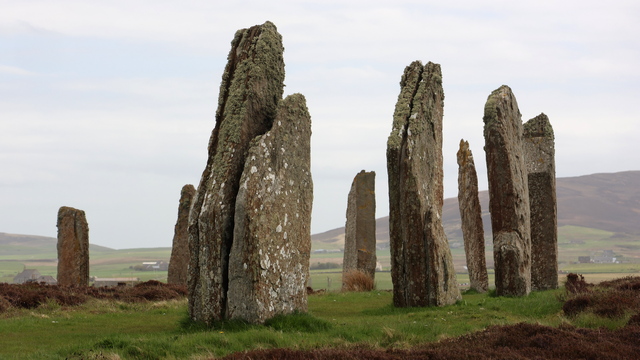
Ring of Brodgar
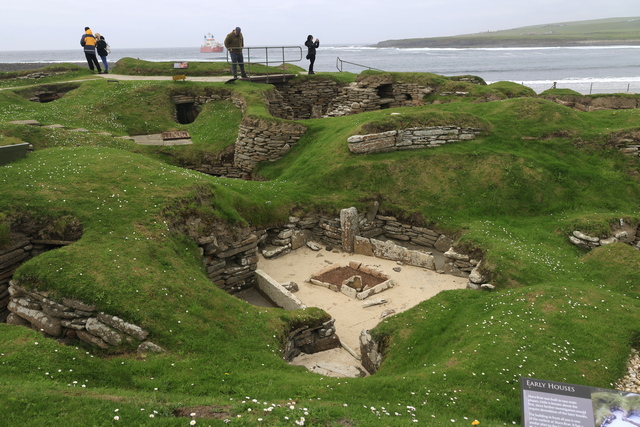
Skara Brea was discovered in the winter of 1850 when a storm ripped the grass and dirt of a large mound revealing buildings. Skara Brea is over 5000 years old.
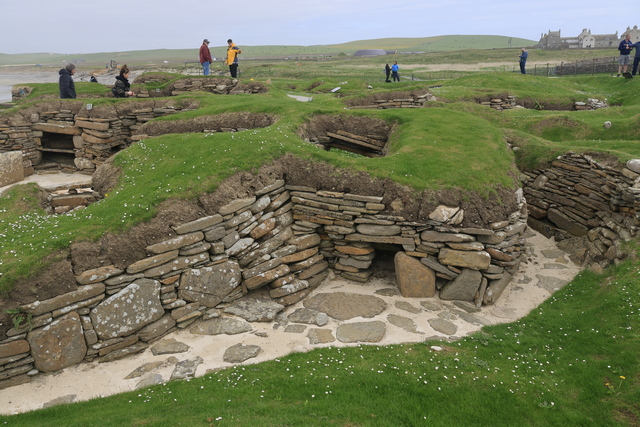
Skara Brae is remarkable because of its age, and even more so for the quality of its preservation. Its structures survive in impressive condition – as does, incredibly, the furniture in the village houses. Skara Brae was originally an inland village beside a freshwater loch. All of the houses were:
well built of flat stone slabs
set into large mounds of midden
linked by covered passageways
Each house has a single room, its floor space roughly 40sq m.
‘Fitted’ stone furniture in each room includes:
a ‘dresser’ – perhaps to store and display special objects
two box-beds
a central hearth
small tanks set into the floor – possibly for preparing fish bait
A larger structure at one end of the village has a special hearth and no box-beds, so may have been a workshop.
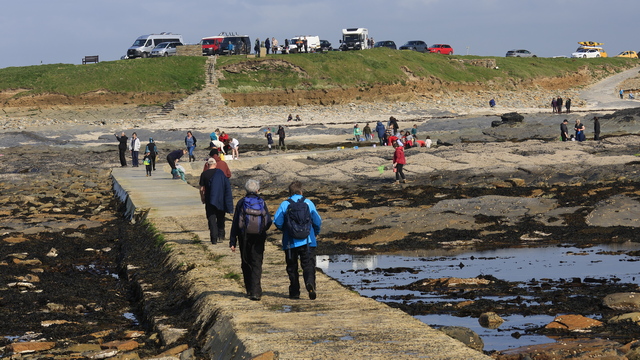
The Brough of Birsay is a tidal island, which means you can walk out to it during low tide. It's a popular place. I think a lot of the people were locals as there were lots of kids in wellies with nets looking for crabs and other interesting things.
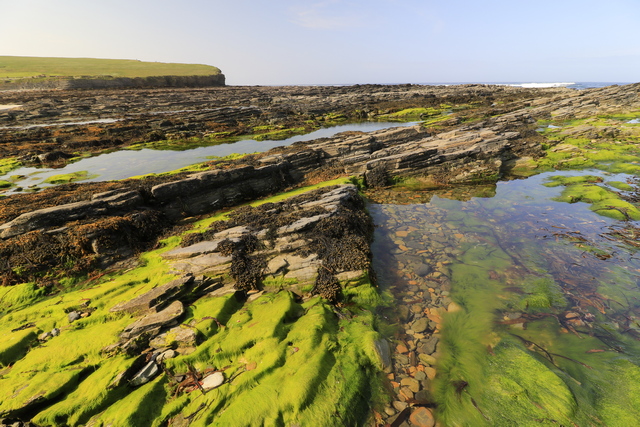
The rocks after the tide went out.
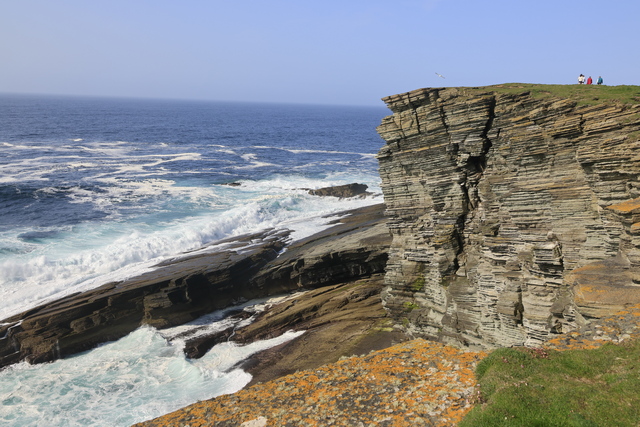
The rocky coast at the far end of the Brough of Birsay ear the lighthouse.
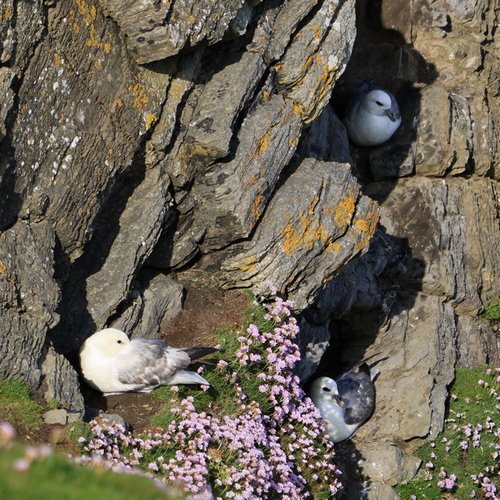
Nesting birds.
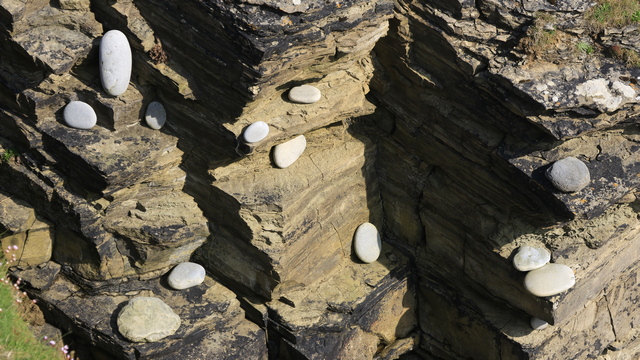
Looking down, these stones are sitting on rock ledges. The waves move these large stones around.
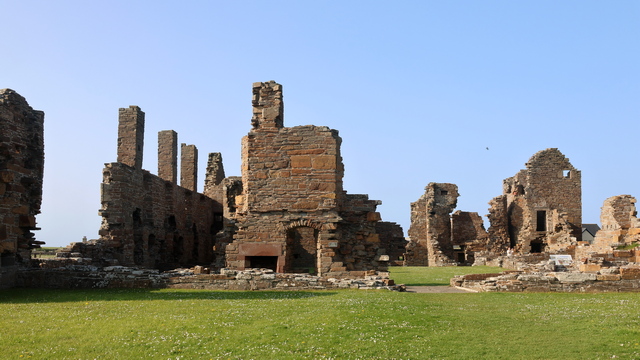
Earl's Palace, Birsay. Robert Stewart was the illegitimate son of James V by his mistress Euphemia Elphinstone and half-brother to Mary Queen of Scots. He was granted the royal and earldom estates of Orkney and Shetland in 1564, but not the title itself.
Robert Stewart moved north and between 1569 and 1574 he built the Earl’s Palace at Birsay at the north of the Orkney mainland. His nephew, James VI, created him Earl of Orkney, Lord of Shetland and Knight of Birsay in 1581.

The lighthouse in Scrabster. Goodbye mainland.

The village of Stromness Orkney. Hello Mainland --- that's the name of this island in Orkney.

The Standing Stones of Sterness are over 5000 years old and may be the earliest henge monument in the British Isles. The enormous Stones of Stenness are all that remains of a great stone circle on an ancient ceremonial site.
The Stones of Stenness today consist of four upright stones up to 6m in height in a circle that originally held 12 stones. The focus of the interior was a large hearth. The stones were encircled by a large ditch and bank, the form of which has been lost over time by ploughing. Thanks Historic Environment Scotland. I'll be using you a lot today.

Cows greeting us at the Maeshowe visitors centre.

Maeshowe Chambered Cairn. Maeshowe, a monumental chambered tomb, is the finest Neolithic building to survive in north-west Europe. Built around 5,000 years ago, it is a masterpiece of Neolithic design and construction – not least because of its use of massive stones.
Creating such a huge building must have been a major challenge for our remote ancestors, working without metal tools or powered machinery. It also clearly shows a tremendous social commitment.
From the outside, Maeshowe looks just like a large grassy mound. (The word ‘howe’ comes from the Old Norse for ‘hill’.) To appreciate its size and significance, visitors must enter Maeshowe, stooping to walk its long passageway to reach the central, stone-built chamber.

Ed exitting Maeshowe.

The Ring of Brodgar Stone Circle and Henge is an enormous ceremonial site dating back to the 3rd millennium BC. The Ring of Brodgar comprises:
A massive stone circle, originally consisting of 60 stones – 36 survive today
At least 13 prehistoric burial mounds
A large rock-cut ditch surrounding the stone circle
The age of this site is unknow as it hasn't been excavated. The three sites I've mention so far very close. A 4th site, the Ness of Brodgar is only open for a short time in the summer. The Ness of Brodgar site has been under excavation since 2004, revealing a massive complex of monumental Neolithic buildings dating from the centuries around 3000BC.

Ring of Brodgar

Skara Brea was discovered in the winter of 1850 when a storm ripped the grass and dirt of a large mound revealing buildings. Skara Brea is over 5000 years old.

Skara Brae is remarkable because of its age, and even more so for the quality of its preservation. Its structures survive in impressive condition – as does, incredibly, the furniture in the village houses. Skara Brae was originally an inland village beside a freshwater loch. All of the houses were:
well built of flat stone slabs
set into large mounds of midden
linked by covered passageways
Each house has a single room, its floor space roughly 40sq m.
‘Fitted’ stone furniture in each room includes:
a ‘dresser’ – perhaps to store and display special objects
two box-beds
a central hearth
small tanks set into the floor – possibly for preparing fish bait
A larger structure at one end of the village has a special hearth and no box-beds, so may have been a workshop.

The Brough of Birsay is a tidal island, which means you can walk out to it during low tide. It's a popular place. I think a lot of the people were locals as there were lots of kids in wellies with nets looking for crabs and other interesting things.

The rocks after the tide went out.

The rocky coast at the far end of the Brough of Birsay ear the lighthouse.

Nesting birds.

Looking down, these stones are sitting on rock ledges. The waves move these large stones around.

Earl's Palace, Birsay. Robert Stewart was the illegitimate son of James V by his mistress Euphemia Elphinstone and half-brother to Mary Queen of Scots. He was granted the royal and earldom estates of Orkney and Shetland in 1564, but not the title itself.
Robert Stewart moved north and between 1569 and 1574 he built the Earl’s Palace at Birsay at the north of the Orkney mainland. His nephew, James VI, created him Earl of Orkney, Lord of Shetland and Knight of Birsay in 1581.
2023/05/18: Kinlochbervie to Scrabster
Category: General
Posted by: The Agnew Family
Today we're driving a bit north then across the top of Scotland.
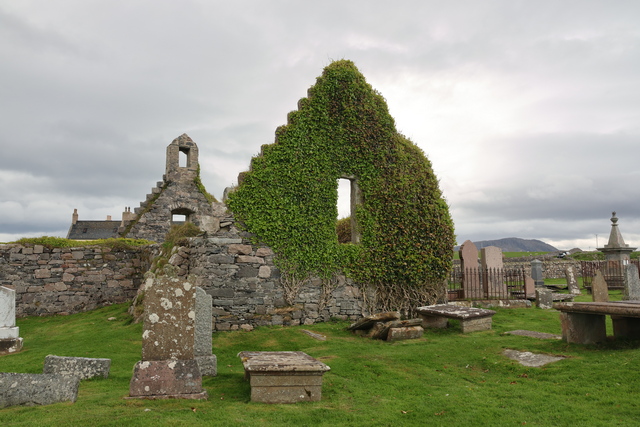
The ruins of the Balnakeil Church. It was established in the 1600s and abandoned in the 19th century when the current church was built.
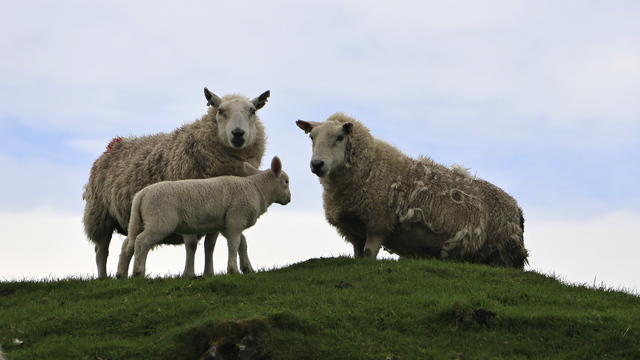
Today's sheep picture.
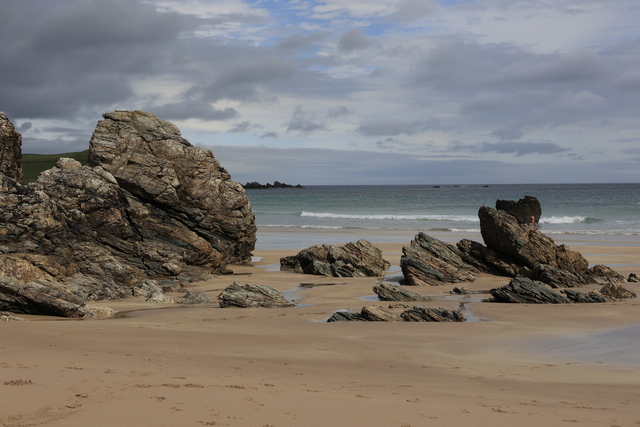
Rock on yet another beach. Durness beach.
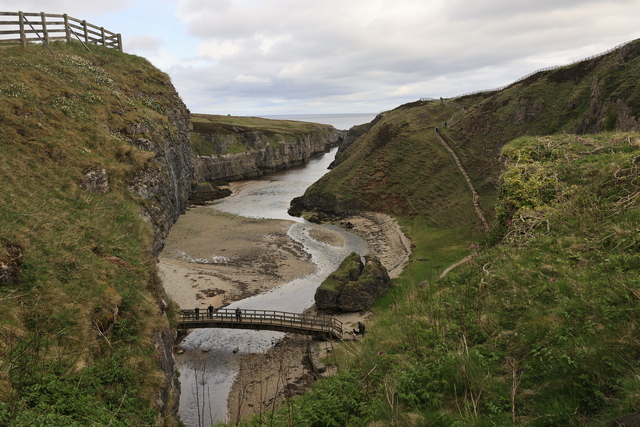
Looking down to the entrance of Smoo cave.
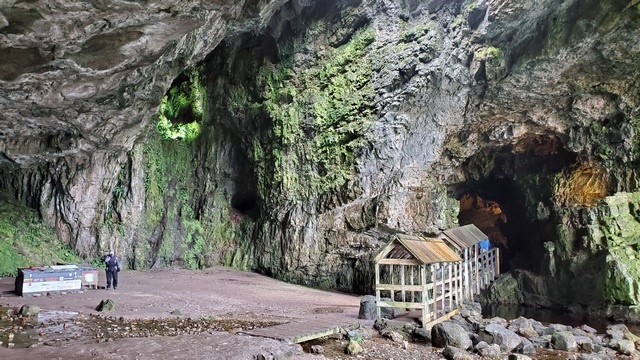
Smoo Cave is a large combined sea cave and freshwater cave.
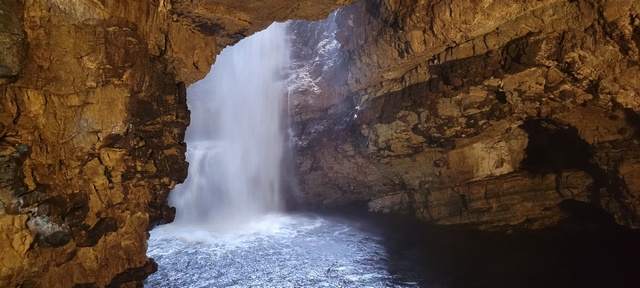
A waterfall is in the 2nd chamber.
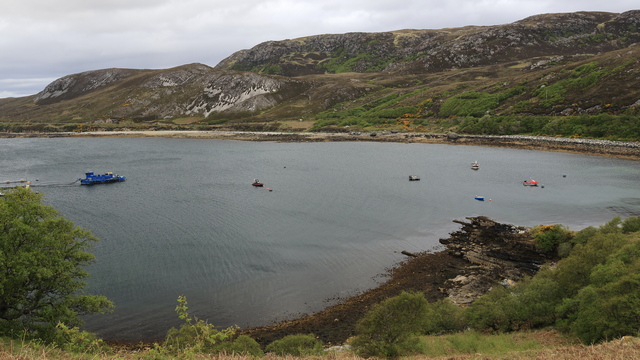
Along the road.
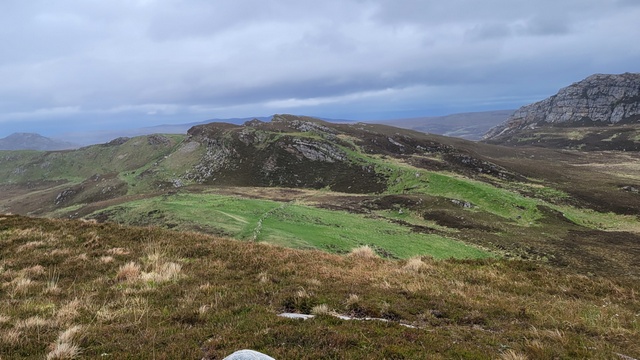
We climbed another hill to find another cache.
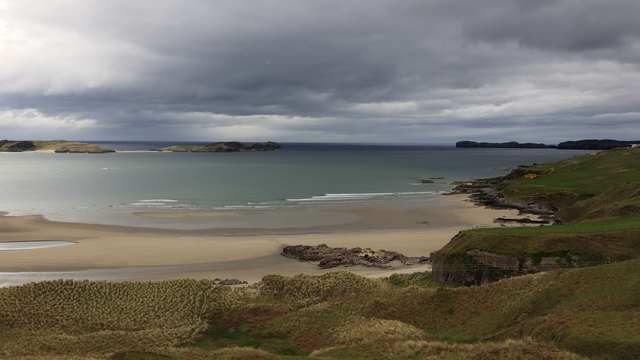
Coldbackie beach.
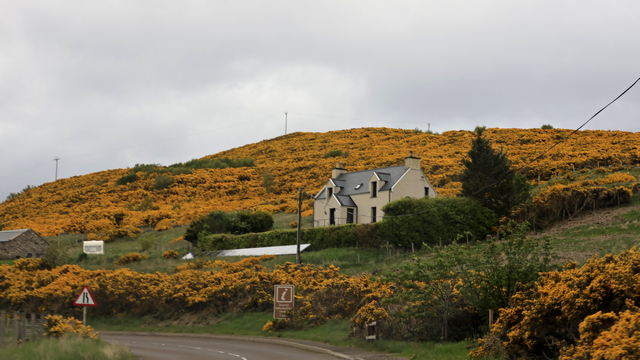
Needed some colour again today.
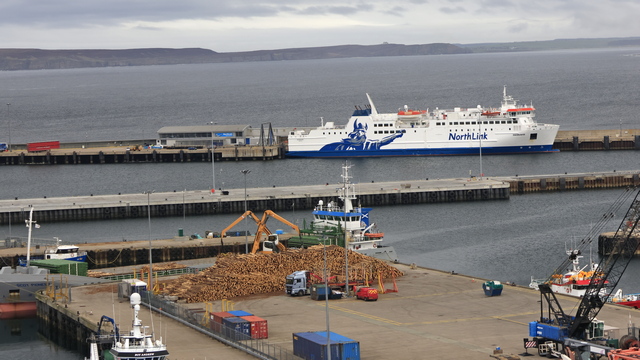
In Scrabster our airbnb was high on the cliff and we got a great view of the harbour from the sitting area attached to our room. We're taking that ferry to Orkney tomorrow morning.
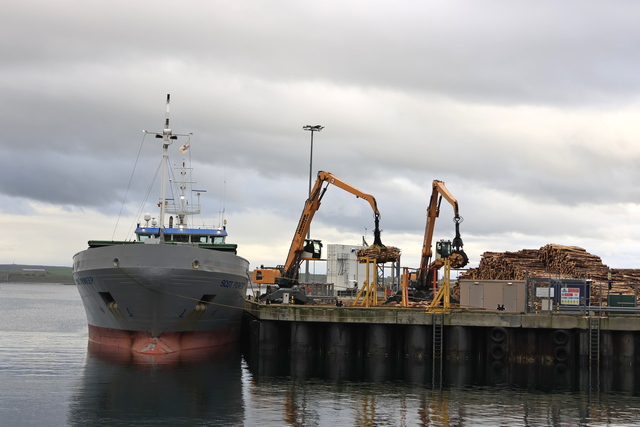
We walked into town for dinner. We watched a boat being load with wood while we ate.

The ruins of the Balnakeil Church. It was established in the 1600s and abandoned in the 19th century when the current church was built.

Today's sheep picture.

Rock on yet another beach. Durness beach.

Looking down to the entrance of Smoo cave.

Smoo Cave is a large combined sea cave and freshwater cave.

A waterfall is in the 2nd chamber.

Along the road.

We climbed another hill to find another cache.

Coldbackie beach.

Needed some colour again today.

In Scrabster our airbnb was high on the cliff and we got a great view of the harbour from the sitting area attached to our room. We're taking that ferry to Orkney tomorrow morning.

We walked into town for dinner. We watched a boat being load with wood while we ate.
2023/05/17: Achmore back to Ullapool and onto Kinlochbervie
Category: General
Posted by: The Agnew Family
It took us about 1.5 hours to drive back to Ullapool. The first part of the drive was 1 lane roads which are slower as you either slow way down or stop when you meet a car going the opposite direction. When we hit the two lane roads we made good time. The scenery was nice but nothing like what we saw yesterday. In Ullapool we got back on the NC500 and started driving north.
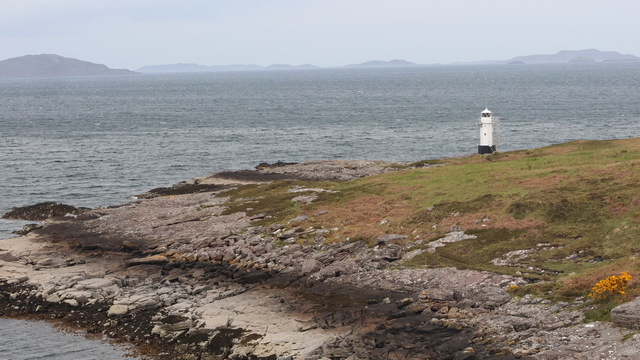
First stop was the Rhue lighthouse. It's not a big lighthouse and looks even smaller from a distance. We saw this lighthouse as the ferry entered Ullapool harbour yesterday.
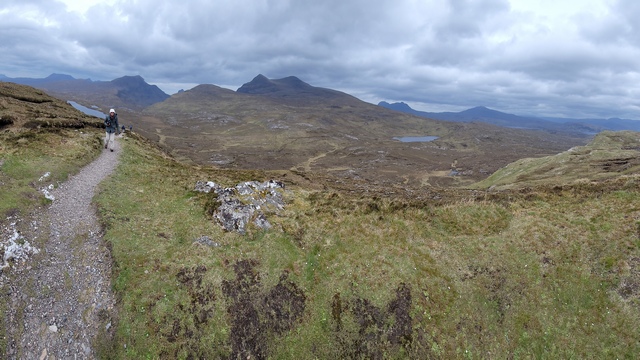
We stopped at the Knockan Crag National Nature Reserve in the North West Highlands Geopark. The low cliff of Knockan exposes rocks that set the scientific world ablaze in the 19th century, with the discovery that a slice of old rock sits on top of much younger ones. Rocks here are 500 million years old. The crag was formed by the Moine Thrust, the force of two continents crashing together. That's me walking on the trail --- the high wind make it a little chilly.
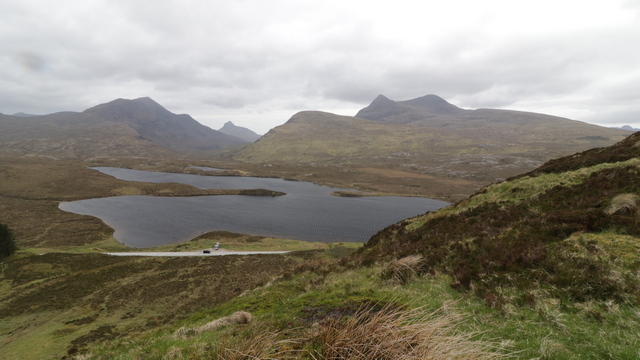
Looking down at one of the lakes you could see from the trail.
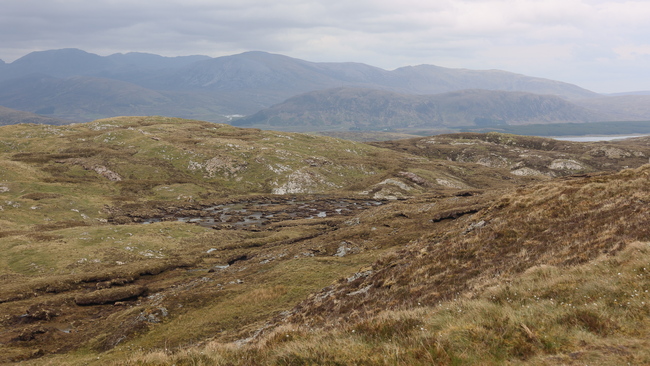
A view from near the top.
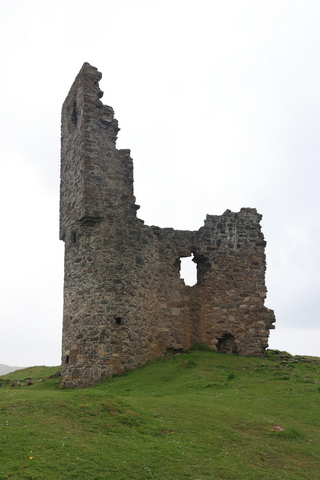
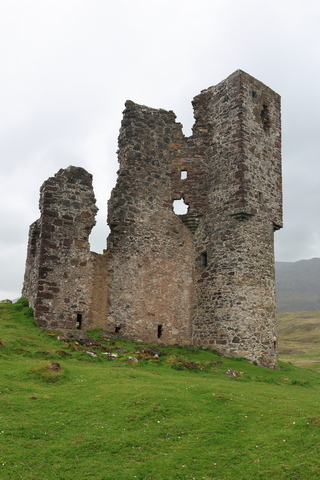
Two views of ruins of Ardvreck Castle, standing on a rocky promontory in Loch Assynt. The structure dates from about 1490 and is associated with the then landowners, the Macleods of Assynt. Thanks Wikipedia.
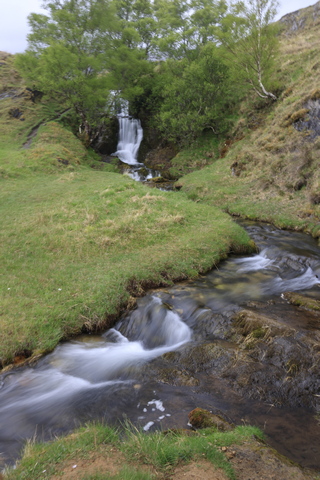
A little water falls across the road from the castle parking.
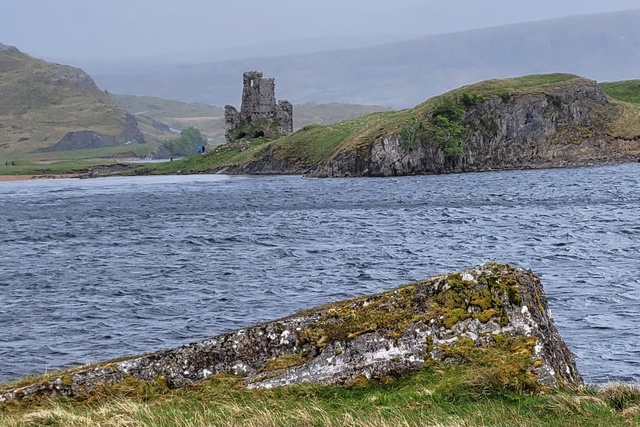
Ed got tired of wiping rain drops off the camera lens before you could take a picture so he switched to the cell phone. The cell phone does a great job in adverse weather conditions.
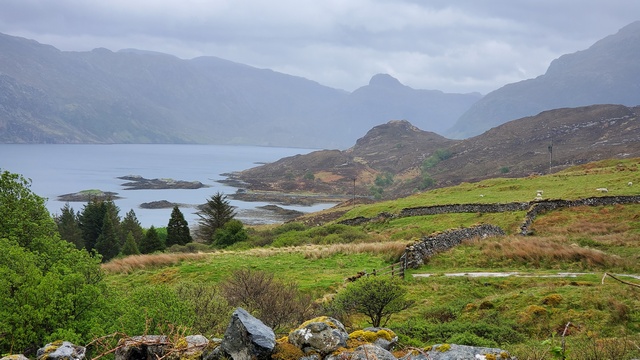
If the view looked pretty and there was parking we'd stop and take a photo.
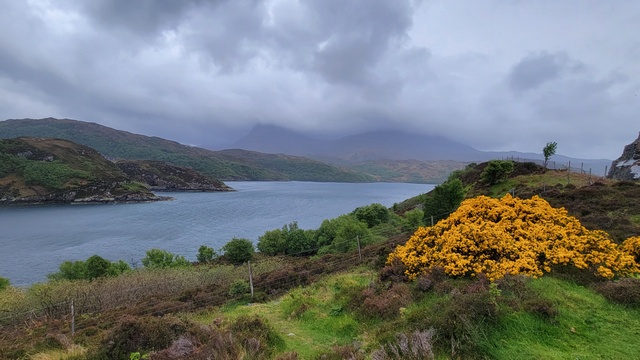
Near Kylesku Bridge.
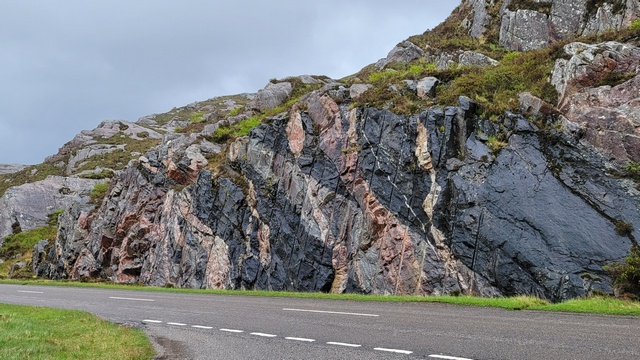
I think this rock is beautiful. The grey rock, Lewisian Gneiss formed deep inside the earth's crust. The rocks got so hot down there that they almost melted. Later on, other molten rock forced it's way through the gneiss and eventually hardened. The black rock (dolerite) and the pink (granite) have penetrated the grey gneiss.

First stop was the Rhue lighthouse. It's not a big lighthouse and looks even smaller from a distance. We saw this lighthouse as the ferry entered Ullapool harbour yesterday.

We stopped at the Knockan Crag National Nature Reserve in the North West Highlands Geopark. The low cliff of Knockan exposes rocks that set the scientific world ablaze in the 19th century, with the discovery that a slice of old rock sits on top of much younger ones. Rocks here are 500 million years old. The crag was formed by the Moine Thrust, the force of two continents crashing together. That's me walking on the trail --- the high wind make it a little chilly.

Looking down at one of the lakes you could see from the trail.

A view from near the top.


Two views of ruins of Ardvreck Castle, standing on a rocky promontory in Loch Assynt. The structure dates from about 1490 and is associated with the then landowners, the Macleods of Assynt. Thanks Wikipedia.

A little water falls across the road from the castle parking.

Ed got tired of wiping rain drops off the camera lens before you could take a picture so he switched to the cell phone. The cell phone does a great job in adverse weather conditions.

If the view looked pretty and there was parking we'd stop and take a photo.

Near Kylesku Bridge.

I think this rock is beautiful. The grey rock, Lewisian Gneiss formed deep inside the earth's crust. The rocks got so hot down there that they almost melted. Later on, other molten rock forced it's way through the gneiss and eventually hardened. The black rock (dolerite) and the pink (granite) have penetrated the grey gneiss.
2023/05/16: Ullapool to Achmore (almost back to Skye)
Category: General
Posted by: The Agnew Family
We're starting what is called the NC500 (Northern Coast 500) today. The route actually starts in Inverness but we're skipping the part from Inverness to Skye. I read that the section between Ullapool and Skye is amazing so we decided it was worth backtracking. Tomorrow we'll take a shorter, easier route back to Ullapool and continue North. In case you're wondering, yes the article was correct. The scenery was amazing, the roads very interesting but few parking spots so a lot of photos through the windshield photos.
Early this morning it was pouring rain, luckily it started to let up as we were heading out and got progressively better as the date went on. In retrospect we should have taken 2 days to do this drive as there were several cute towns that could have been explored and lots to trails to walk.
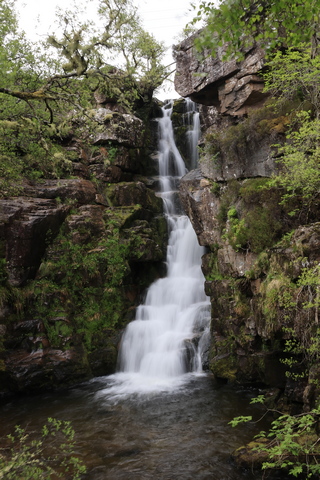
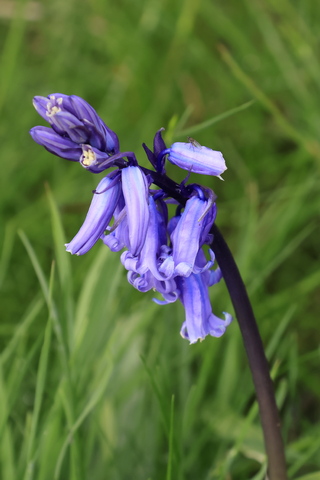
Ardessie Falls, right by the side of the road and one of the few wild flowers we've seen.
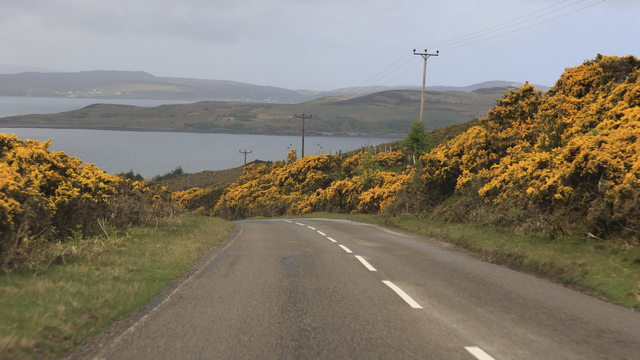
I think I've taken a hundred photos with the common grose.
It brightens up a dull day. Today there were a lot of bushes along the roads.
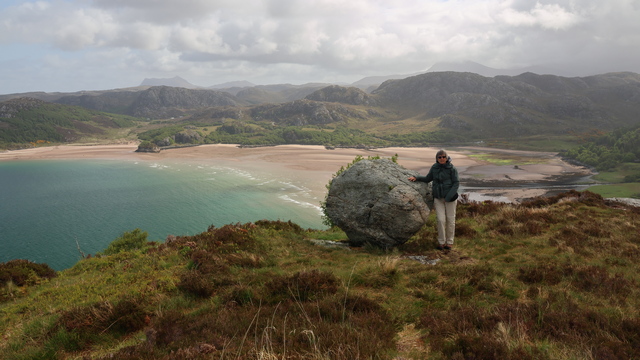
To find a geocache we climbed a hill. Not only did Ed find the geocache we got a wonderful view of Wester Ross. Sometimes the geocaches take you somewhere amazing.
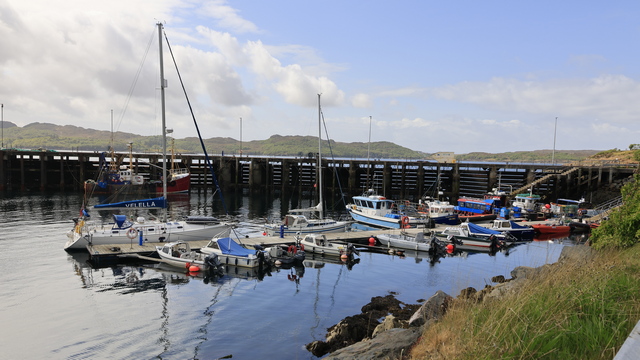
Gairloch has a cute harbour.
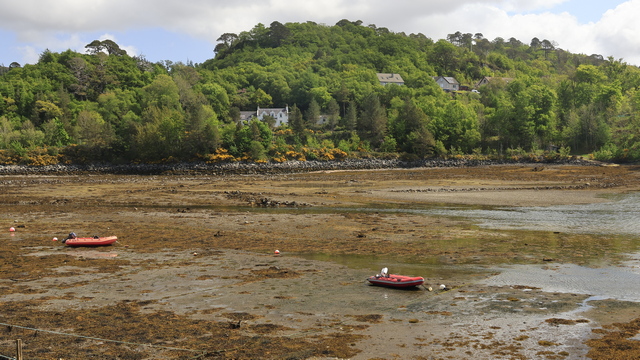
I hope no one needs the dinghies soon. They won't be going anywhere till the tide comes back in.
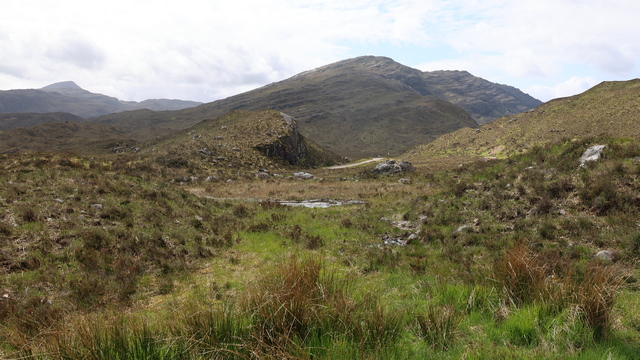
There's a number of hiking trails in the Torridon Hills, so there's a parking lot. We stopped, walked round, looked at a deer resting just off of the parking lot and took some photos.
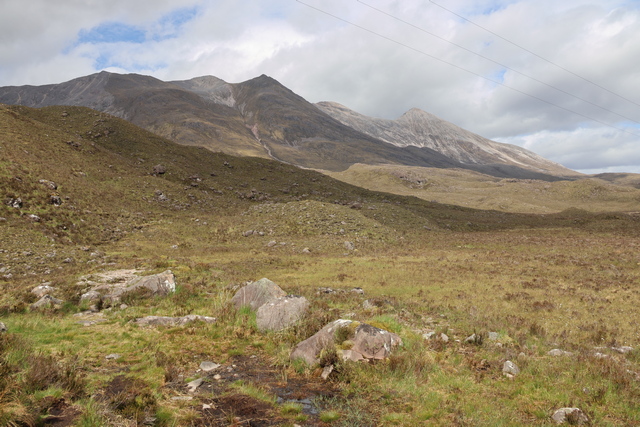
The Torridon Hills.
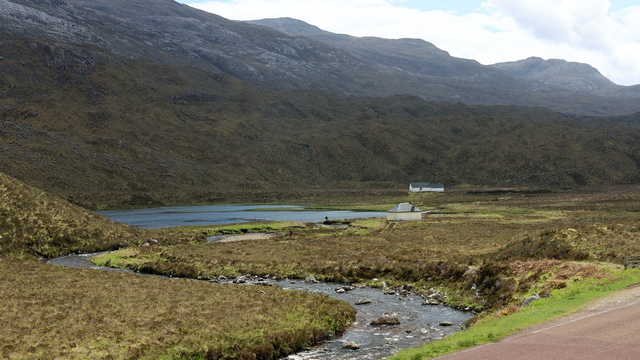
Across the road from the parking lot.
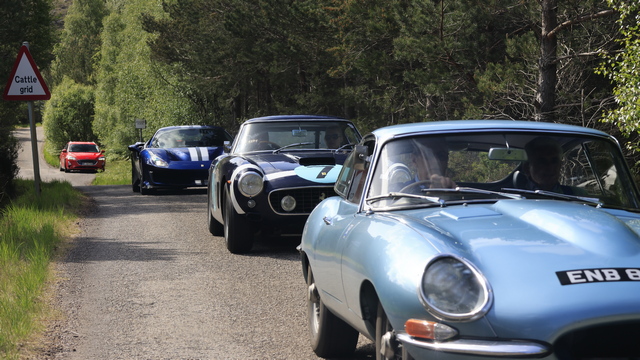
I saw more Ferraris today then I think I've seen in my lifetime (excluding TV of course). A group of at least 20 maybe even 30, mostly expensive, sports cars were going the opposite way on the road so they all passed us. I got a photo of 3 of them when we were in a passing spot and they were passing.
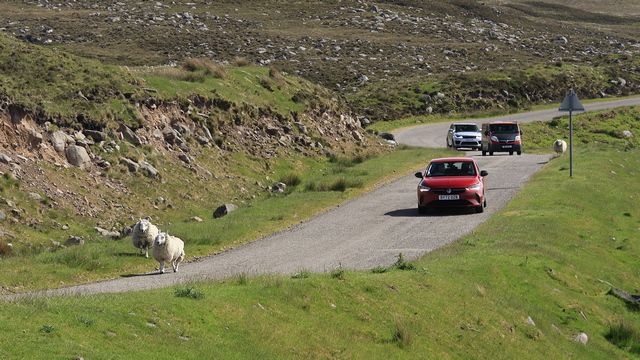
Some traffic moves slows even when they're going as fast as they can.
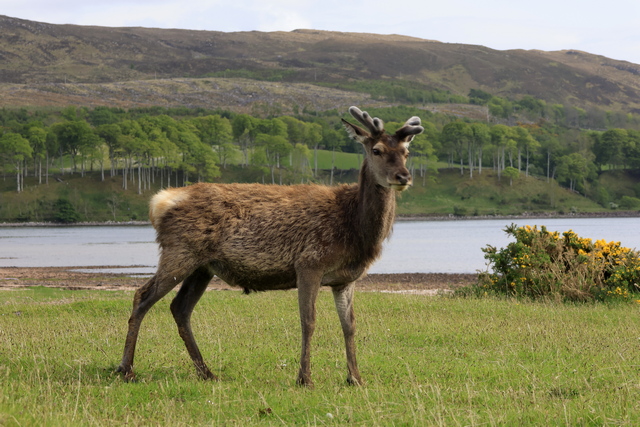
Just outside of Applecross we came across a number of wild deer grazing. This one posed nicely for us.
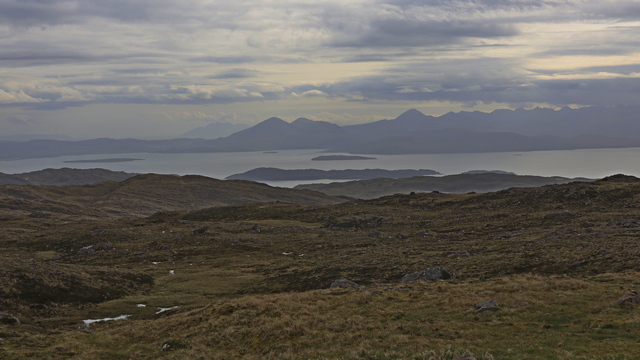
This is at the highest point on the Bealach Na Ba Pass or the road to Applecross. The road is 9.1 km long and the highest point is at 626m. The highest grade is 20% (which is steep) and the average grade is 7%. 626m really isn't that high but when you drive up it on a single lane road that is very twisty with the only armco barriers being near the top it's a little scary (well for me especially when I'm on the edge side). It get's even a bit scarier when a car is coming the other way and you have to pass. I asked Ed what he considered the worse road we've driven on the trip so far. He found all the blind hills that had unknown turns after them on the rocky side of Harris tiring to drive he said the pass was worse.
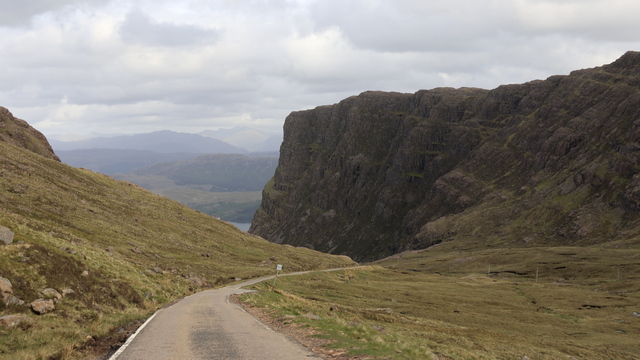
Early this morning it was pouring rain, luckily it started to let up as we were heading out and got progressively better as the date went on. In retrospect we should have taken 2 days to do this drive as there were several cute towns that could have been explored and lots to trails to walk.


Ardessie Falls, right by the side of the road and one of the few wild flowers we've seen.

I think I've taken a hundred photos with the common grose.
It brightens up a dull day. Today there were a lot of bushes along the roads.

To find a geocache we climbed a hill. Not only did Ed find the geocache we got a wonderful view of Wester Ross. Sometimes the geocaches take you somewhere amazing.

Gairloch has a cute harbour.

I hope no one needs the dinghies soon. They won't be going anywhere till the tide comes back in.

There's a number of hiking trails in the Torridon Hills, so there's a parking lot. We stopped, walked round, looked at a deer resting just off of the parking lot and took some photos.

The Torridon Hills.

Across the road from the parking lot.

I saw more Ferraris today then I think I've seen in my lifetime (excluding TV of course). A group of at least 20 maybe even 30, mostly expensive, sports cars were going the opposite way on the road so they all passed us. I got a photo of 3 of them when we were in a passing spot and they were passing.

Some traffic moves slows even when they're going as fast as they can.

Just outside of Applecross we came across a number of wild deer grazing. This one posed nicely for us.

This is at the highest point on the Bealach Na Ba Pass or the road to Applecross. The road is 9.1 km long and the highest point is at 626m. The highest grade is 20% (which is steep) and the average grade is 7%. 626m really isn't that high but when you drive up it on a single lane road that is very twisty with the only armco barriers being near the top it's a little scary (well for me especially when I'm on the edge side). It get's even a bit scarier when a car is coming the other way and you have to pass. I asked Ed what he considered the worse road we've driven on the trip so far. He found all the blind hills that had unknown turns after them on the rocky side of Harris tiring to drive he said the pass was worse.

Category: General
Posted by: The Agnew Family
Today we head back to the mainland. The ferry doesn't leave till 2 pm so we have time to do a little geocaching. This time we drive north from Stornoway on the east side of Lewis. It's much flatter here and the sheep are mostly in neat fenced in fields. Very different from our drive on the each side of Harris yesterday.
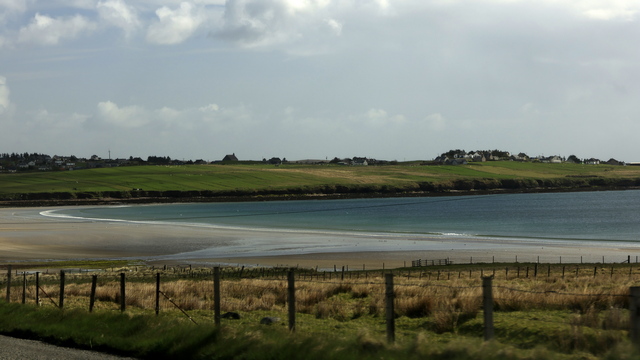
There also some beautiful sandy beaches along this coast.
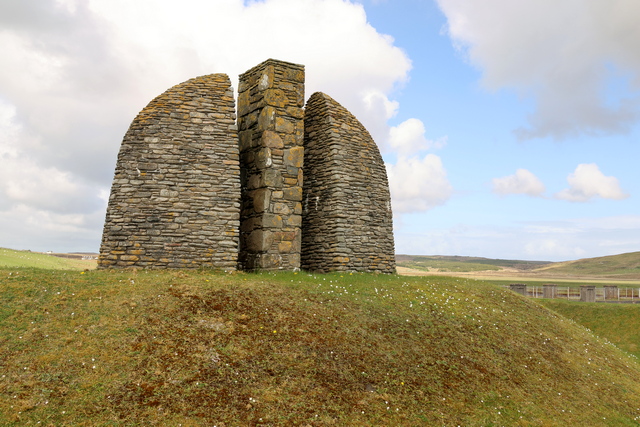
This is one of 3 memorials commemorating the land raiders. This memorial stands on a low hill surrounded by earthworks in the form of trenches and waves, a reminder of the First World War and the promises made to those who survived the conflict. After having fought and faced the horrors of the First World War, crofters returned to Lewis to make good the promise of land and homes made to them by the government. Unfortunately the new landowner Lord Leverhulme had other plans for the land and denied crofting land to the ex-servicemen. The ex-servicemen raided the farms over the next couple of years and eventually in 1922 the Board of Agriculture took over the farms and divided them into 100 new crofts.
Lord Leverhulme had established the very successful soap manufacturing company, Lever Brothers and bought the Isle of Lewis in 1918. He lived in the Lews Castle and later bought Harris. His intention was to revolutionise the lives of the population of these islands. His plans included industrialisation of the island resources including fish, seaweed, peat, and unproductive land. Lewis would grow to become an island of up to 200,000 people and major infrastructure was to be built to support the industry which included a railway. (borrowed from Visit Outer Hebrides website). Sorry for information overload I just thought it was a really interesting story)
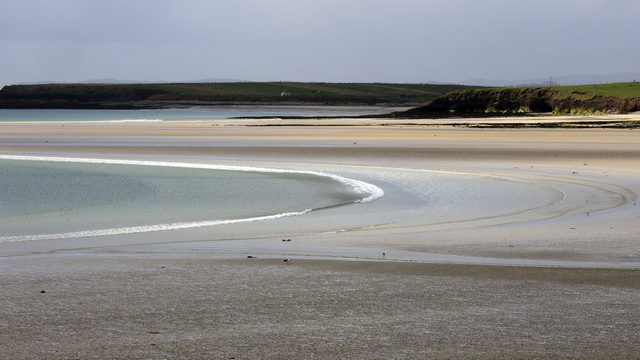
Another beautiful beach.
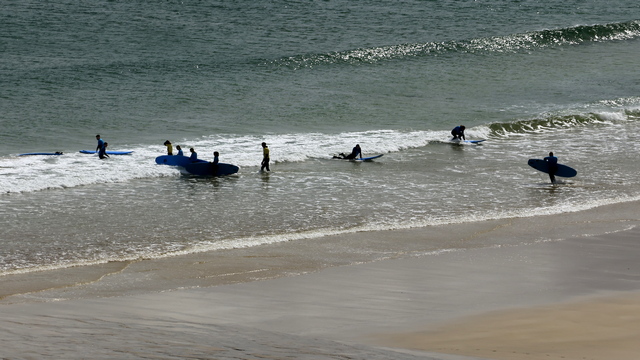
and another beautiful beach. At least this time there's actually people using the beach, very brave people I think. It was a little warmer today --- I think most of the time I was only wearing my down sweater. :)
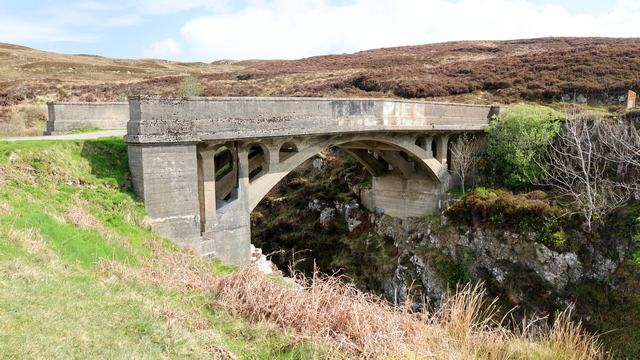
The Bridge to Nowhere or Garry Bridge was build by Lord Leverhulme in the process of continuing the road north along the coast. The building of road was abandoned when the raiders won their fight for crofts. Lewis and Harris would very different if the raiders hadn't won.
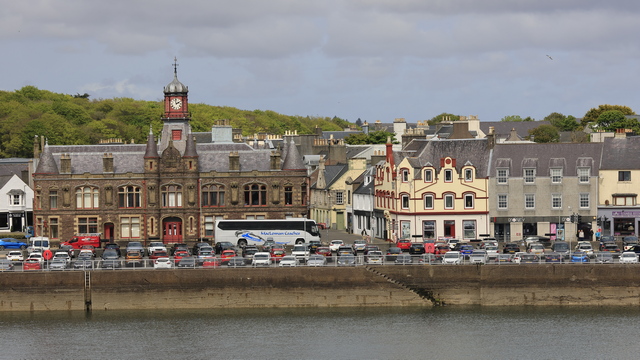
A view of Stornoway.
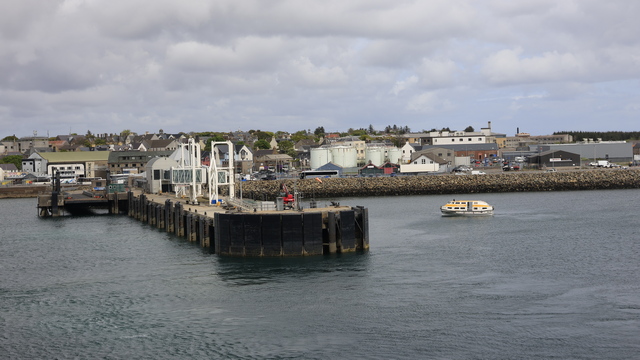
Leaving Stornoway. Yes, that's a tender in the water. There was a cruise ship anchored just outside of the harbour.
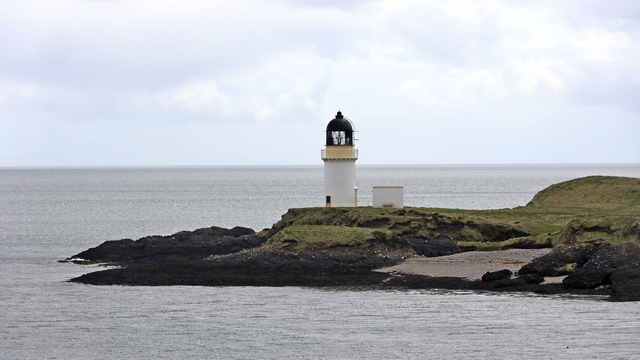
A lighthouse in the harbour.
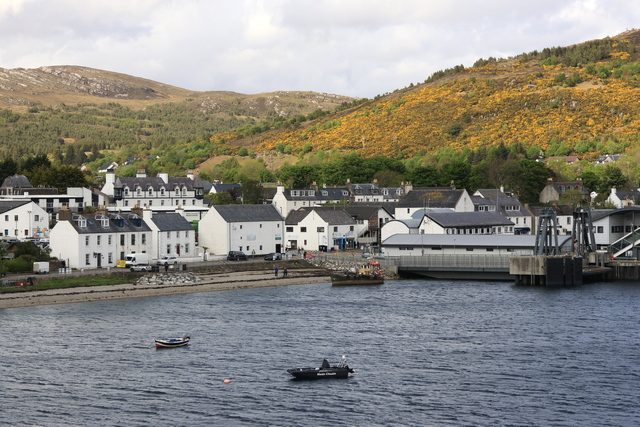
Arriving at Ullapool.
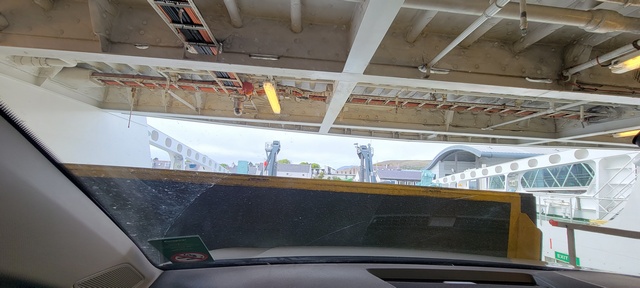
I know you're asking yourself "what is this a picture of?". It's what you see when you are the front care on the mezzanine on a ferry. I was not thrilled when I realized that we were actually parked on the ramp. This section of the mezzanine was lowered and became the ramp. Ed had me recording us being lowered so it wasn't as scary as I thought it would be.
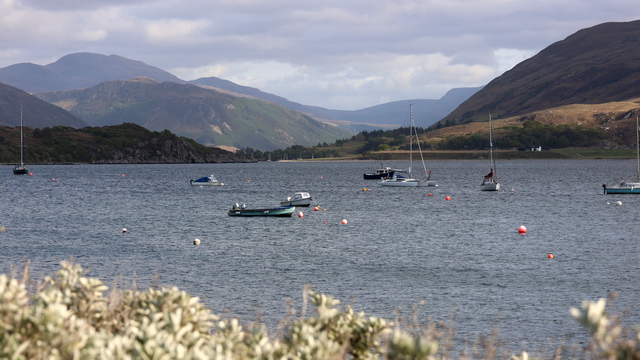
Ullapool harbour.

There also some beautiful sandy beaches along this coast.

This is one of 3 memorials commemorating the land raiders. This memorial stands on a low hill surrounded by earthworks in the form of trenches and waves, a reminder of the First World War and the promises made to those who survived the conflict. After having fought and faced the horrors of the First World War, crofters returned to Lewis to make good the promise of land and homes made to them by the government. Unfortunately the new landowner Lord Leverhulme had other plans for the land and denied crofting land to the ex-servicemen. The ex-servicemen raided the farms over the next couple of years and eventually in 1922 the Board of Agriculture took over the farms and divided them into 100 new crofts.
Lord Leverhulme had established the very successful soap manufacturing company, Lever Brothers and bought the Isle of Lewis in 1918. He lived in the Lews Castle and later bought Harris. His intention was to revolutionise the lives of the population of these islands. His plans included industrialisation of the island resources including fish, seaweed, peat, and unproductive land. Lewis would grow to become an island of up to 200,000 people and major infrastructure was to be built to support the industry which included a railway. (borrowed from Visit Outer Hebrides website). Sorry for information overload I just thought it was a really interesting story)

Another beautiful beach.

and another beautiful beach. At least this time there's actually people using the beach, very brave people I think. It was a little warmer today --- I think most of the time I was only wearing my down sweater. :)

The Bridge to Nowhere or Garry Bridge was build by Lord Leverhulme in the process of continuing the road north along the coast. The building of road was abandoned when the raiders won their fight for crofts. Lewis and Harris would very different if the raiders hadn't won.

A view of Stornoway.

Leaving Stornoway. Yes, that's a tender in the water. There was a cruise ship anchored just outside of the harbour.

A lighthouse in the harbour.

Arriving at Ullapool.

I know you're asking yourself "what is this a picture of?". It's what you see when you are the front care on the mezzanine on a ferry. I was not thrilled when I realized that we were actually parked on the ramp. This section of the mezzanine was lowered and became the ramp. Ed had me recording us being lowered so it wasn't as scary as I thought it would be.

Ullapool harbour.
2023/05/14: The Isle of Harris
Category: General
Posted by: The Agnew Family
Today we tour Harris starting with the beaches. We stop at only a few of the many beaches. A lot of the beaches can only be reached by hiking.
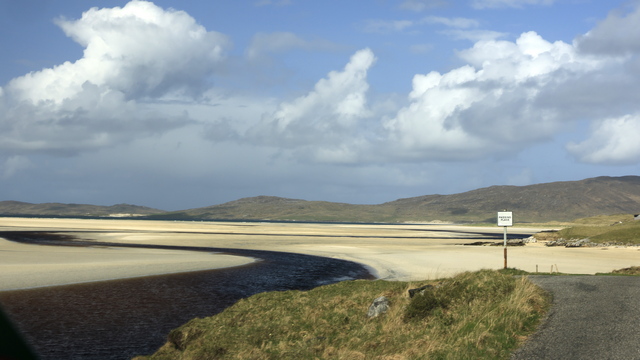
Driving along Fadhail Losgaintir.
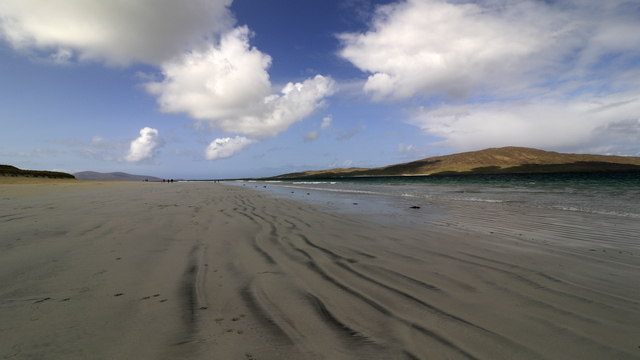
Luskentyre Beach. There were people walking but no one sitting on the beach or in the water.
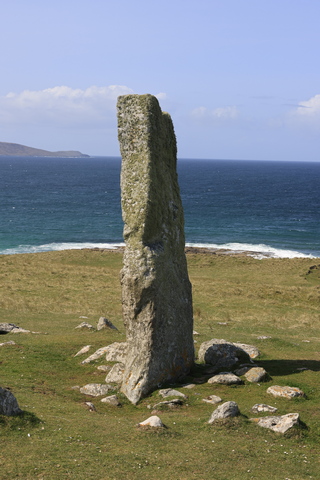
Macleod's Standing Stone stands to a height of 2.5 metres. To get to the stone you walk along a beautiful beach and up a grassy knoll.
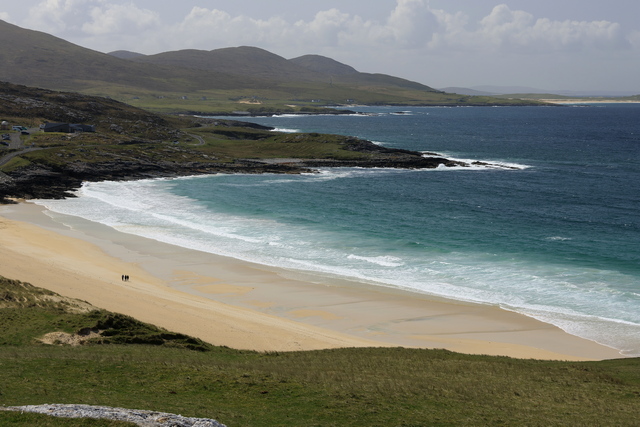
From Macleod's stone looking down on Nisabost Beach.
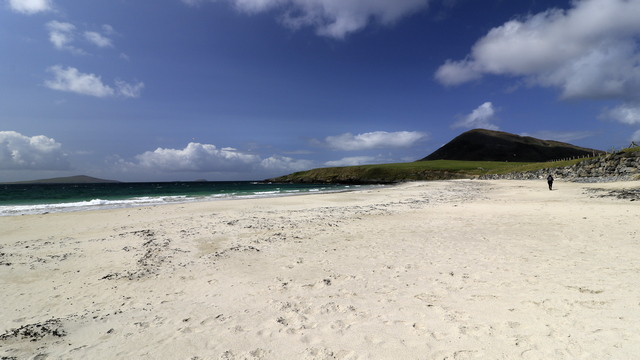
At the bottom of the island Northton beach.
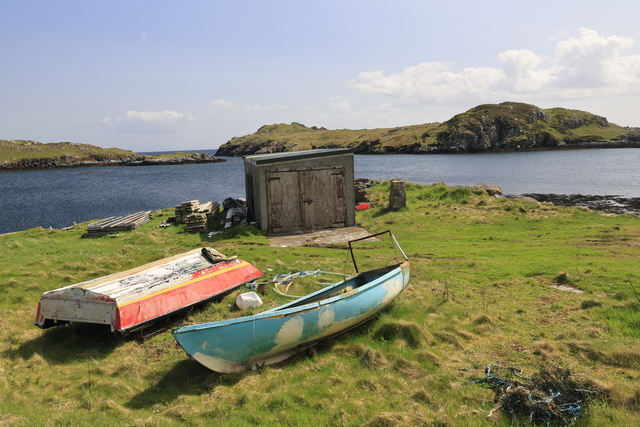
Now for a change of scenery. We've reached the bottom of the south end of the island and are going to drive north.
This is just past the small town of Rodel. No sand here.
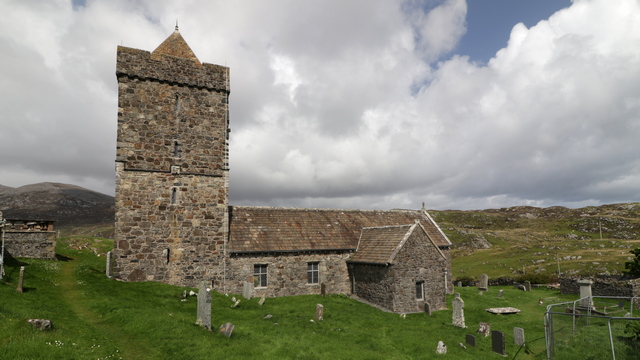
St. Clement's Church in Rodel. It is a late fifteenth-century or early sixteenth-century church built for the Chiefs of the MacLeods of Harris. It is dedicated to Pope Clement I.
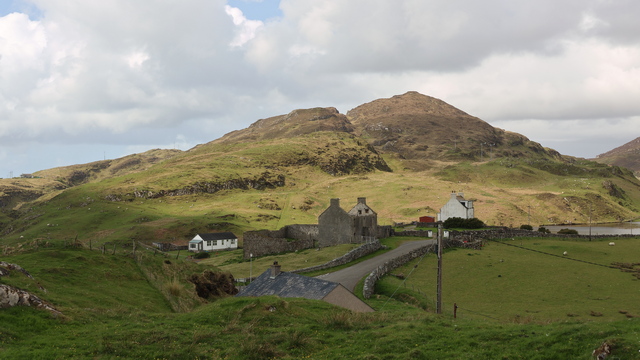
A view from the church looking inlaid.
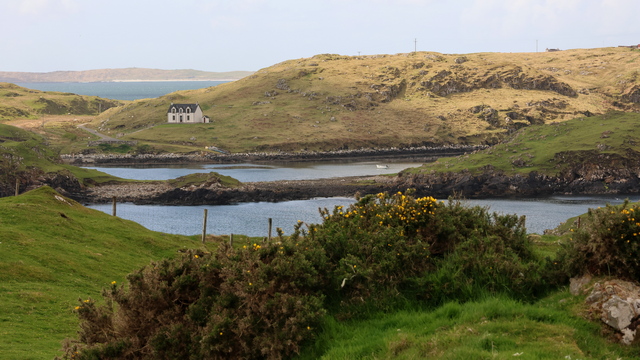
Another view from the church, this time looking towards the water.
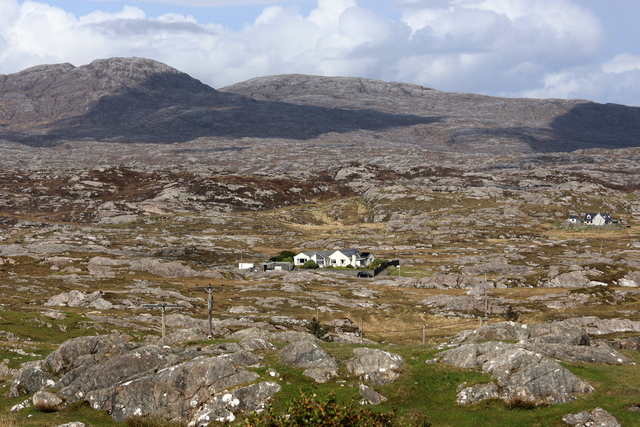
As we begin driving the scenery changes dramatically. I don't know how to describe it other than rocky. The photo doesn't do it justice. It was surreal.
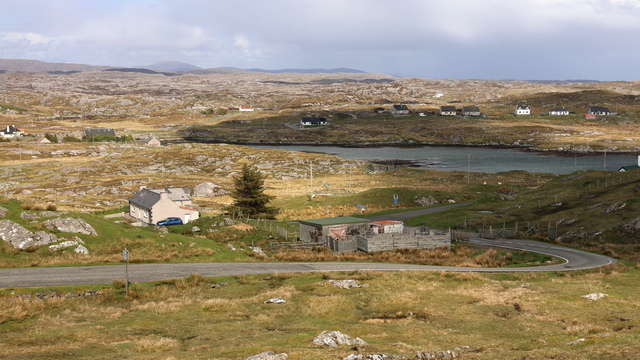
We saw a surprising number of small towns and homes here. The road was of coarse 1 lane, very curvy with blind hills every where and the road usually had a curve after the blind hill.
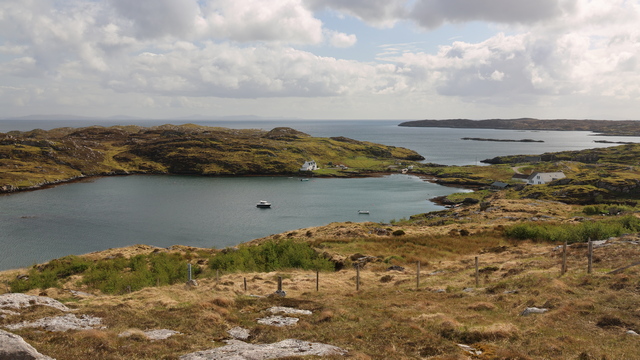
The sea side looked was one would expect.
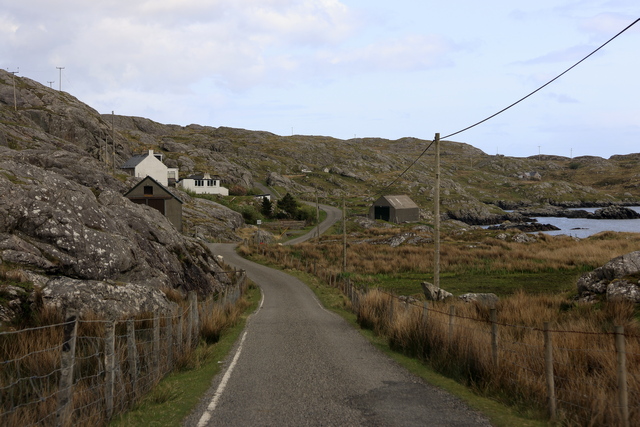
The inland side had the dramatic view.
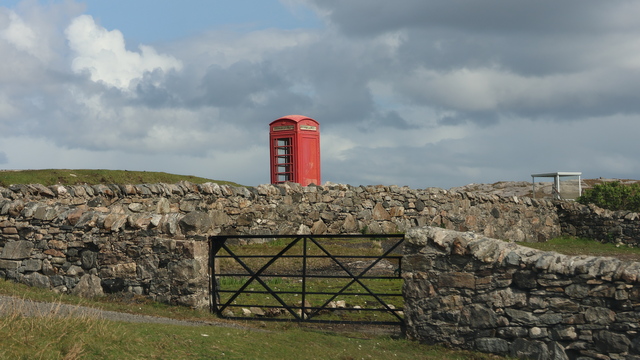
As we were driving we noticed a fair number of telephone booths with telephones. Sometimes the booth would be beside a house, sometimes just out by the road. We even saw a few bus shelters, so I guess the bus runs out here.
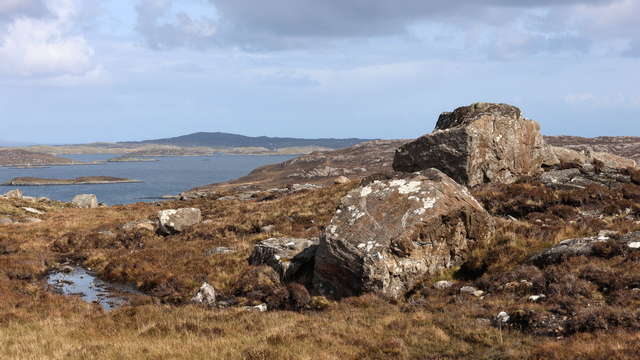
Back on the main road another great view
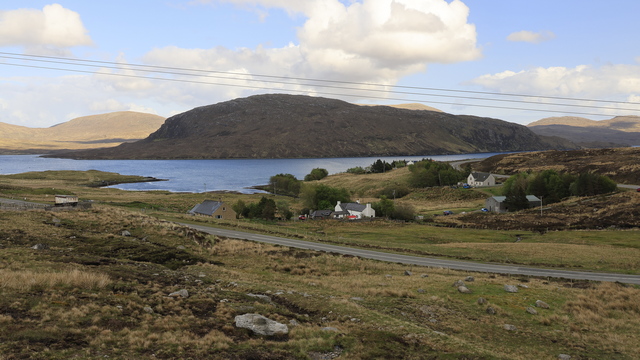
I think this is back on the Lewis side.

Driving along Fadhail Losgaintir.

Luskentyre Beach. There were people walking but no one sitting on the beach or in the water.

Macleod's Standing Stone stands to a height of 2.5 metres. To get to the stone you walk along a beautiful beach and up a grassy knoll.

From Macleod's stone looking down on Nisabost Beach.

At the bottom of the island Northton beach.

Now for a change of scenery. We've reached the bottom of the south end of the island and are going to drive north.
This is just past the small town of Rodel. No sand here.

St. Clement's Church in Rodel. It is a late fifteenth-century or early sixteenth-century church built for the Chiefs of the MacLeods of Harris. It is dedicated to Pope Clement I.

A view from the church looking inlaid.

Another view from the church, this time looking towards the water.

As we begin driving the scenery changes dramatically. I don't know how to describe it other than rocky. The photo doesn't do it justice. It was surreal.

We saw a surprising number of small towns and homes here. The road was of coarse 1 lane, very curvy with blind hills every where and the road usually had a curve after the blind hill.

The sea side looked was one would expect.

The inland side had the dramatic view.

As we were driving we noticed a fair number of telephone booths with telephones. Sometimes the booth would be beside a house, sometimes just out by the road. We even saw a few bus shelters, so I guess the bus runs out here.

Back on the main road another great view

I think this is back on the Lewis side.
2023/05/13: The Isle of Lewis
Category: General
Posted by: The Agnew Family
The Isle of Lewis is the top 2/3rds of Harris and Lewis. Today we are touring around that portion of the island. Lewis is a lot flatter than Harris, not to say it's flat but the hills are definitely smaller and the roads are straighter.
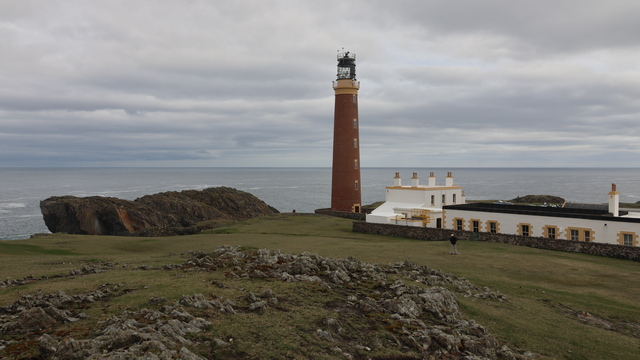
The Butt of Lewis Lighthouse. The lighthouse was engineered by David Stevenson in 1862, a uncle of Robert Louis Stevenson.
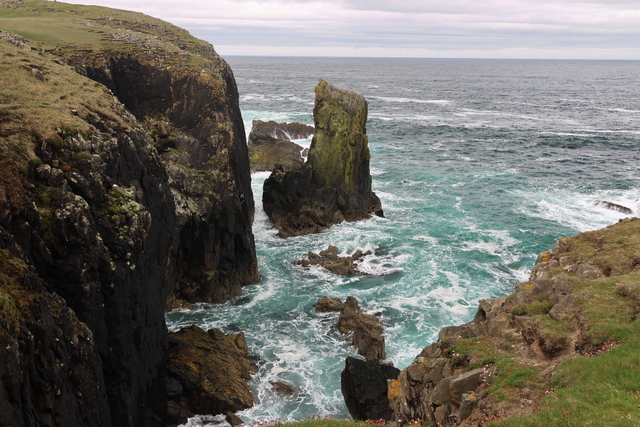
Looking over the cliff at the lighthouse.
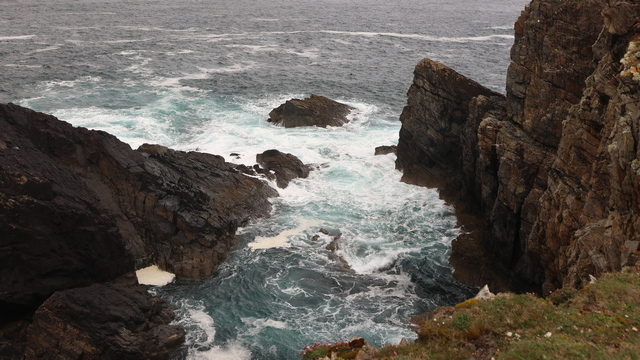
More cliffs and water. The main rock found here is Lewisian Gneiss, formed 3000 million years ago and some of the oldest rocks in Europe.
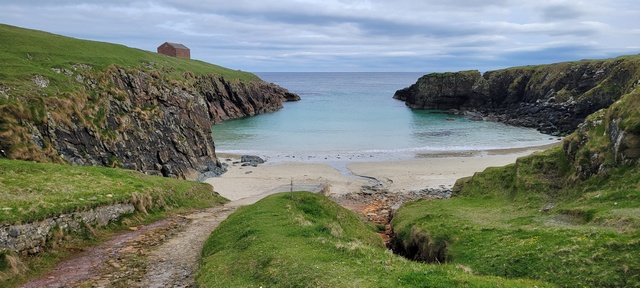
Not far from the lighthouse was this cute little sandy beach.
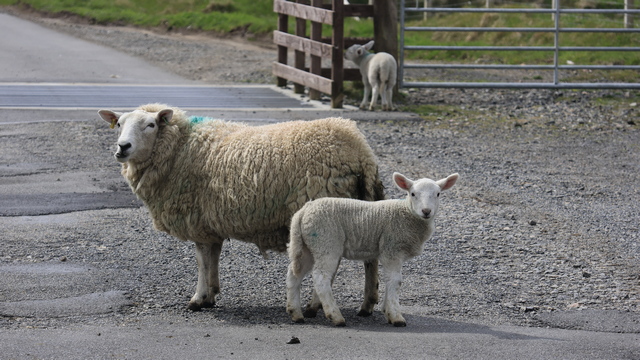
When you're driving around Harris and Lewis you have to always be watching for sheep on the road. When you're walking around you're always trying to avoid sheep and cow droppings. To keep the animals in a particular area cattle grates cross the road. A number of sheep were on the road in front of us --- mama sheep was staring us down. The baby raced up to mama and started nursing, then started staring us down as well. Luckily, they will move if you drive slowly towards them.
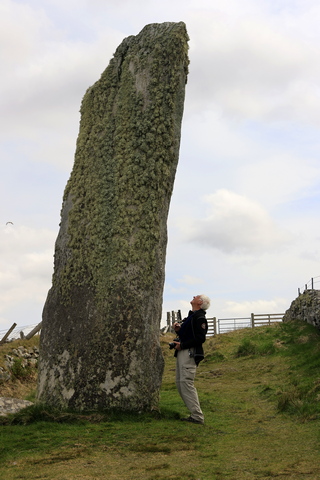
Clach an Truiseil is the tallest standing stone in Scotland at over 19 feet high (5.8m), with another 6 feet (2m) underground. Local tradition says that the stone marks the site of a clan battle between the Macaulays and the Morrisons or, alternatively, the grave of a Norse warrior killed in battle.
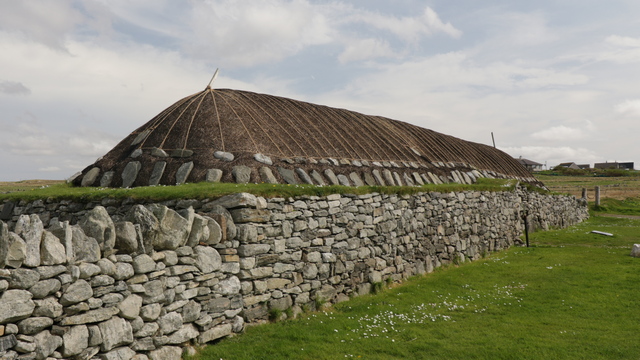
The blackhouse is a traditional type of house which use to be common in the Scottish highlands. This is a reconstruction of a blackhouse.
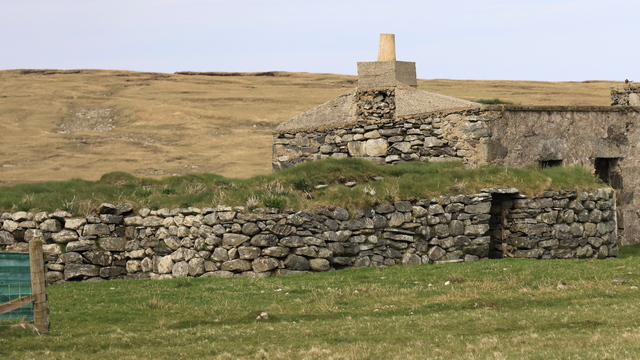
Ignoring the larger building behind it, this is what blackhouses look like today.
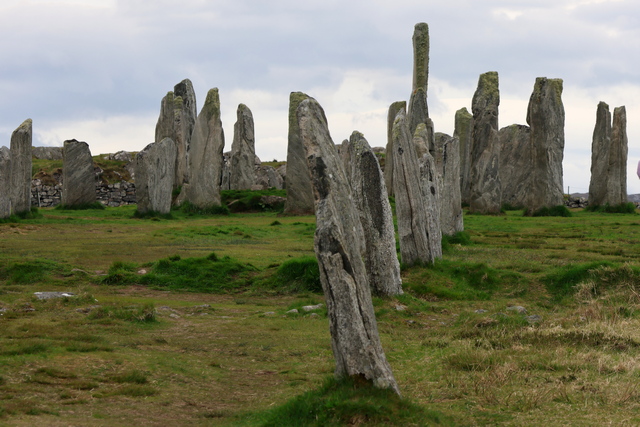
The Callanish Stones are an arrangement of standing stones placed in a cruciform (cross) pattern with a central stone circle. The stone circle was set up between 2900 and 2600 BC, but they are not sure when the other stones were placed. The Callanish Stones predate England's Stonehenge.
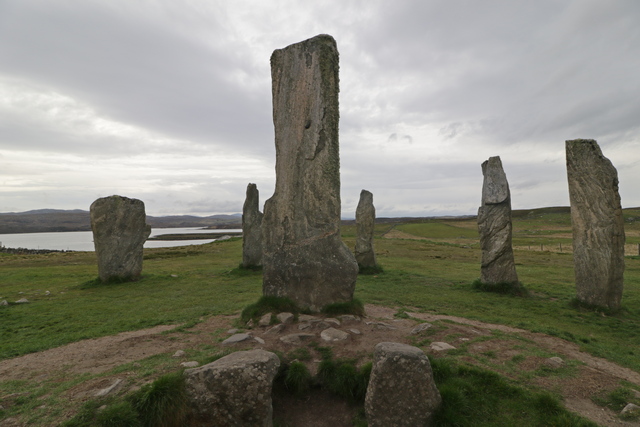
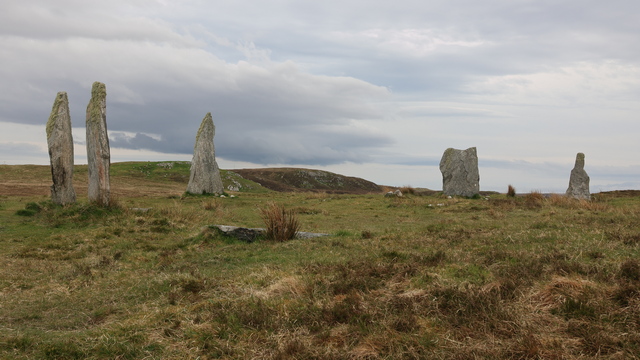
On Lewis there are many standing stones, stone circles, etc. This site is referred to as Callanish Stones II and it's not far from the Callanish Stones (Callanish I)
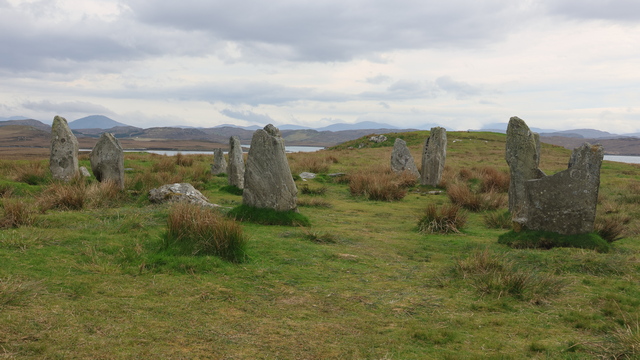
This is Callanish III, one field over from Callanish II.
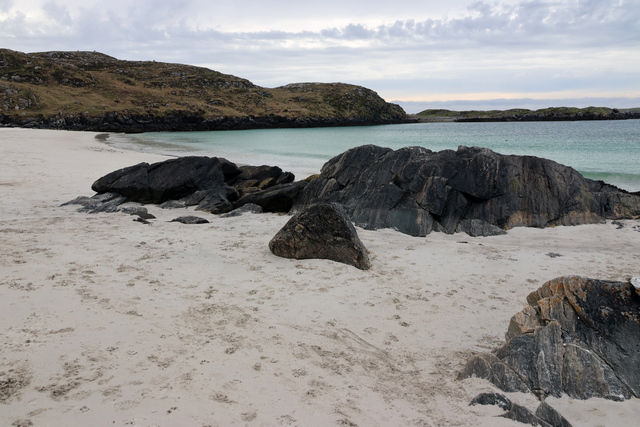
Bosta Beach at the end of Great Bernera Island. A bridge links Great Bernera Island to Lewis. Interesting fact, after a huge storm in the 1990's a lot of the sand from the beach was washed out uncovering some Iron Age Houses. They were studied then recovered with sand as the sand was naturally coming back to the beach.
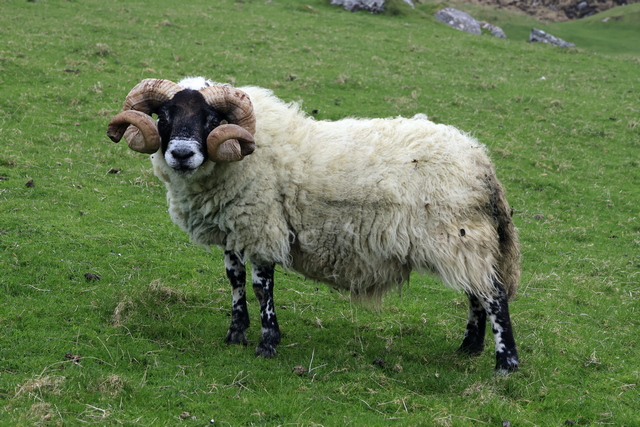
Now that's a nice set of horns.
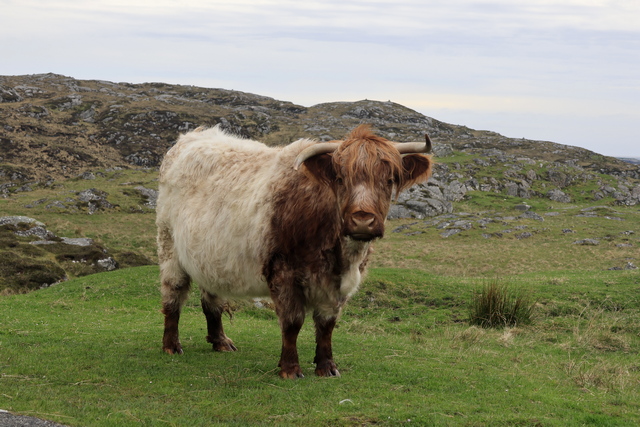
A hairy coo or by it's proper name a highland cow. This one needs a little work on one of his horns.

The Butt of Lewis Lighthouse. The lighthouse was engineered by David Stevenson in 1862, a uncle of Robert Louis Stevenson.

Looking over the cliff at the lighthouse.

More cliffs and water. The main rock found here is Lewisian Gneiss, formed 3000 million years ago and some of the oldest rocks in Europe.

Not far from the lighthouse was this cute little sandy beach.

When you're driving around Harris and Lewis you have to always be watching for sheep on the road. When you're walking around you're always trying to avoid sheep and cow droppings. To keep the animals in a particular area cattle grates cross the road. A number of sheep were on the road in front of us --- mama sheep was staring us down. The baby raced up to mama and started nursing, then started staring us down as well. Luckily, they will move if you drive slowly towards them.

Clach an Truiseil is the tallest standing stone in Scotland at over 19 feet high (5.8m), with another 6 feet (2m) underground. Local tradition says that the stone marks the site of a clan battle between the Macaulays and the Morrisons or, alternatively, the grave of a Norse warrior killed in battle.

The blackhouse is a traditional type of house which use to be common in the Scottish highlands. This is a reconstruction of a blackhouse.

Ignoring the larger building behind it, this is what blackhouses look like today.

The Callanish Stones are an arrangement of standing stones placed in a cruciform (cross) pattern with a central stone circle. The stone circle was set up between 2900 and 2600 BC, but they are not sure when the other stones were placed. The Callanish Stones predate England's Stonehenge.


On Lewis there are many standing stones, stone circles, etc. This site is referred to as Callanish Stones II and it's not far from the Callanish Stones (Callanish I)

This is Callanish III, one field over from Callanish II.

Bosta Beach at the end of Great Bernera Island. A bridge links Great Bernera Island to Lewis. Interesting fact, after a huge storm in the 1990's a lot of the sand from the beach was washed out uncovering some Iron Age Houses. They were studied then recovered with sand as the sand was naturally coming back to the beach.

Now that's a nice set of horns.

A hairy coo or by it's proper name a highland cow. This one needs a little work on one of his horns.
2023/05/12: Good-bye Skye Hello Harris and Lewis
Category: General
Posted by: The Agnew Family
We're leaving Skye today and taking the Ferry to the Isle of Harris. Have you ever heard of Harris Tweed, well this is where it's from. First we have a few more photos of Skye.
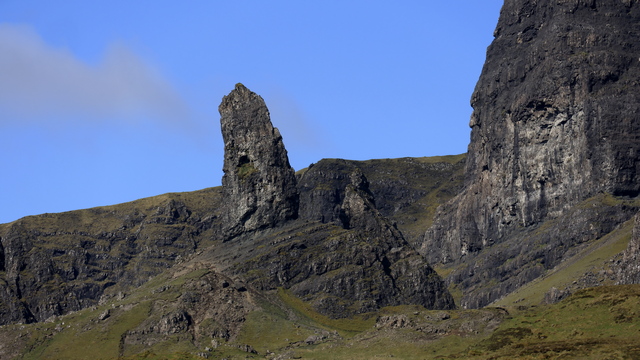
Finally the Old Man of Storr with a blue sky. Would you believe I got this photo shooting through the front window of the car as Ed was driving?
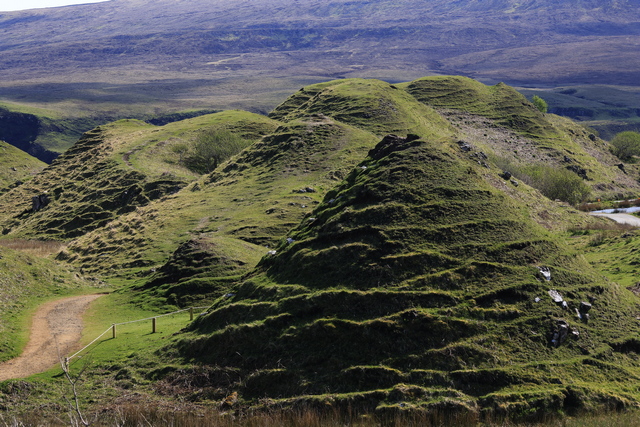
The Fairy Glen has a unique landscape. it is believed to have been formed by a series of landslips, similar to the ones that created the epic Old Man of Storr and the Quiraing formations. The landscape was then smoothed by the movement of glaciers that occurred during the following ice age.
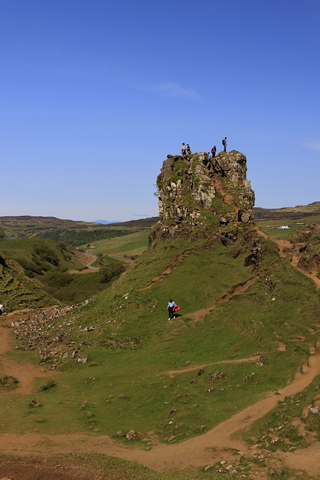
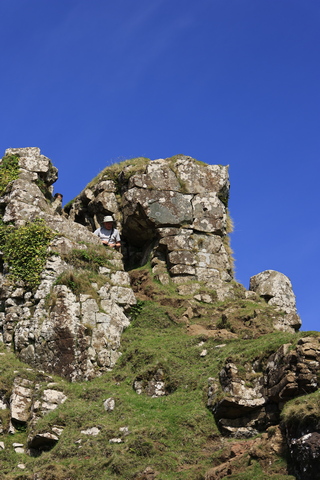
The top of this bump kept it's basalt rock. People like to climb to the top ---- even Ed.
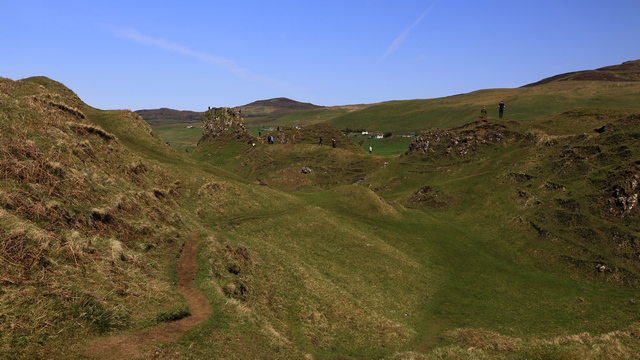
The Fairy Glen.
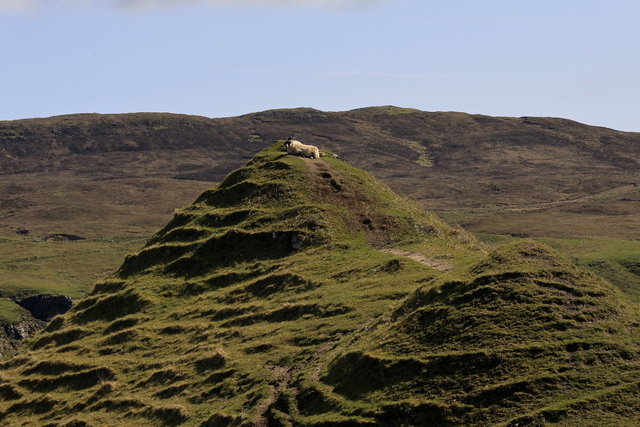
Look who's queen of the castle ... or should I say Fairy Hill.
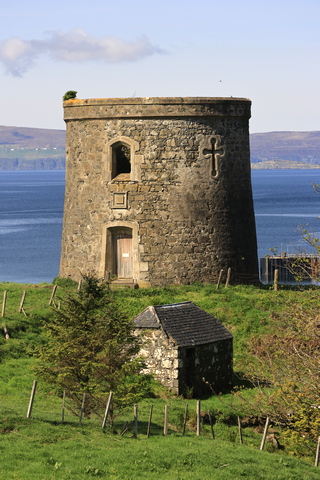
Uig Tower or Captain Fraser's Folly. It was built in the 19th century purely for decorative purposes.
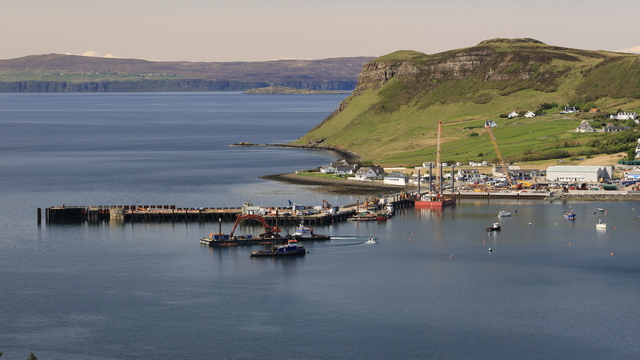
The ferry terminal.
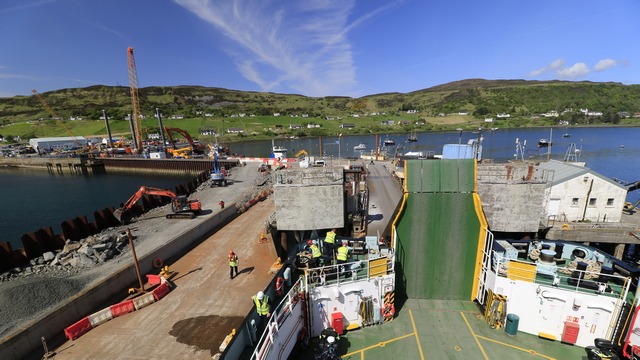
We're on the ferry and on our way. Looking back you can see the construction at the harbour.
The Isle of Skye is an extremely beautiful island with lots of interesting things to see, lots of trails to hike and unfortunately lots of pot holes. We were told by Rachel our b&b host that Harris and Lewis take better care of the their roads and we shouldn't run into any pot holes. Harris and Lewis have unique landscapes both of which are very different from Skye.
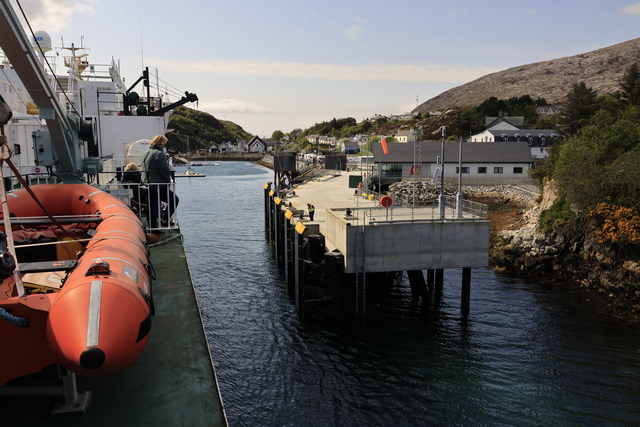
Arriving in Tarbert, Harris.
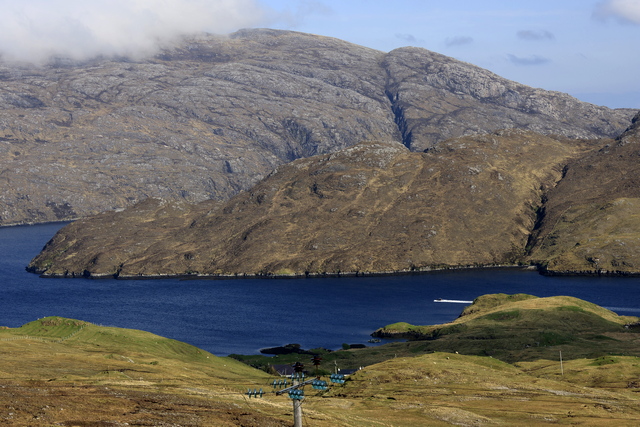
I'm not sure if this is Harris or Lewis but I think it's Harris. There isn't a sign telling when you've gone from one to the other but the landscape does changes. The airbnb we're staying in is in Lewis.
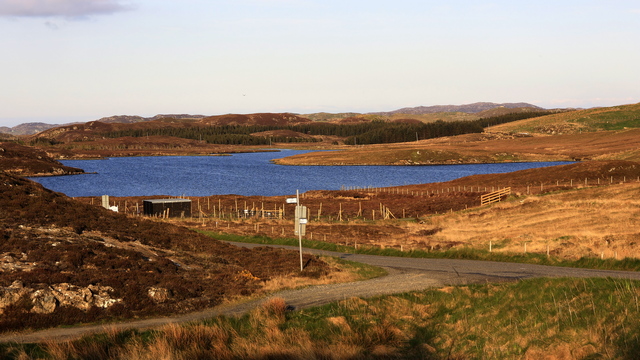
A view of Lewis off of the main road.

Finally the Old Man of Storr with a blue sky. Would you believe I got this photo shooting through the front window of the car as Ed was driving?

The Fairy Glen has a unique landscape. it is believed to have been formed by a series of landslips, similar to the ones that created the epic Old Man of Storr and the Quiraing formations. The landscape was then smoothed by the movement of glaciers that occurred during the following ice age.


The top of this bump kept it's basalt rock. People like to climb to the top ---- even Ed.

The Fairy Glen.

Look who's queen of the castle ... or should I say Fairy Hill.

Uig Tower or Captain Fraser's Folly. It was built in the 19th century purely for decorative purposes.

The ferry terminal.

We're on the ferry and on our way. Looking back you can see the construction at the harbour.
The Isle of Skye is an extremely beautiful island with lots of interesting things to see, lots of trails to hike and unfortunately lots of pot holes. We were told by Rachel our b&b host that Harris and Lewis take better care of the their roads and we shouldn't run into any pot holes. Harris and Lewis have unique landscapes both of which are very different from Skye.

Arriving in Tarbert, Harris.

I'm not sure if this is Harris or Lewis but I think it's Harris. There isn't a sign telling when you've gone from one to the other but the landscape does changes. The airbnb we're staying in is in Lewis.

A view of Lewis off of the main road.
2023/05/11: Not the Day I Planned
Category: General
Posted by: The Agnew Family
This morning it was a little weird out ... a cloud seem to sitting over us. It was sort of fog like but not like the fog at home. As we headed out we drove out of the cloud into beautiful sun and it stayed that way all day and into the evening.
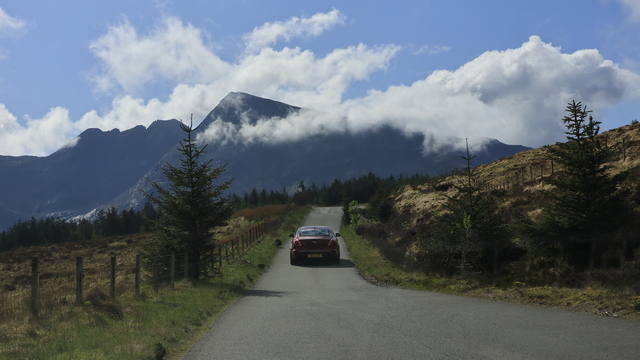
A view on the drive to the fairy pools.
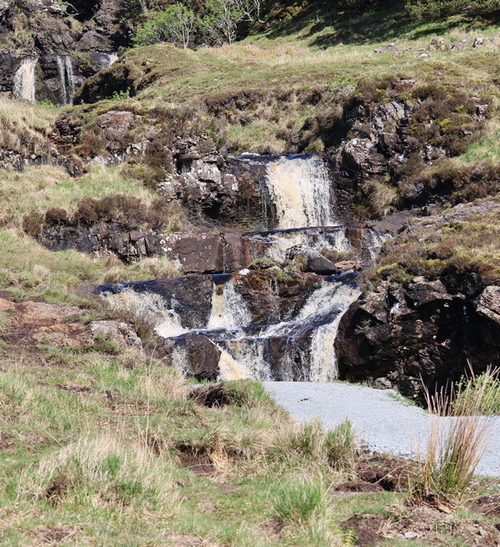
A waterfall near the fairy pools. This is the first place on Scotland where we have seen tannin in the water making it look a little brown.
We drove to the fairy pools. he Fairy Pools are a natural waterfall phenomenon on the Allt Coir' a' Mhadaidh. The pools are a vivid aqua blue and are a popular place for wild swimmers who brave the frigid waters. The water would feel warm for people who do the polar plunge at home.
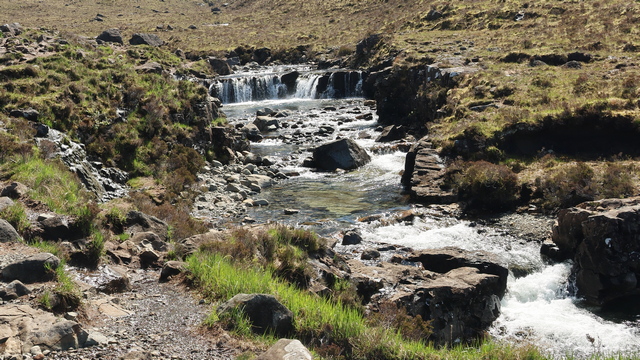
Do you see the flat water in the middle of the photo? That is a fairy pool.
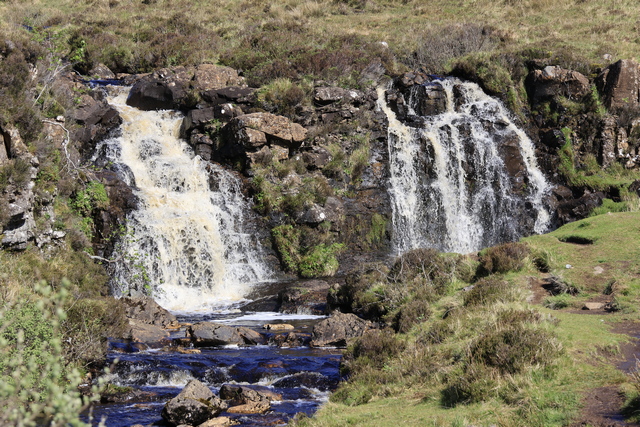
Lots of waterfalls here.
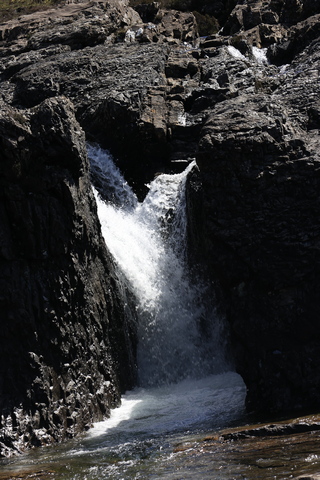
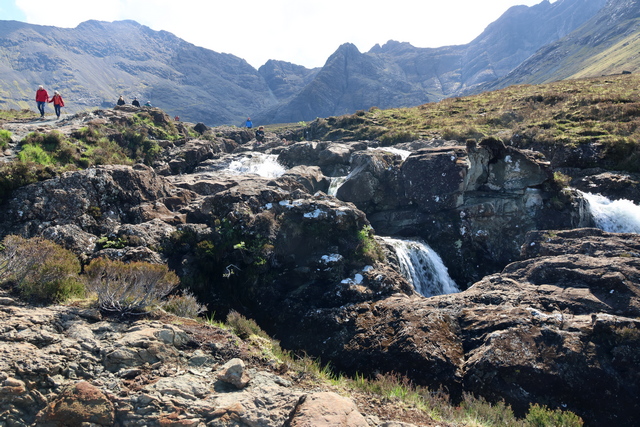
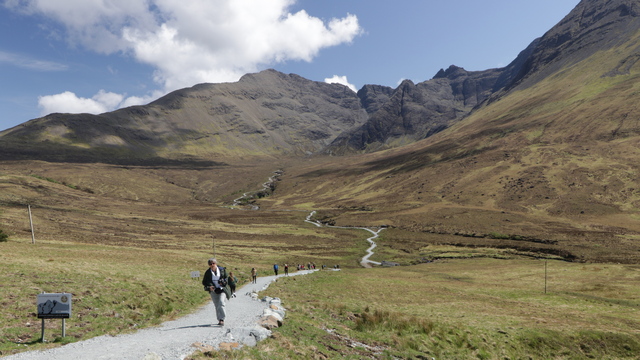
Walking out of the fairy pools.
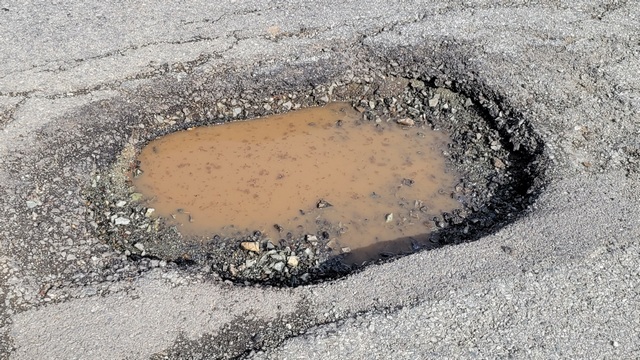
We were leaving the pools and starting to drive towards Talisker Bay when this pot hole jumped up and bit our tire. Did you know that rental cars do not have a spare tire on board (at least in Scotland)? We were literally in the middle of nowhere when our tire blew. All the maps referred to the road as unknown road and there was nothing but fields and the occasional sheep. Luckily we had cell phone service and we also had the app What3Words that gives you 3 unique words for your specific location. The person you give the words to can enter the words into the app and get a map pin pointing where you are. This allowed the tire repair truck to find us.
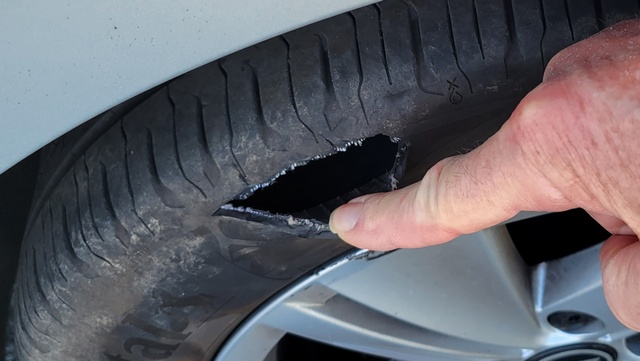
It was a really good bite.
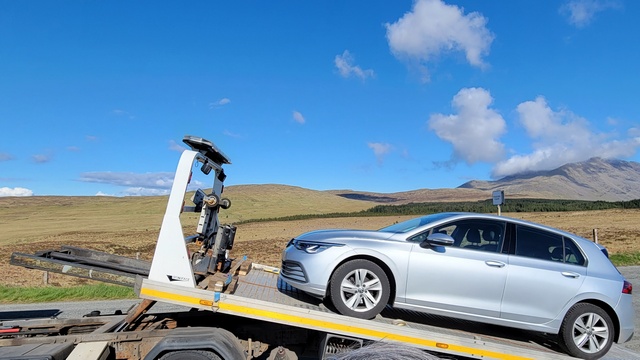
Loading up the car to drive it to Portree to replace the tire.
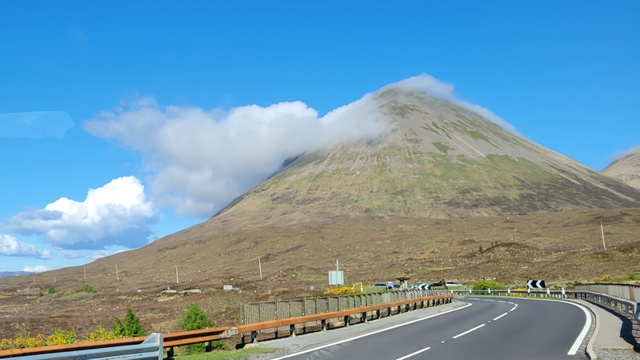
On the ride back to Portree we saw clouds sitting on the hills. At times the entire top of the hill was obscured.

A view on the drive to the fairy pools.

A waterfall near the fairy pools. This is the first place on Scotland where we have seen tannin in the water making it look a little brown.
We drove to the fairy pools. he Fairy Pools are a natural waterfall phenomenon on the Allt Coir' a' Mhadaidh. The pools are a vivid aqua blue and are a popular place for wild swimmers who brave the frigid waters. The water would feel warm for people who do the polar plunge at home.

Do you see the flat water in the middle of the photo? That is a fairy pool.

Lots of waterfalls here.



Walking out of the fairy pools.

We were leaving the pools and starting to drive towards Talisker Bay when this pot hole jumped up and bit our tire. Did you know that rental cars do not have a spare tire on board (at least in Scotland)? We were literally in the middle of nowhere when our tire blew. All the maps referred to the road as unknown road and there was nothing but fields and the occasional sheep. Luckily we had cell phone service and we also had the app What3Words that gives you 3 unique words for your specific location. The person you give the words to can enter the words into the app and get a map pin pointing where you are. This allowed the tire repair truck to find us.

It was a really good bite.

Loading up the car to drive it to Portree to replace the tire.

On the ride back to Portree we saw clouds sitting on the hills. At times the entire top of the hill was obscured.
2023/05/10: Coral Beach and Neist Point
Category: General
Posted by: The Agnew Family
To today it is raining, not drizzling. The forecast shows that it should let up around noon, so we drove across the island to Coral Beach. We have rain gear so we can always walk to the beach in the rain.
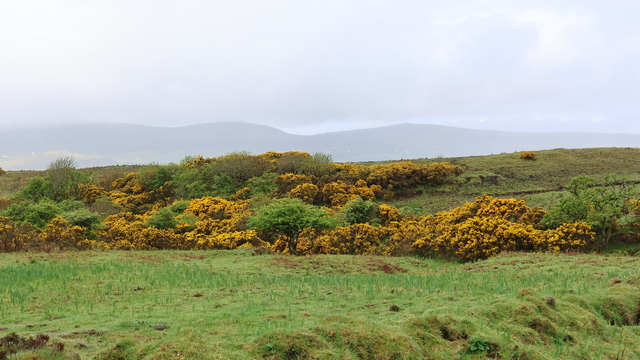
It's still pretty grey but the rain is more of a drizzle. These bushes add a little colour to the dull day.
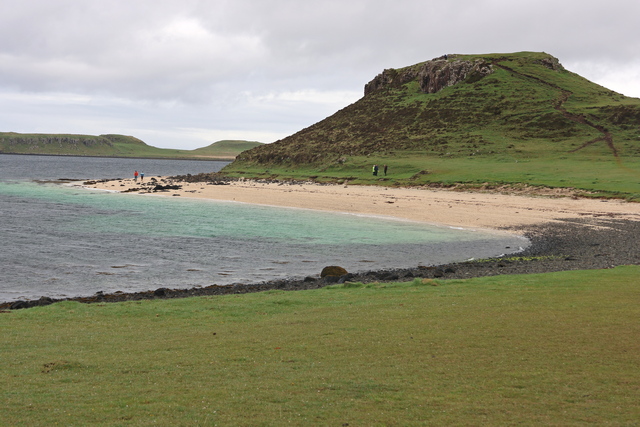
Coral Beach. The actual beach is made from bleached skeletons of a red coraline seaweed called Maerl (pronounced Marl). Maerl contains a large amount of lime (calcium carbonate) that has been used locally by farmers to enrich the soil.
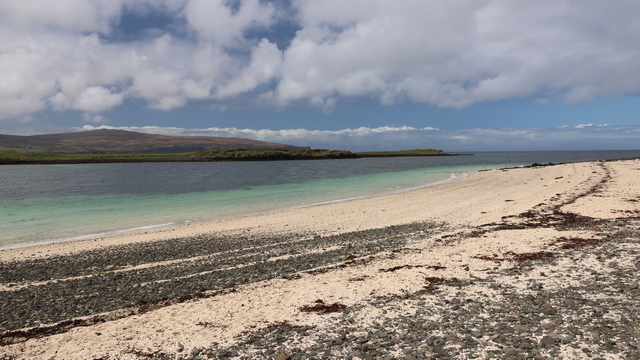
Yes, it stopped raining and we're seeing sun and blue skies.
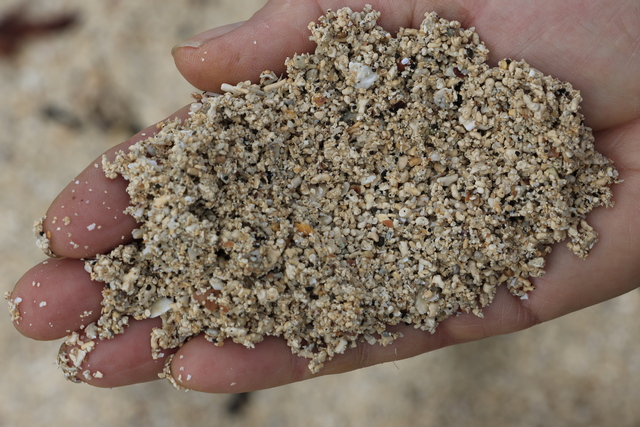
A closeup up of the "sand". It was very gritty like tiny bits of shell.
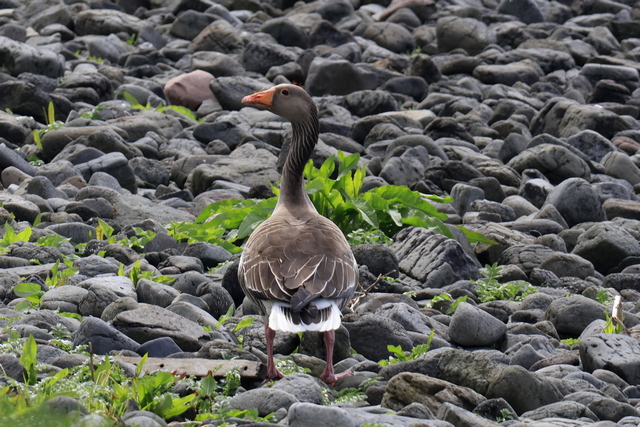
We weren't the only ones checking out the water's edge.
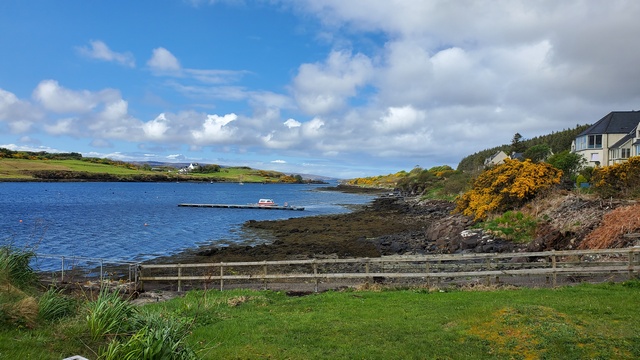
We stopped for coffee and sat in the back garden with this view.
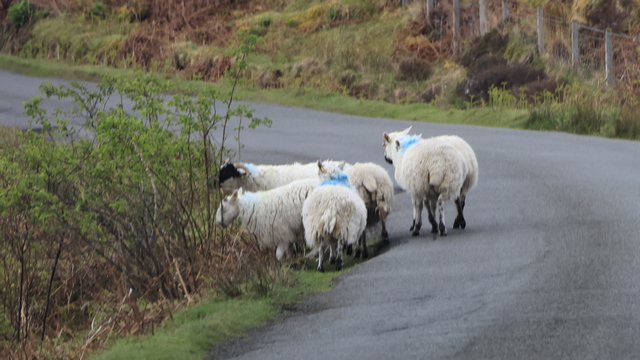
We had to contend with some local traffic today --- the off ramp was backed up.
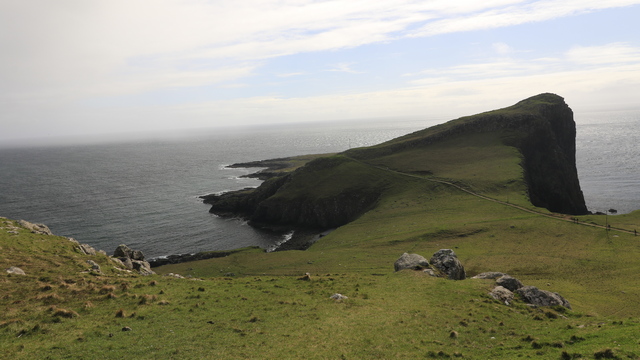
Neist Point is a viewpoint on the most westerly point of Skye. Neist Point Lighthouse has been located there since 1909. .
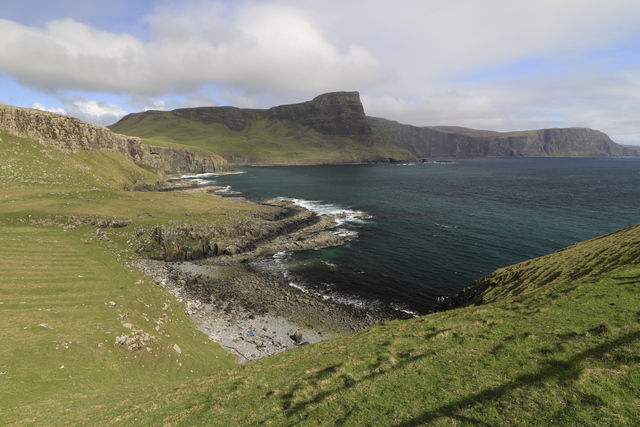
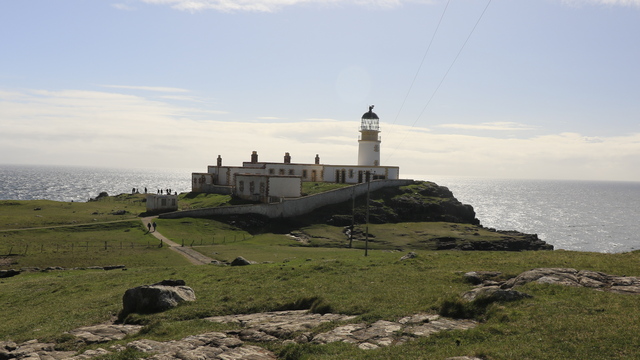
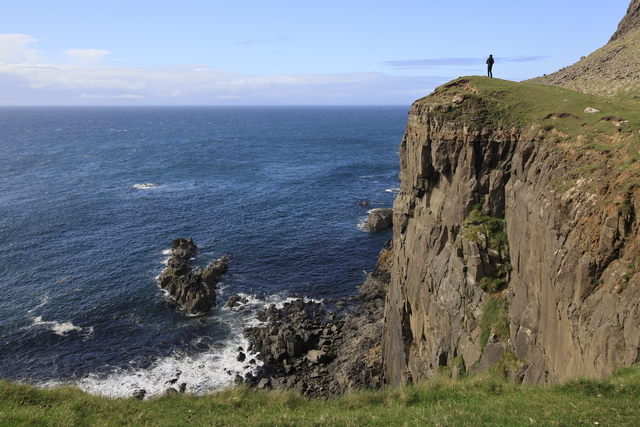
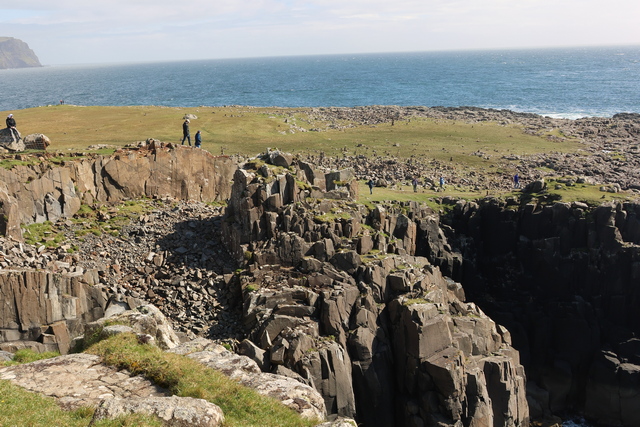
There's lots of basalt rock here as well, the same as we saw on Staffa and the Giant's Causeway in Ireland.
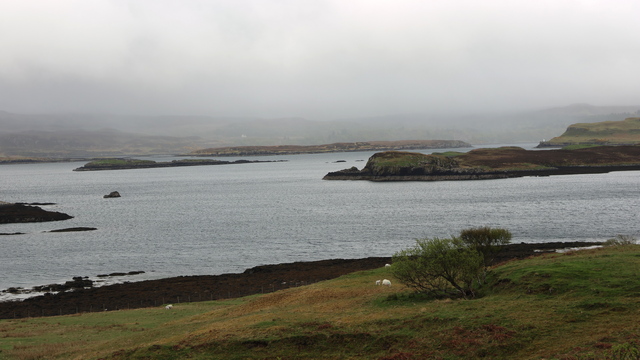
The rain is coming in, time for us to head out.

It's still pretty grey but the rain is more of a drizzle. These bushes add a little colour to the dull day.

Coral Beach. The actual beach is made from bleached skeletons of a red coraline seaweed called Maerl (pronounced Marl). Maerl contains a large amount of lime (calcium carbonate) that has been used locally by farmers to enrich the soil.

Yes, it stopped raining and we're seeing sun and blue skies.

A closeup up of the "sand". It was very gritty like tiny bits of shell.

We weren't the only ones checking out the water's edge.

We stopped for coffee and sat in the back garden with this view.

We had to contend with some local traffic today --- the off ramp was backed up.

Neist Point is a viewpoint on the most westerly point of Skye. Neist Point Lighthouse has been located there since 1909. .




There's lots of basalt rock here as well, the same as we saw on Staffa and the Giant's Causeway in Ireland.

The rain is coming in, time for us to head out.
2023/05/09: Trotternish Peninsula Isle of Skye
Category: General
Posted by: The Agnew Family
One of Ed's reasons for wanting to come back to Scotland was to see more of the Isle of Skye, particularly to hike the Quiraign. Mother Nature co-operated and we had a beautiful morning to do the hike --- well most of it. We skipped an extension at the end. Be warned it was really hard to choose photos so there's lots of them.
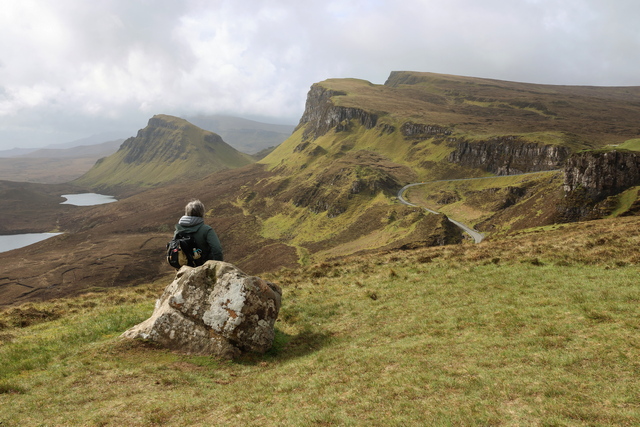
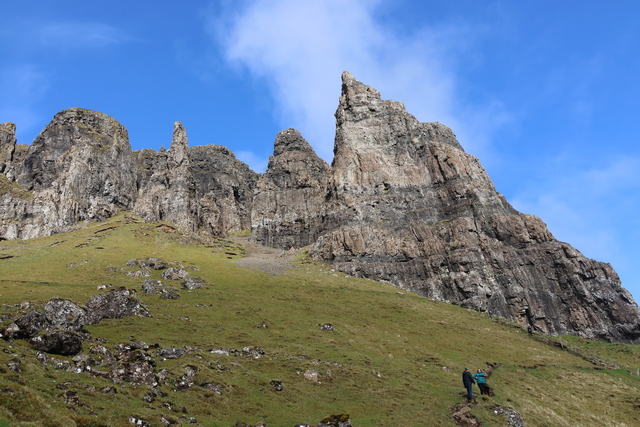
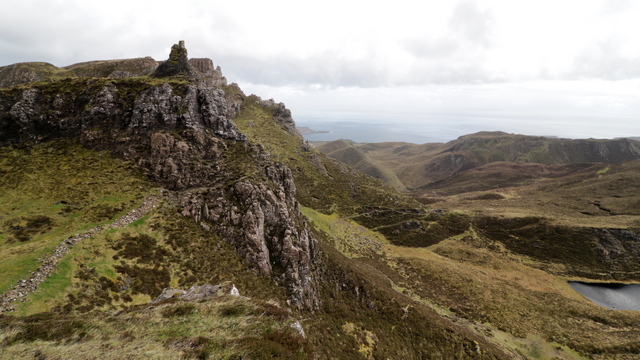
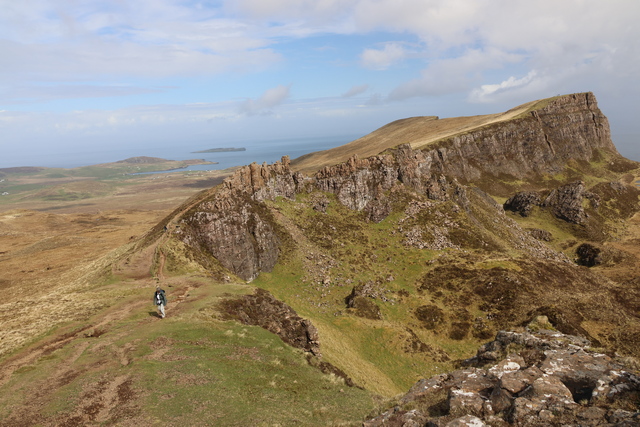
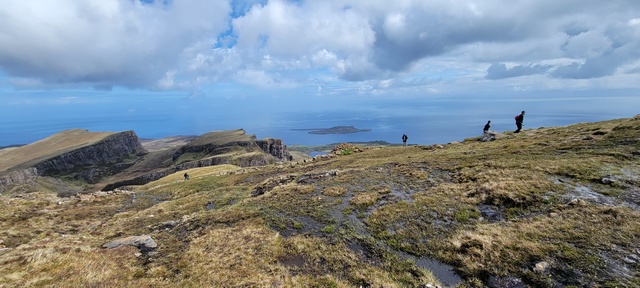
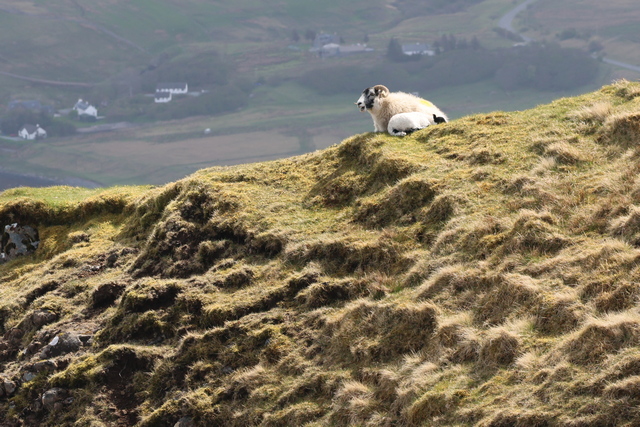
Even the sheep enjoy the view. That little white bump beside the sheep is a lamb.
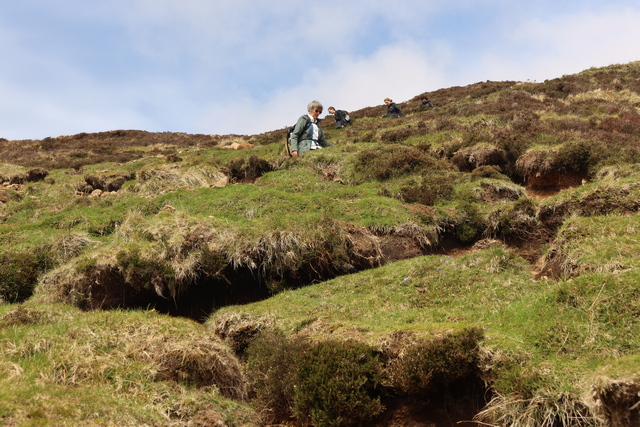
Probably the worst section of the hike was right at the end. It was quite steep and you were walking through thigh deep ruts.
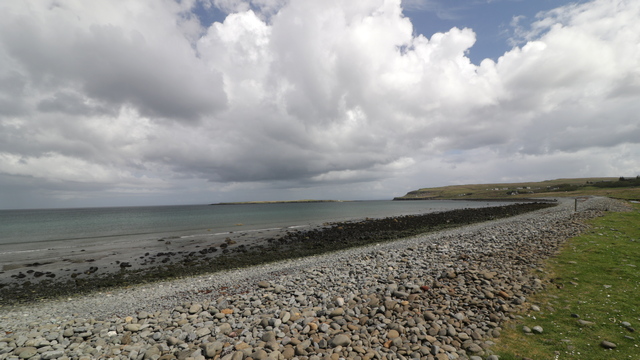
After we left the Quiraing we decided to check out a beach. The beaches here are a bit rocky, well this one at least.
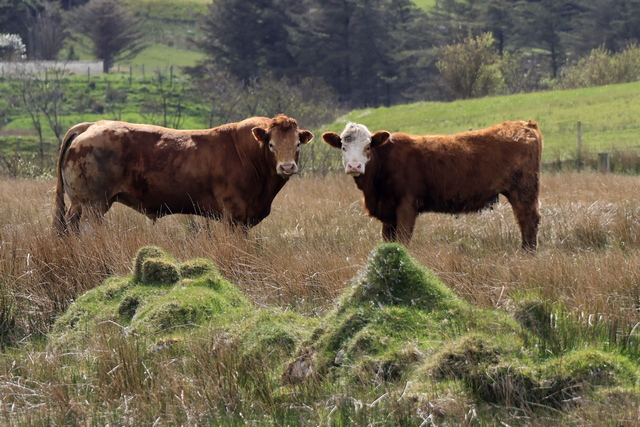
Walking back to the car from the beach we notice these two staring at us.
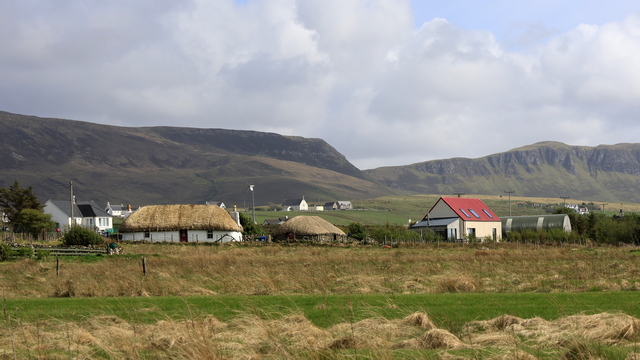
The scenery on the Isle of Skye is just amazing.
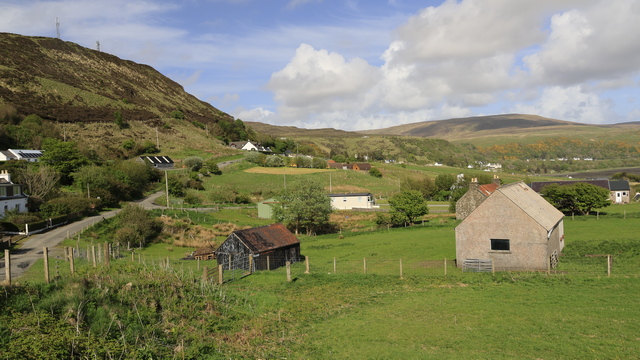
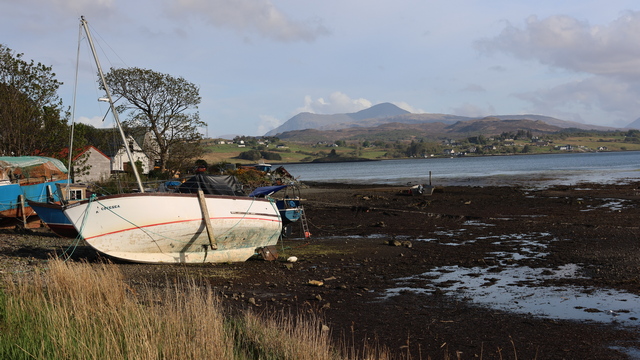
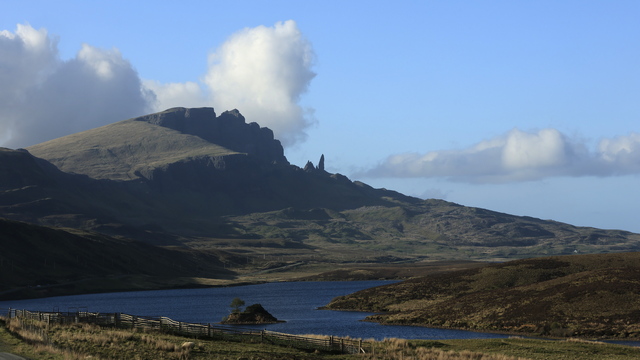
After dinner when the parking lot was a lot quieter we decided to hike up and look at the Old Man of Storr. This photo was taken as we drove toward the Old Man of Storr.
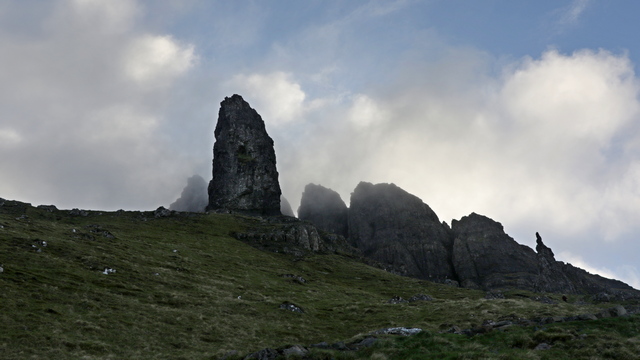
The mist was starting to roll in.
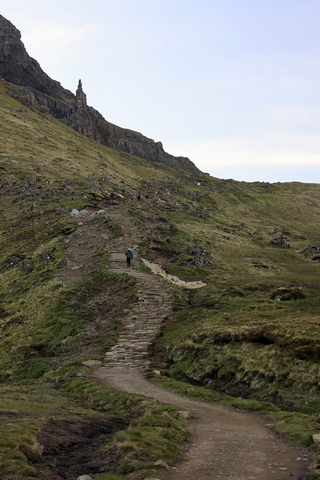
The little person in the photo is Ed climbing the stairs. It was pretty much a straight uphill hike. Going down was a lot easier.






Even the sheep enjoy the view. That little white bump beside the sheep is a lamb.

Probably the worst section of the hike was right at the end. It was quite steep and you were walking through thigh deep ruts.

After we left the Quiraing we decided to check out a beach. The beaches here are a bit rocky, well this one at least.

Walking back to the car from the beach we notice these two staring at us.

The scenery on the Isle of Skye is just amazing.



After dinner when the parking lot was a lot quieter we decided to hike up and look at the Old Man of Storr. This photo was taken as we drove toward the Old Man of Storr.

The mist was starting to roll in.

The little person in the photo is Ed climbing the stairs. It was pretty much a straight uphill hike. Going down was a lot easier.
2023/05/08: Fort Augustus to Skye
Category: General
Posted by: The Agnew Family
Once again we woke to a drizzly morning.
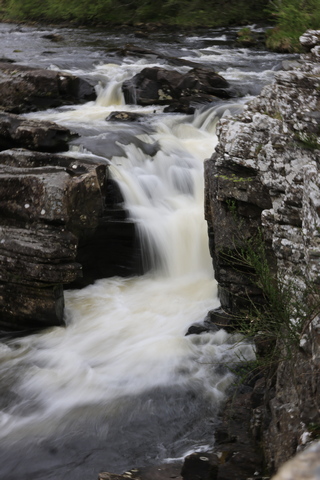
The Morriston falls just outside of Invermoriston. It's just a small waterfall but the water just poured off of it.
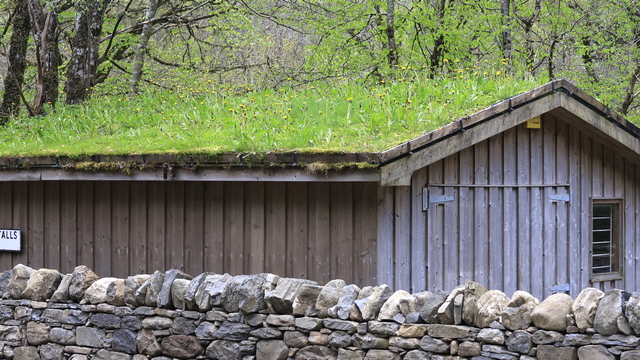
Walking back from the waterfalls to the parking lot we saw this roof. I wonder if the owner uses a lawnmower or a grass trimmer or leaves it wild?
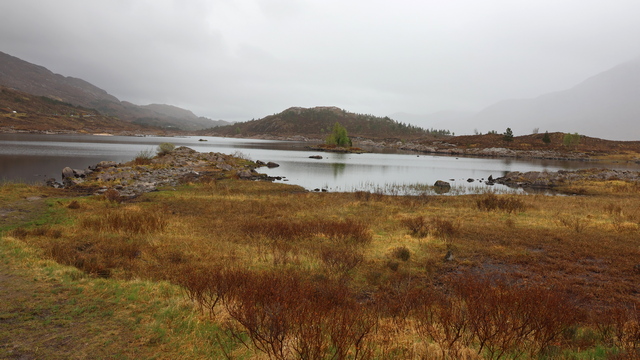
A scene along the highway ... by the way it started raining as we got out of the car.
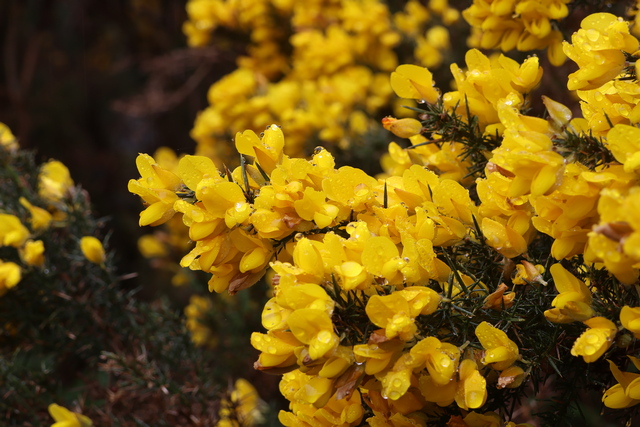
A little bit of colour for a dull day.
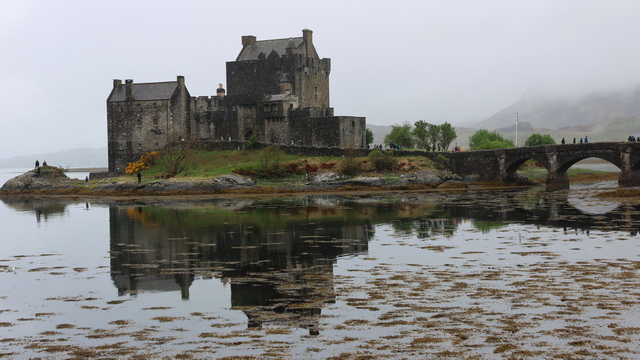
In Dornie is the Eileen Donan Castle. The guide book says the castle was built between 1912 and 1932 so the interior is not worth a visit. It does say the outside is definitely worth a photo. The current owner of the castle lives in the castle.
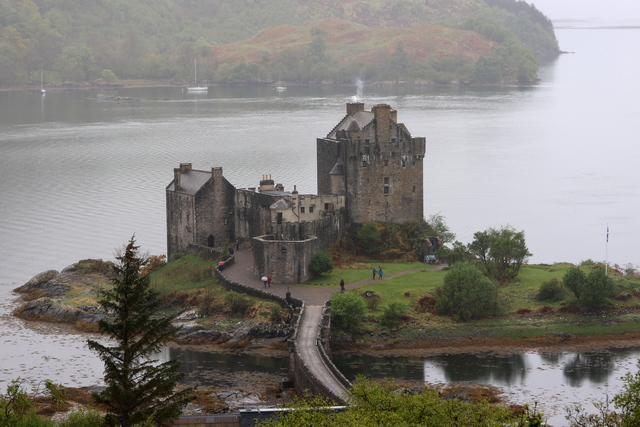
In case you are wondering, yes we are geocaching everyday. Looking for a cache took us up a back road where there was a great view of the castle.
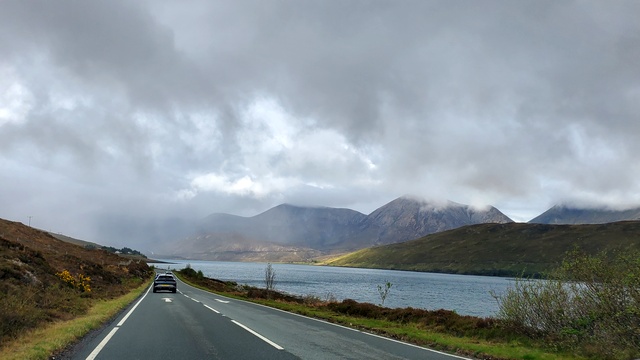
It's starting to brighten up a bit and we've seen hints of blue sky.
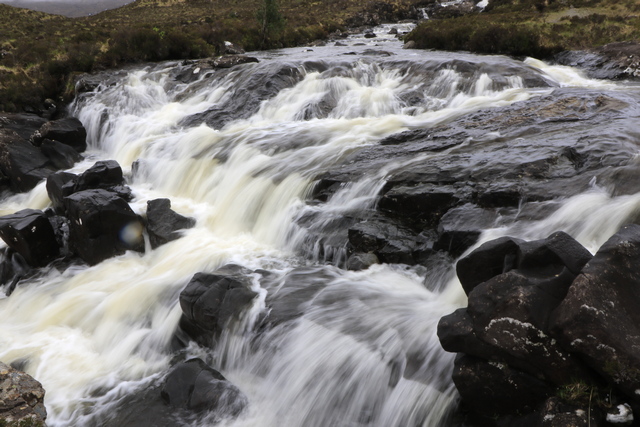
We made it to the Isle of Skye. This is the top of the Sligachan Falls in Sligachan.
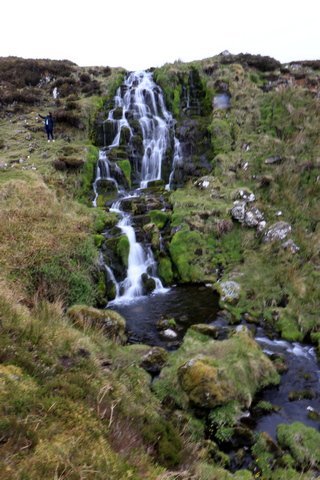
Bride's Veil Falls.
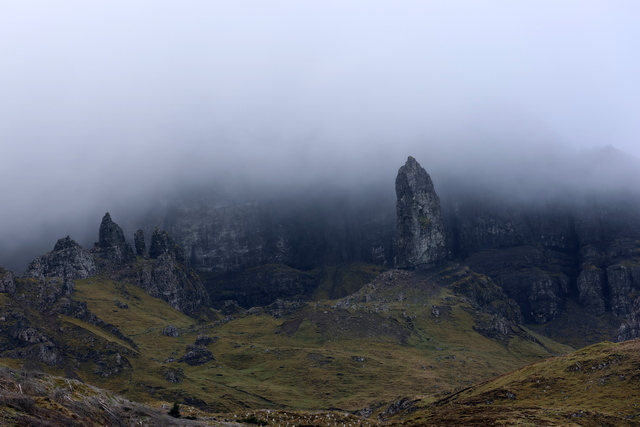
The first time we drove past the Old Man of Storr today you couldn't see anything. So when we drove past it again and could actually see it we stopped and took a photo.
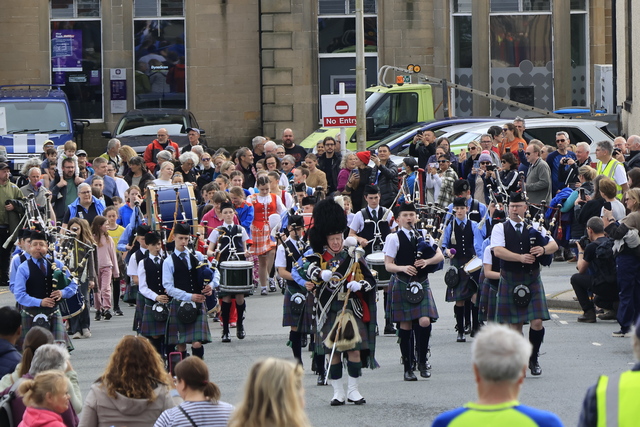
When we drove into Portree we were stopped --- the pipers were walking down the street with people following them. It was part of the coronation ceremony.
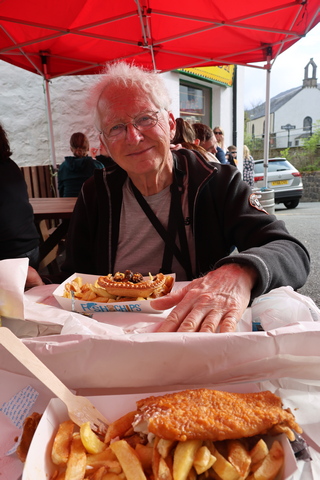
I don't post food pictures but I'm making an exception today. We're sitting outside in the sun!!!!!! It was so wonderful to enjoy a meal outside.
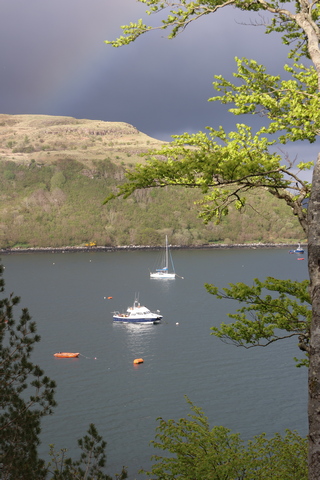
Sun on the boats in Portree harbour. If you look carefully you can see a rainbow.
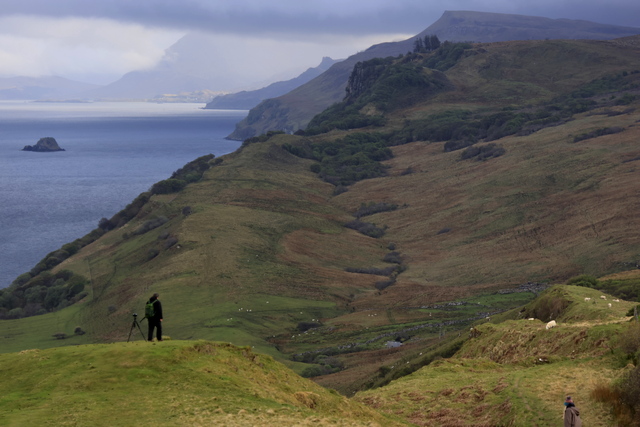
The coast near Lealt falls. The sun doesn't set till after 9 pm so we can still stop and see sights after dinner.
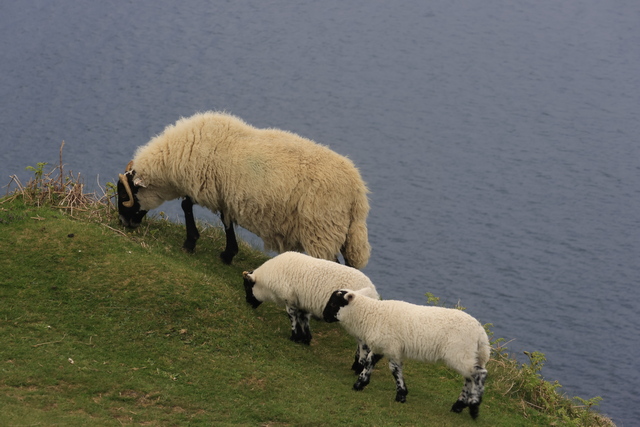
Everywhere you go you are watching for sheep dung or cow patties. Here's some of the manufacturers.
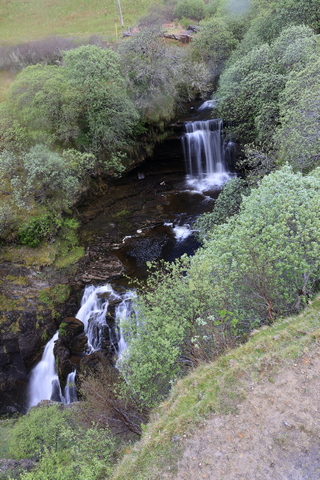
Lealt Falls.

The Morriston falls just outside of Invermoriston. It's just a small waterfall but the water just poured off of it.

Walking back from the waterfalls to the parking lot we saw this roof. I wonder if the owner uses a lawnmower or a grass trimmer or leaves it wild?

A scene along the highway ... by the way it started raining as we got out of the car.

A little bit of colour for a dull day.

In Dornie is the Eileen Donan Castle. The guide book says the castle was built between 1912 and 1932 so the interior is not worth a visit. It does say the outside is definitely worth a photo. The current owner of the castle lives in the castle.

In case you are wondering, yes we are geocaching everyday. Looking for a cache took us up a back road where there was a great view of the castle.

It's starting to brighten up a bit and we've seen hints of blue sky.

We made it to the Isle of Skye. This is the top of the Sligachan Falls in Sligachan.

Bride's Veil Falls.

The first time we drove past the Old Man of Storr today you couldn't see anything. So when we drove past it again and could actually see it we stopped and took a photo.

When we drove into Portree we were stopped --- the pipers were walking down the street with people following them. It was part of the coronation ceremony.

I don't post food pictures but I'm making an exception today. We're sitting outside in the sun!!!!!! It was so wonderful to enjoy a meal outside.

Sun on the boats in Portree harbour. If you look carefully you can see a rainbow.

The coast near Lealt falls. The sun doesn't set till after 9 pm so we can still stop and see sights after dinner.

Everywhere you go you are watching for sheep dung or cow patties. Here's some of the manufacturers.

Lealt Falls.
2023/05/07: Oban to Fort Augustus
Category: General
Posted by: The Agnew Family
Today we are driving from Oban to Fort Augustus with a small detour to the Glen Coe glen. As usual for the morning it's overcast and a little drizzly.
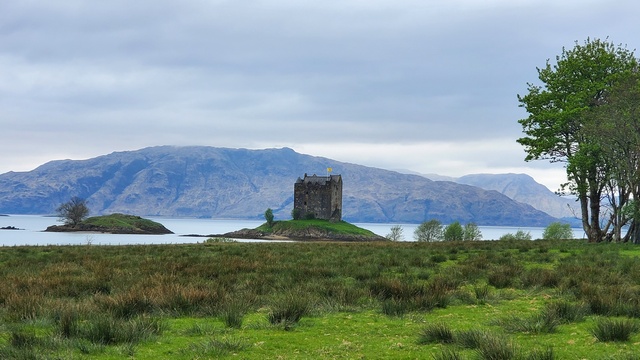
Castle Stalker is on a small island.
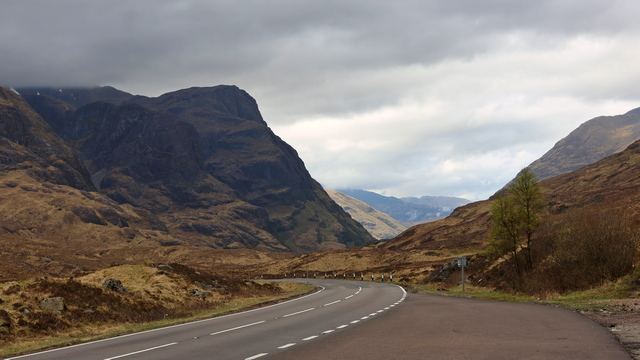
The Glen Coe glen was very busy. Not only did you have the tourists but there were also a lot of Scots enjoying the Sunday of a three day weekend. The rain doesn't stop the Scots from going for a hike or a picnic.
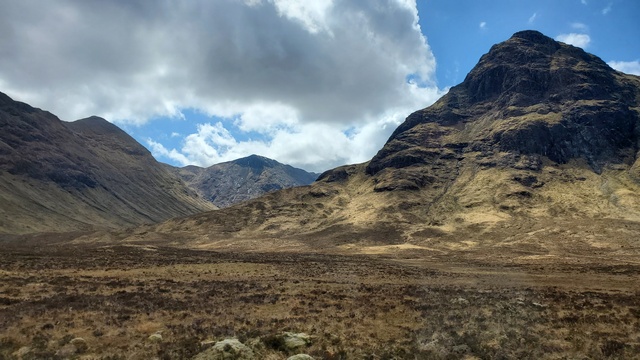
Afternoon brought some sunshine and increased visibility.
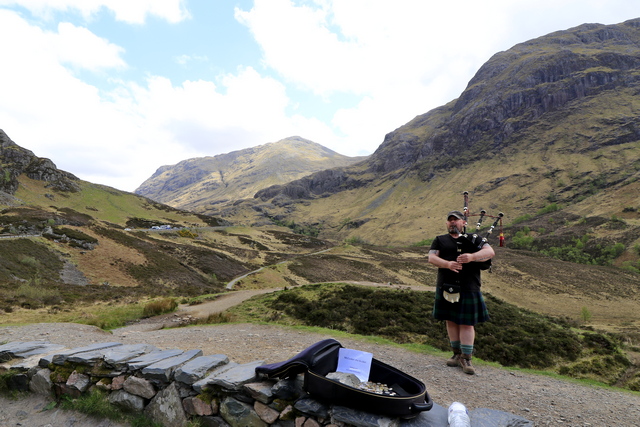
The three sisters is a famous set of mountains in the Glen Coe glen. A piper added to the ambiance.
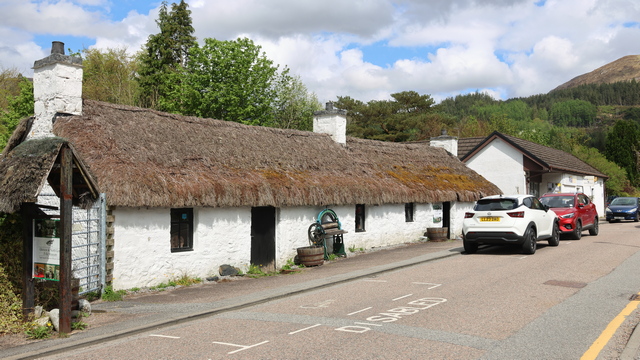
Glencoe is a tiny hamlet with some interesting homes.
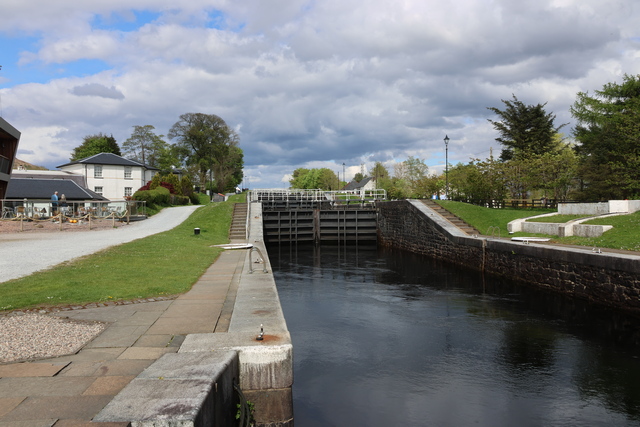
As we continued the drive north we stopped at Neptune's Staircase new Fort William. "Neptune's Staircase is a staircase lock comprising eight locks on the Caledonian Canal. Built by Thomas Telford between 1803 and 1822, it is the longest staircase lock in Britain. The system was originally hand-powered but has been converted to hydraulic operation." Thanks wikipedia.
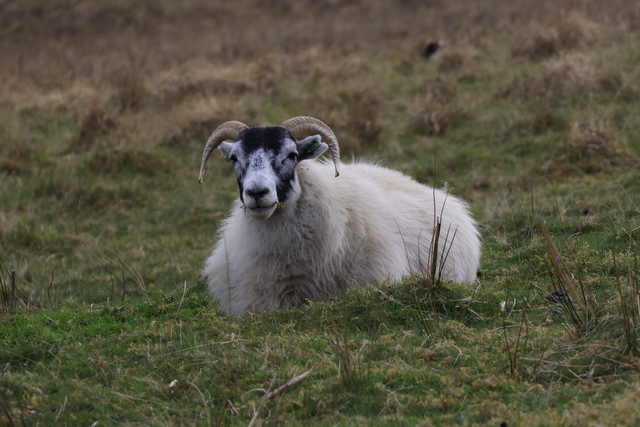
At a stop on the way to Fort Augustus we saw this sheep was just hanging out near the road.
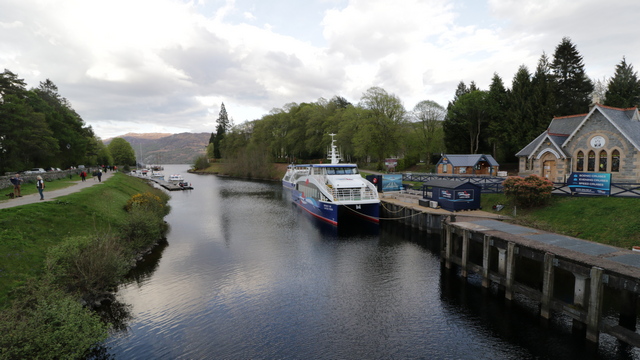
Fort Augustus is at the bottom of Loch Ness and the Caledonian canal runs through it. This is looking up the canal into Loch Ness.
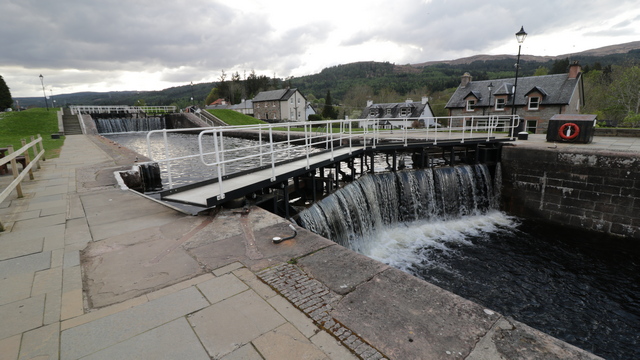
A couple of the locks. The Caledonian Canal is 60 miles long running from Inverness (north end of Loch Ness) to to Corpach (near Fort William).

Castle Stalker is on a small island.

The Glen Coe glen was very busy. Not only did you have the tourists but there were also a lot of Scots enjoying the Sunday of a three day weekend. The rain doesn't stop the Scots from going for a hike or a picnic.

Afternoon brought some sunshine and increased visibility.

The three sisters is a famous set of mountains in the Glen Coe glen. A piper added to the ambiance.

Glencoe is a tiny hamlet with some interesting homes.

As we continued the drive north we stopped at Neptune's Staircase new Fort William. "Neptune's Staircase is a staircase lock comprising eight locks on the Caledonian Canal. Built by Thomas Telford between 1803 and 1822, it is the longest staircase lock in Britain. The system was originally hand-powered but has been converted to hydraulic operation." Thanks wikipedia.

At a stop on the way to Fort Augustus we saw this sheep was just hanging out near the road.

Fort Augustus is at the bottom of Loch Ness and the Caledonian canal runs through it. This is looking up the canal into Loch Ness.

A couple of the locks. The Caledonian Canal is 60 miles long running from Inverness (north end of Loch Ness) to to Corpach (near Fort William).
2023/05/06: Staffa and Lunga (one of the Treshnish Islands)
Category: General
Posted by: The Agnew Family
Today we are taking a ferry to Mull where we are being picked up and driven north and across the island to Ulva Ferry. Here we get on a smaller boat for our trip to Staffa and Lunga.
It is a little windy and overcast this morning but there are still a few things to see and photograph from the ferry.
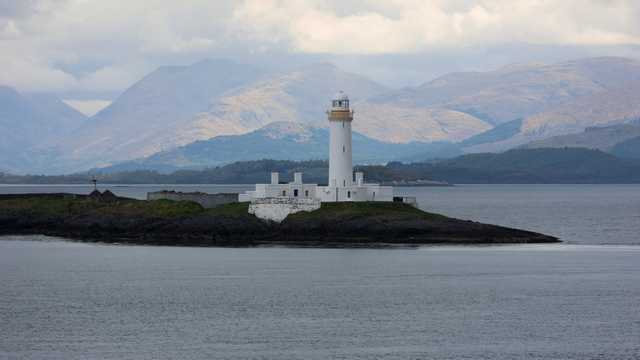
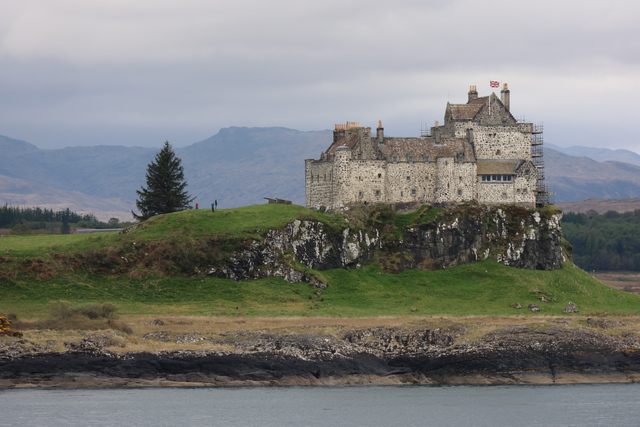
After we get off of the ferry we are picked up with 12 other people and driven across Mull. It's still overcast so not the best views but it is a pretty island. The first part of the drive is on a 2 lane road, then as we cross the island we go down to a 1 lane road. This is pretty interesting as the roads wind up and down and around the hills. After about 40 minutes we arrive at Ulva Ferry, a hamlet, and get on a 40 foot boat that can hold between 50 and 60 passengers (I think there were about 30 people on board). We were warned that the ride might be a bumpy but it actually wasn't too bad. Our first stop is Staffa.
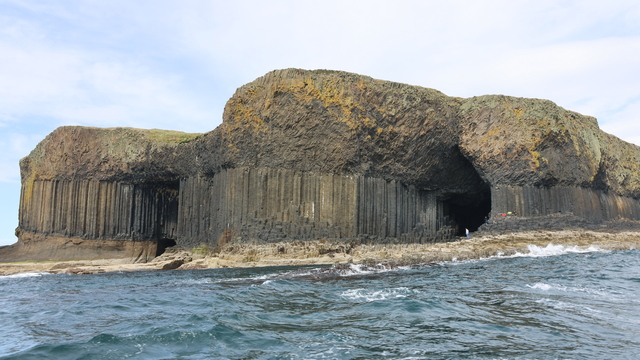
Staffa is know for it's Basalt Rocks (rock columns) and the astonishing acoustics of Fingal’s Cave, which inspired Mendelssohn to compose his Hebrides Overture. Unfortunately, we didn't get to go into the cave because the steps are being repaired but our captain nudged the boat into the mouth of the cave and played the Hebrides Overture. This photo is out in front of the caves. Another interesting thing about these rocks is that it is the same rock formation that makes up the Giant's causeway in Ireland. Some scientists say that if you drained the water you would be able to walk from Ireland to Scotland along the basalt rocks.
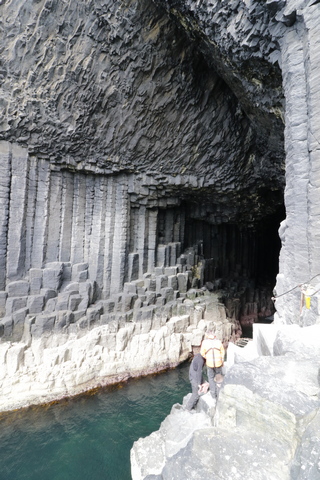
We walked on the basalt columns to the cave and peaked inside. Workmen were there repairing the steps.
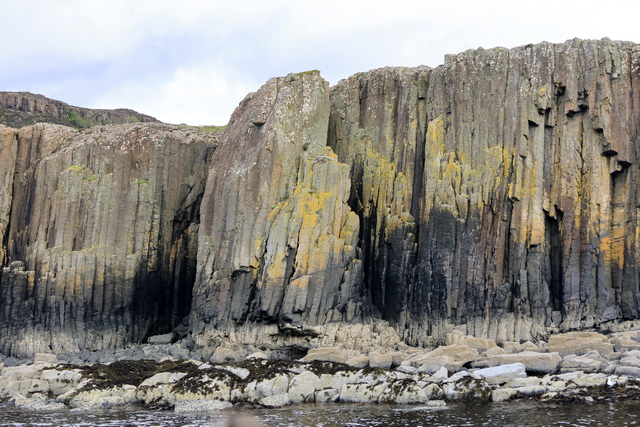
Another view of the basalt columns.
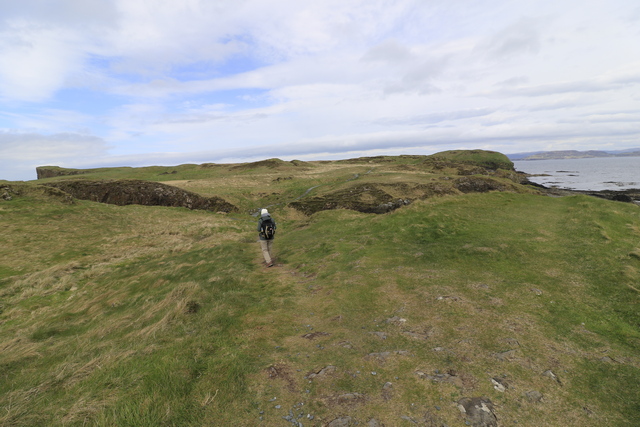
The top of Staffa is quite flat.
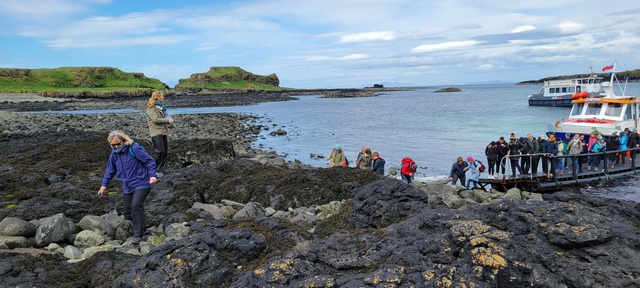
There isn't a dock on Lunga. Instead there are floating platforms moored off shore. A platform is tied to the boat, then the boat noses into the rocky beach. The passengers walk along the platform then step off onto the rocks.
One thing we noticed is the birds did not fear us. When we were walking down the path there were times the birds were only a couple of feet away from us. It also felt like some of the birds were actually posing for the camera.
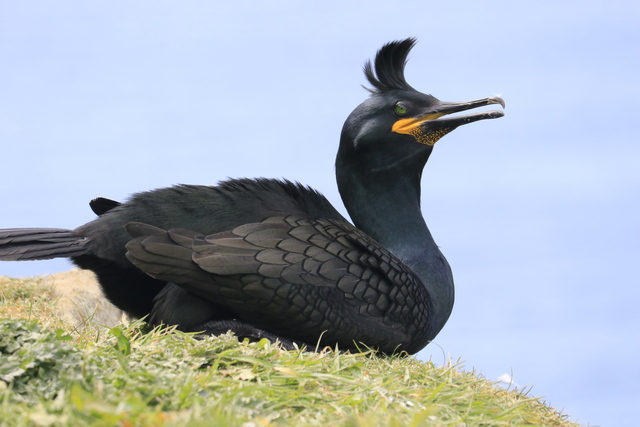
One of the birds that nest on Lunga is the European Shag.
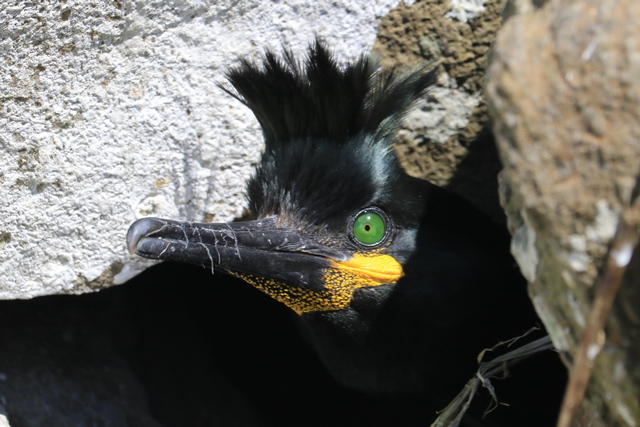
Ed loved the bright green eyes.
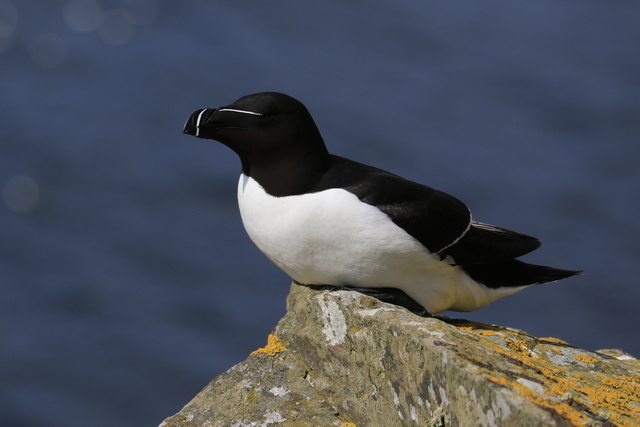
The razorbill also nests on Lunga.
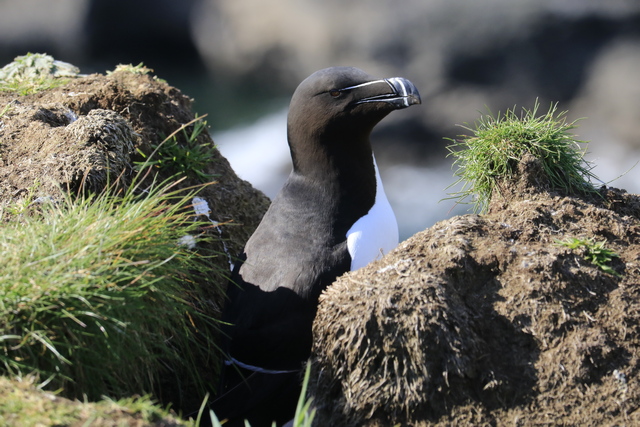
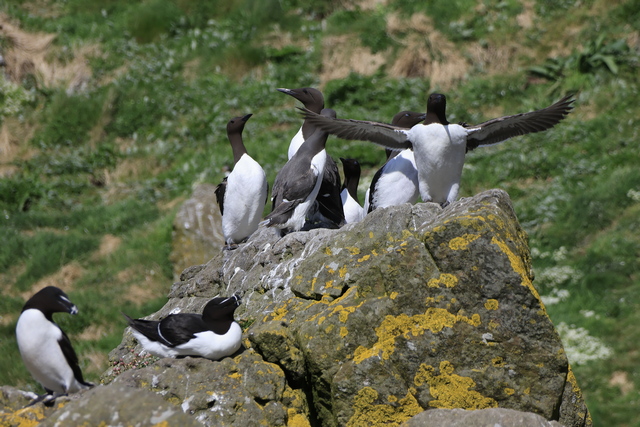
The birds in the top part of the photo are common guillemont. Razor bills are the bottom two birds. Thousands of common guillemonts were on the bottom half of a cliff. They were making lots of noise.
I got a little carried away with Atlantic Puffin photos. Puffins live at sea for most the year. In mid April they come to shore to breed. Their nests are in burrows in the side or tops of cliffs. Around mid July the puffins head back out to see.
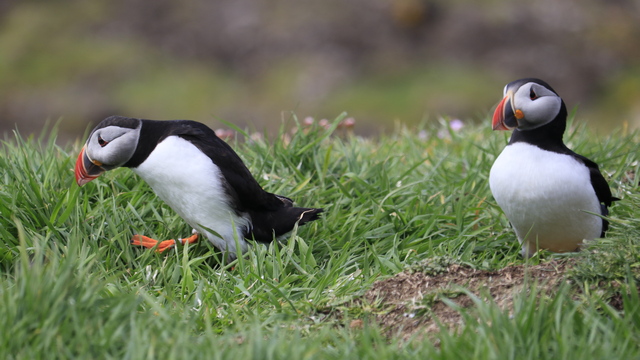
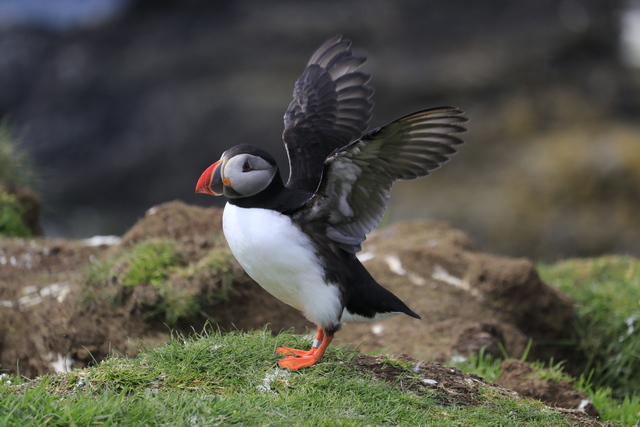
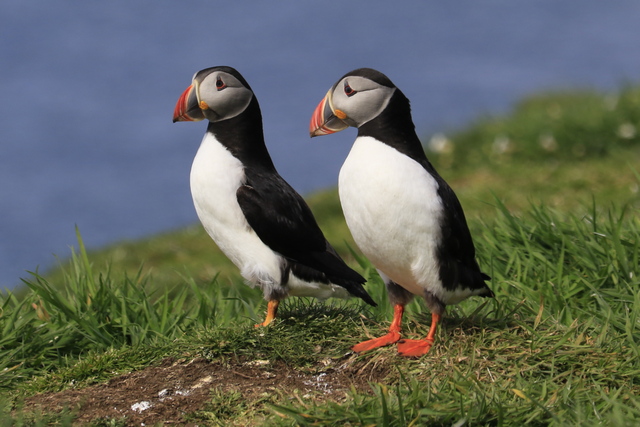
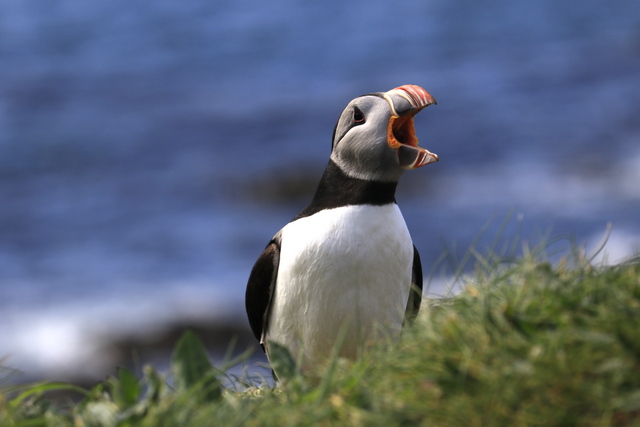
The puffin just opened his mouth. We could hear the other birds but the puffins didn't make any noise.
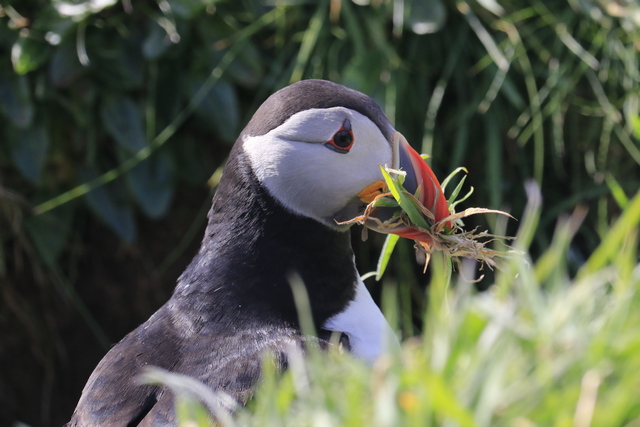
This puffin was ripping up grass and taking into her burrow.
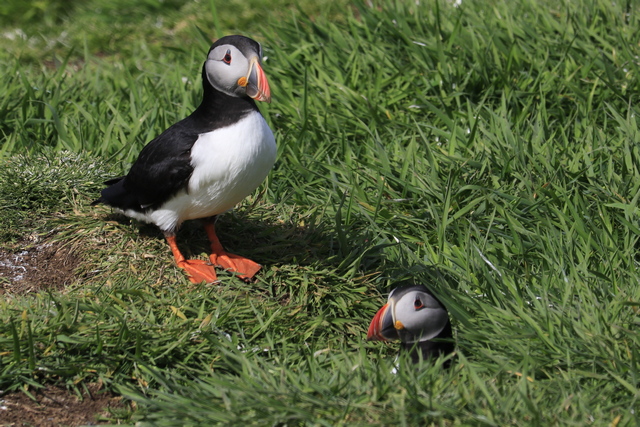
The lower puffin is coming out of the burrow.
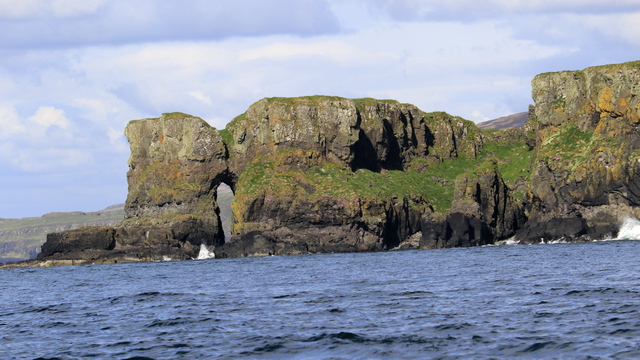
On our way back to Ulva ferry we passed this island. Thought it looked interesting. After we arrived in Ulva ferry it was back on the mini bus for a ride to the ferry terminal. Now that it was sunny we had amazing scenery for the drive.
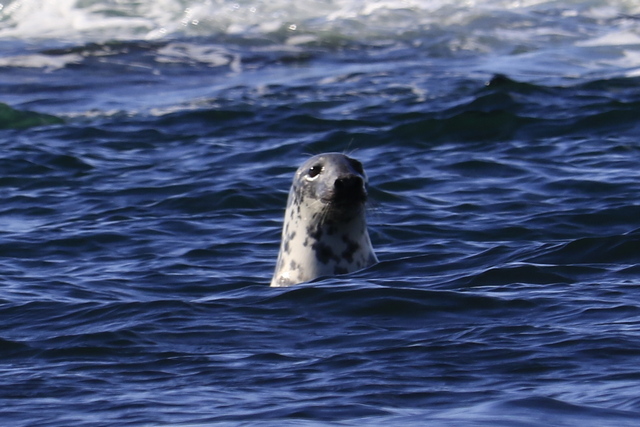
We also some a number of grey seals.
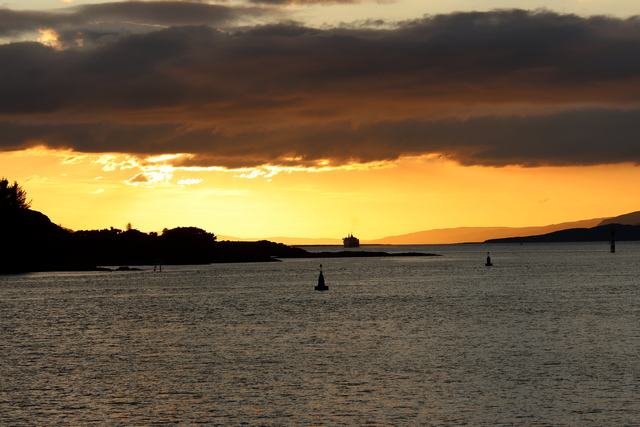
Back in Oban we watch one of the ferries sail off into the sunset.
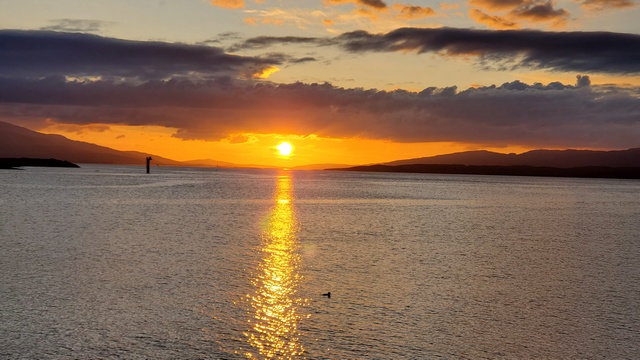
Beautiful sunset tonight.
It is a little windy and overcast this morning but there are still a few things to see and photograph from the ferry.


After we get off of the ferry we are picked up with 12 other people and driven across Mull. It's still overcast so not the best views but it is a pretty island. The first part of the drive is on a 2 lane road, then as we cross the island we go down to a 1 lane road. This is pretty interesting as the roads wind up and down and around the hills. After about 40 minutes we arrive at Ulva Ferry, a hamlet, and get on a 40 foot boat that can hold between 50 and 60 passengers (I think there were about 30 people on board). We were warned that the ride might be a bumpy but it actually wasn't too bad. Our first stop is Staffa.

Staffa is know for it's Basalt Rocks (rock columns) and the astonishing acoustics of Fingal’s Cave, which inspired Mendelssohn to compose his Hebrides Overture. Unfortunately, we didn't get to go into the cave because the steps are being repaired but our captain nudged the boat into the mouth of the cave and played the Hebrides Overture. This photo is out in front of the caves. Another interesting thing about these rocks is that it is the same rock formation that makes up the Giant's causeway in Ireland. Some scientists say that if you drained the water you would be able to walk from Ireland to Scotland along the basalt rocks.

We walked on the basalt columns to the cave and peaked inside. Workmen were there repairing the steps.

Another view of the basalt columns.

The top of Staffa is quite flat.

There isn't a dock on Lunga. Instead there are floating platforms moored off shore. A platform is tied to the boat, then the boat noses into the rocky beach. The passengers walk along the platform then step off onto the rocks.
One thing we noticed is the birds did not fear us. When we were walking down the path there were times the birds were only a couple of feet away from us. It also felt like some of the birds were actually posing for the camera.

One of the birds that nest on Lunga is the European Shag.

Ed loved the bright green eyes.

The razorbill also nests on Lunga.


The birds in the top part of the photo are common guillemont. Razor bills are the bottom two birds. Thousands of common guillemonts were on the bottom half of a cliff. They were making lots of noise.
I got a little carried away with Atlantic Puffin photos. Puffins live at sea for most the year. In mid April they come to shore to breed. Their nests are in burrows in the side or tops of cliffs. Around mid July the puffins head back out to see.




The puffin just opened his mouth. We could hear the other birds but the puffins didn't make any noise.

This puffin was ripping up grass and taking into her burrow.

The lower puffin is coming out of the burrow.

On our way back to Ulva ferry we passed this island. Thought it looked interesting. After we arrived in Ulva ferry it was back on the mini bus for a ride to the ferry terminal. Now that it was sunny we had amazing scenery for the drive.

We also some a number of grey seals.

Back in Oban we watch one of the ferries sail off into the sunset.

Beautiful sunset tonight.
2023/05/05: Luss, Inveraray, Kilmartin Glen and Oban
Category: General
Posted by: The Agnew Family
It was raining lightly when we got up this morning and continued as we started today's journey.
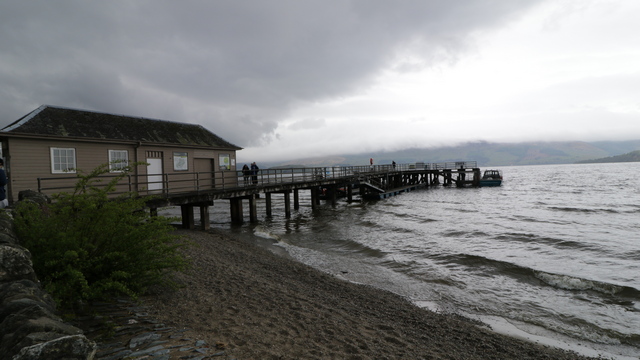
First stop was Luss on Loch Lomond. The main reason to stop here was to revisit a view Ed remembers from 25 years ago --- the main pier. Only obvious difference is the missing piper. We'll have to check the old photo but I think it was overcast that day as well.
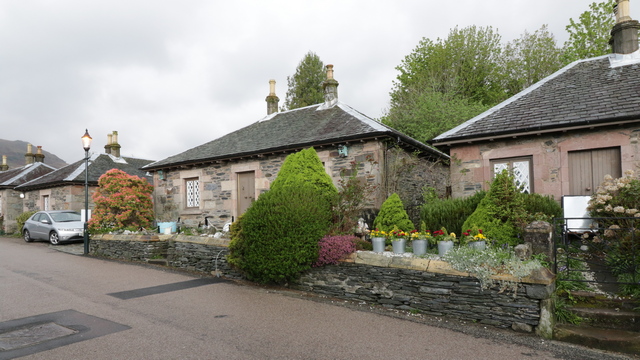
Luss really is a cute town with really cute houses.
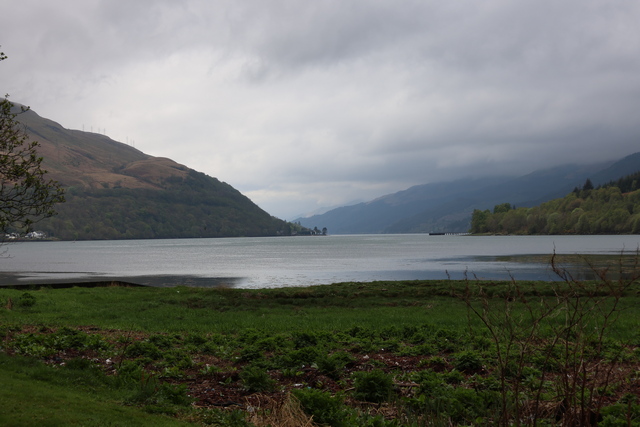
Ed stopped for a geocache in a parking lot beside a lake so I took a few photos.
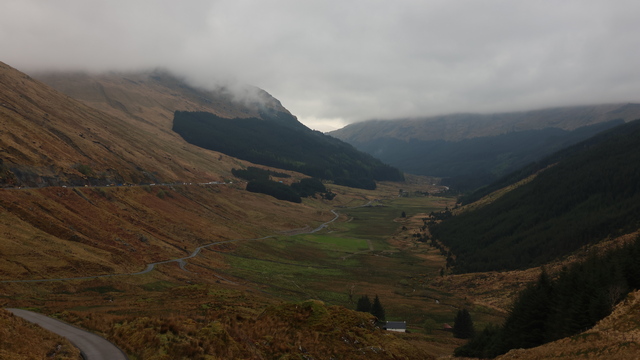
The view at the Rest and Be Thankful viewpoint.
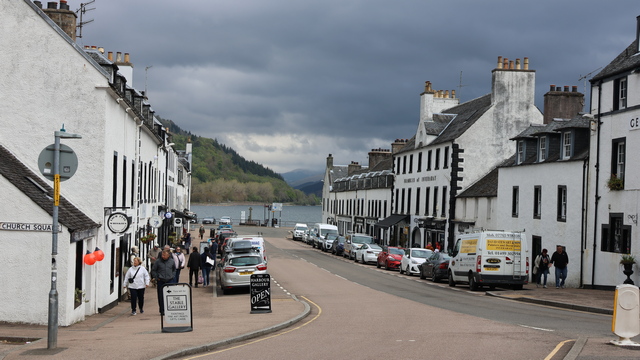
Inveraray is on the western shore of Loch Fyne,
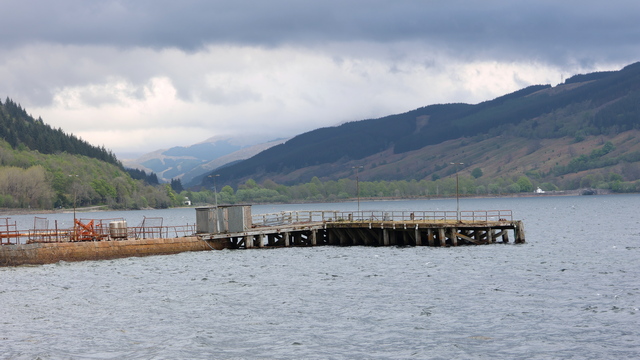
The pier on Loch Fyne.
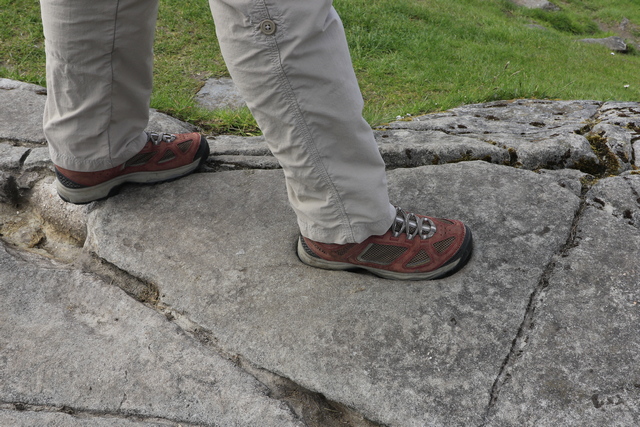
My foot is the same size as the carving .... does this mean I'm king?
Many ancient sites have been found in Kilmartin Glen. One of them is Dunadsd which was the seat of power of the 1st kings of Dal Riata (this may have been where the stone of destiny was originally located). In this site is a footprint in a stone which is thought to have formed part of Dál Riata's coronation ritual. This site is referred to as Dunadd Fort.
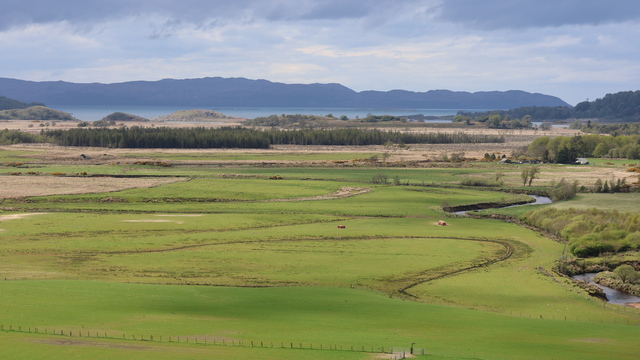
The view from the top of the Dunadd Fort.
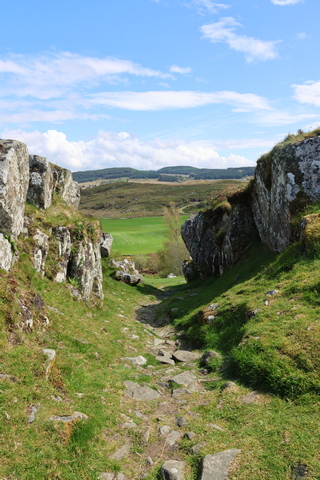
The view walking down from the Dunadd Fort.
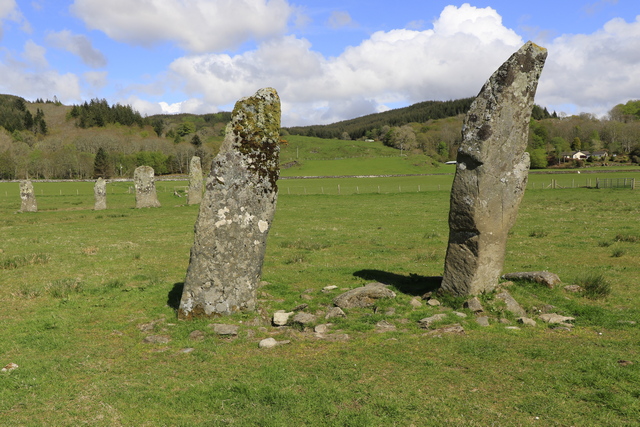
A few miles down the road from Dunadd is Dunchraigaig cairn and a five minute walk along a path in a farmers field is Ballymeanoch with a avenue of two rows of standing stones with 2 and 4 stones each, a stone circle and a henge with a small burial cairn. According to the Historic Environment Scotland marker at the site, the circle and standing stones are the older structures and their construction dates back to over 4000 years ago.
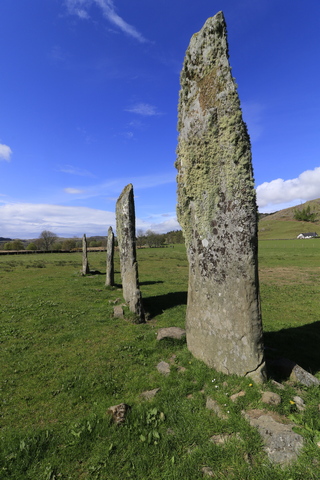
The stones again. Yes it turned sunny and warm!!!
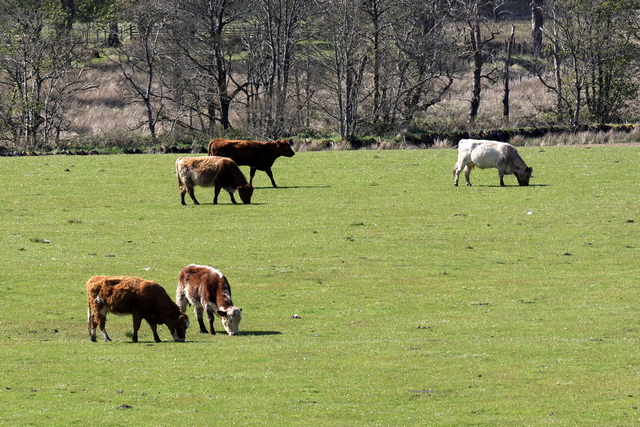
Some cows in the adjacent field --- yes we had to watch for cow patty's when we walked to the standing stones.
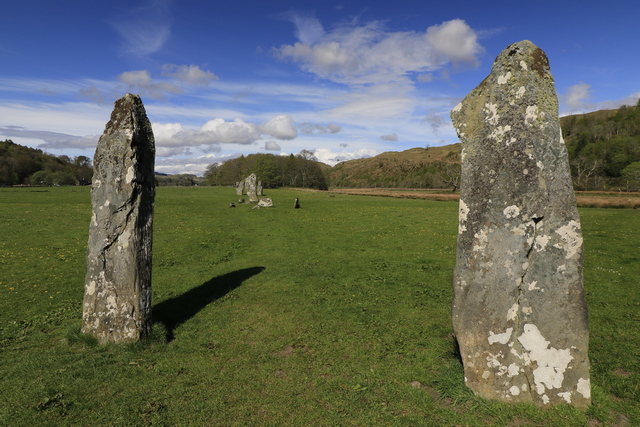
At another nearby site are the Nether Largie Standing Stones. These stones are what remain from a large group of stones thought to be place 3200 years ago.
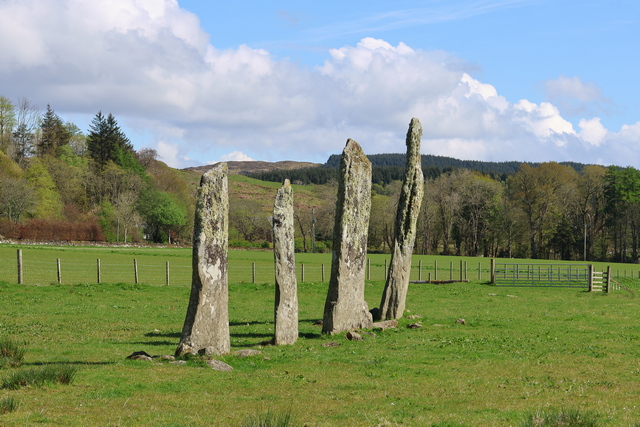
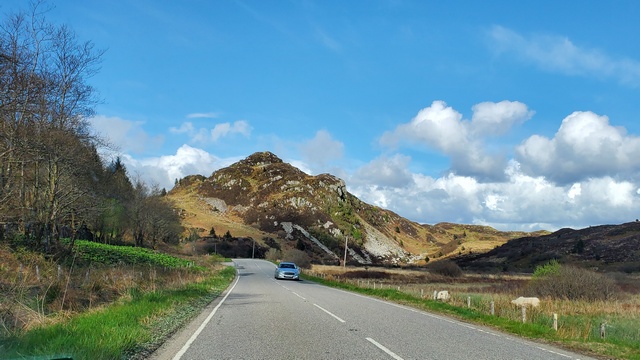
A view as we were driving beautiful drive
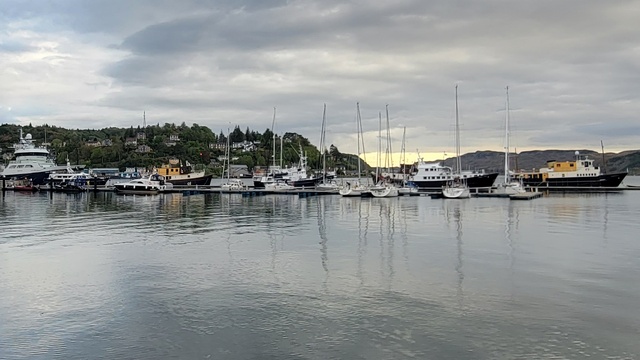
Oban harbour, actually a small part of it. A number of ferries to various islands run out of this port.

First stop was Luss on Loch Lomond. The main reason to stop here was to revisit a view Ed remembers from 25 years ago --- the main pier. Only obvious difference is the missing piper. We'll have to check the old photo but I think it was overcast that day as well.

Luss really is a cute town with really cute houses.

Ed stopped for a geocache in a parking lot beside a lake so I took a few photos.

The view at the Rest and Be Thankful viewpoint.

Inveraray is on the western shore of Loch Fyne,

The pier on Loch Fyne.

My foot is the same size as the carving .... does this mean I'm king?
Many ancient sites have been found in Kilmartin Glen. One of them is Dunadsd which was the seat of power of the 1st kings of Dal Riata (this may have been where the stone of destiny was originally located). In this site is a footprint in a stone which is thought to have formed part of Dál Riata's coronation ritual. This site is referred to as Dunadd Fort.

The view from the top of the Dunadd Fort.

The view walking down from the Dunadd Fort.

A few miles down the road from Dunadd is Dunchraigaig cairn and a five minute walk along a path in a farmers field is Ballymeanoch with a avenue of two rows of standing stones with 2 and 4 stones each, a stone circle and a henge with a small burial cairn. According to the Historic Environment Scotland marker at the site, the circle and standing stones are the older structures and their construction dates back to over 4000 years ago.

The stones again. Yes it turned sunny and warm!!!

Some cows in the adjacent field --- yes we had to watch for cow patty's when we walked to the standing stones.

At another nearby site are the Nether Largie Standing Stones. These stones are what remain from a large group of stones thought to be place 3200 years ago.


A view as we were driving beautiful drive

Oban harbour, actually a small part of it. A number of ferries to various islands run out of this port.
2023/05/04: Falkirk, Stirling and Balloch
Category: General
Posted by: The Agnew Family
Falkirk has 2 interesting sites on the canal system. Yesterday we saw the first one the Kelpies, this morning we saw the second one ---- the Falkirk Wheel.
The Falkirk Wheel is a rotating boat lift in connecting the Forth and Clyde Canal with the Union Canal. It reconnects the two canals for the first time since the 1930s. It opened in 2002 as part of the Millennium Link project. The two canals served by the wheel were previously connected by a series of 11 locks. With a 35-metre (115 ft) difference in height, it required 3,500 tonnes (3,400 long tons; 3,900 short tons) of water per run and took most of a day to pass through the flight. (borrowed from wikipedia)
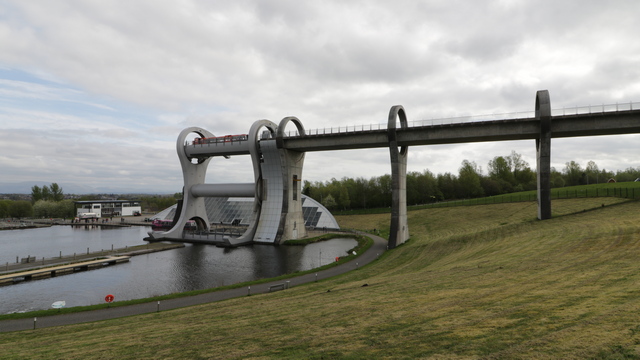
The Falkirk Wheel is the only rotating boat lift of its kind in the world. At the bottom.
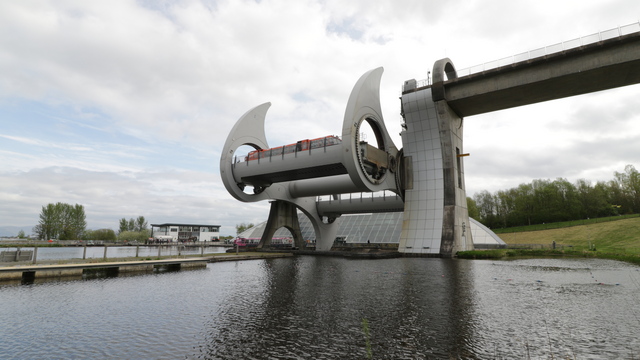
part of the way to the top
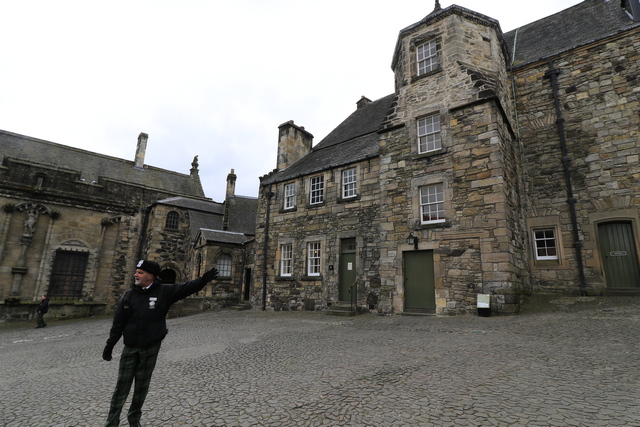
Stirling Castle in the city of Stirling is an important castle in Scottish history and has been the home to many kings and queens (Mary Queen of Scots was born here). It has been destroyed (by one of the kings), rebuilt, added on it over the years. As it is situated between the lowlands and the highlands it's also been the site of many battles. Stirling Castle was first mentioned around 1110. Until the Union of the Crowns in 1603, almost every Scottish monarch had either lived in the castle, or been crowned or died here.
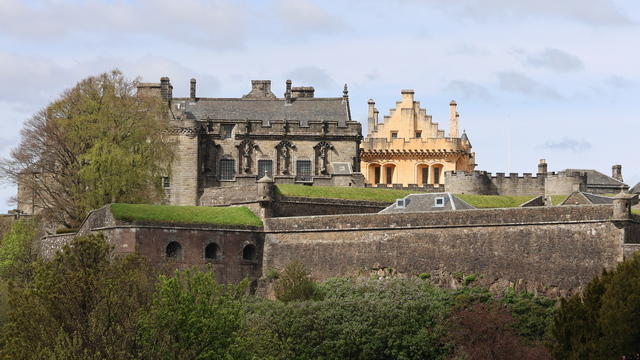
A view from a nearby hill looking at the castle.
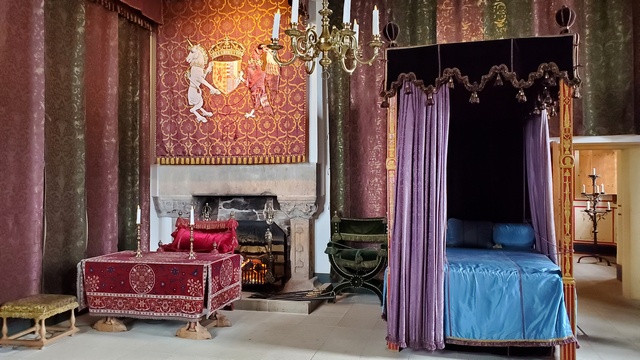
I don't remember which King and Queen built this part of the castle but the Queen's and King's rooms have been restored, including making new tapestries employing talent from several countries. This is the queen's bedroom. The king's rooms have very little in them as he died before he lived in the castle.
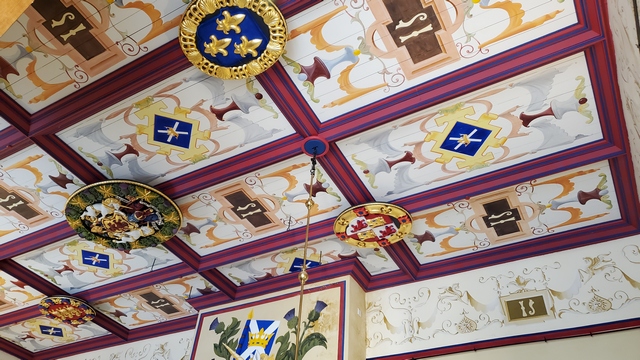
One of the beautiful ceilings.
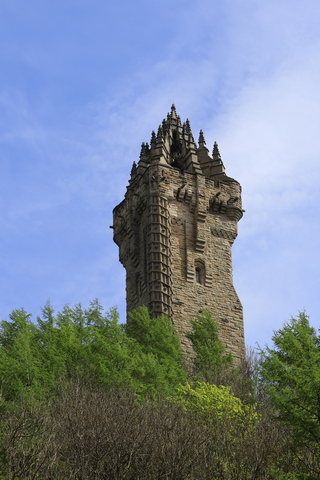
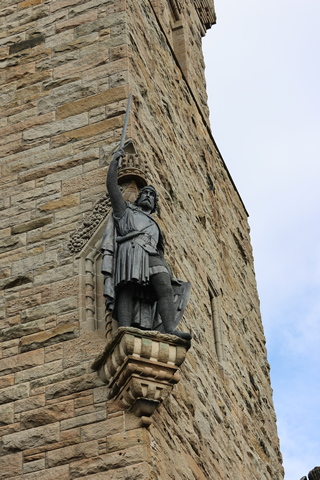
The National Wallace Monument is a 67 metre tower above the fields where William Wallace (a 13th and 14th-century hero) led his troops to victory at the Battle of Stirling Bridge.
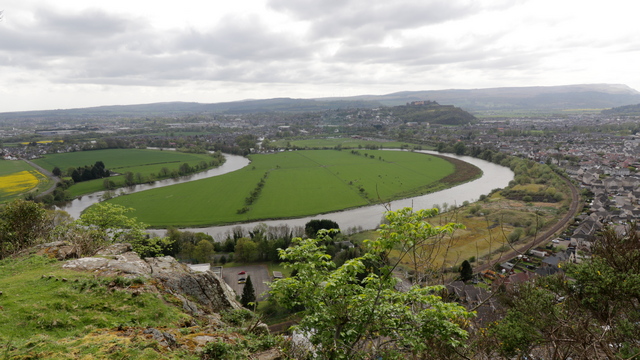
A view from the National Wallace Monument
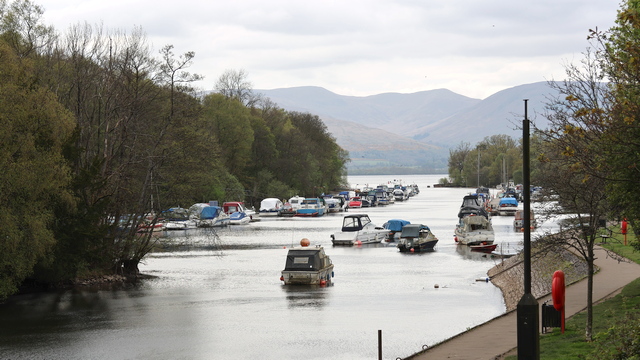
We spent the night in Balloch at the bottom of Lake Lomond.
The Falkirk Wheel is a rotating boat lift in connecting the Forth and Clyde Canal with the Union Canal. It reconnects the two canals for the first time since the 1930s. It opened in 2002 as part of the Millennium Link project. The two canals served by the wheel were previously connected by a series of 11 locks. With a 35-metre (115 ft) difference in height, it required 3,500 tonnes (3,400 long tons; 3,900 short tons) of water per run and took most of a day to pass through the flight. (borrowed from wikipedia)

The Falkirk Wheel is the only rotating boat lift of its kind in the world. At the bottom.

part of the way to the top

Stirling Castle in the city of Stirling is an important castle in Scottish history and has been the home to many kings and queens (Mary Queen of Scots was born here). It has been destroyed (by one of the kings), rebuilt, added on it over the years. As it is situated between the lowlands and the highlands it's also been the site of many battles. Stirling Castle was first mentioned around 1110. Until the Union of the Crowns in 1603, almost every Scottish monarch had either lived in the castle, or been crowned or died here.

A view from a nearby hill looking at the castle.

I don't remember which King and Queen built this part of the castle but the Queen's and King's rooms have been restored, including making new tapestries employing talent from several countries. This is the queen's bedroom. The king's rooms have very little in them as he died before he lived in the castle.

One of the beautiful ceilings.


The National Wallace Monument is a 67 metre tower above the fields where William Wallace (a 13th and 14th-century hero) led his troops to victory at the Battle of Stirling Bridge.

A view from the National Wallace Monument

We spent the night in Balloch at the bottom of Lake Lomond.
2023/05/03: Moving on to Scotland
Category: General
Posted by: The Agnew Family
It looked like a beautiful day when we woke up this morning so of course we are spending the day travelling. Between a flight delay and an issue with the GPS in the rental care which lead to us getting a different car we arrived in Falkirk a little later than expected. Falkirk is a town about 20 minutes from Edinburg airport so we thought that was a far enough drive given we were scheduled to arrive mid afternoon.
Our first stop in Falkirk was the Kelpies. The following but slightly modified was borrowed from wikipedia
he Kelpies are 30-metre-high (98 ft) horse-head sculptures depicting kelpies (shape-shifting water spirits), located between Falkirk and Grangemouth, standing next to a new extension to the Forth and Clyde Canal, and near River Carron. The sculptures were designed by sculptor Andy Scott and were completed in October 2013. The Kelpies are a monument to horse-powered heritage across Scotland.
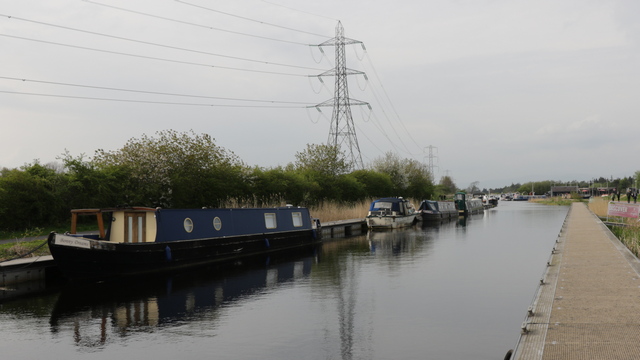
The canal. This brought back a lot of memories. I think it was in 2003 that Ed and I joined some friends and spent a week in a canal boat in western England.
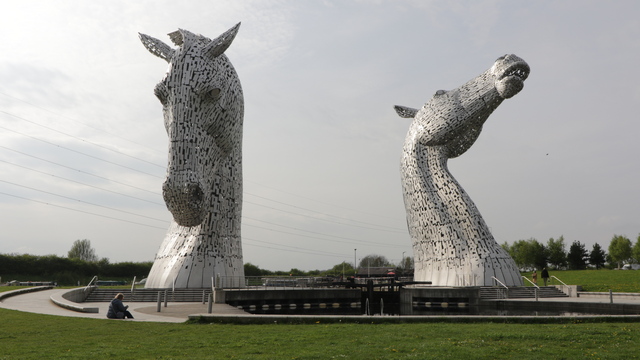
The Kelpies
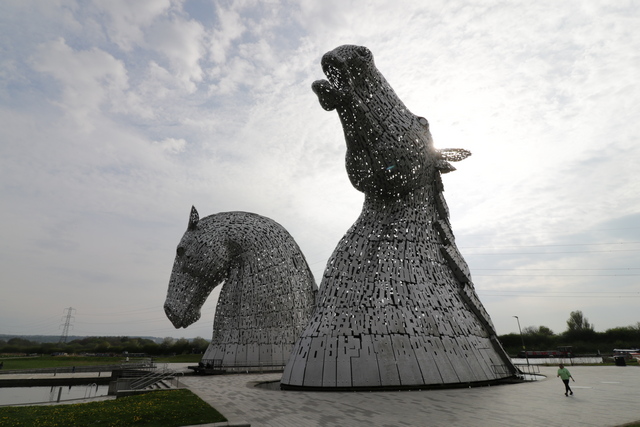
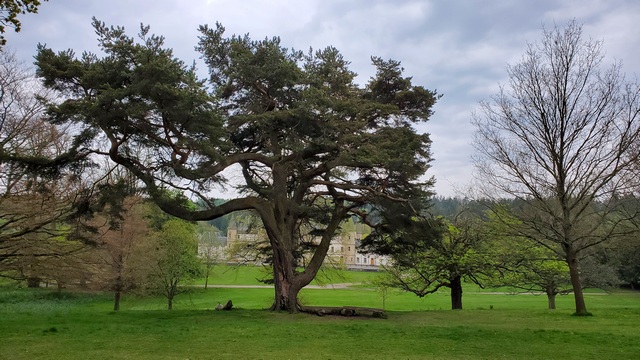
Ed and I rented an Airbnb in Falkirk in Calendar Park, which was once an estate. One of the out buildings has been turned into living accommodations and we're staying in one of the units. It is quite lovely. One of the benefits is that we can walk out the door and go for a walk, which is what we did. I thought this tree was really interesting looking.
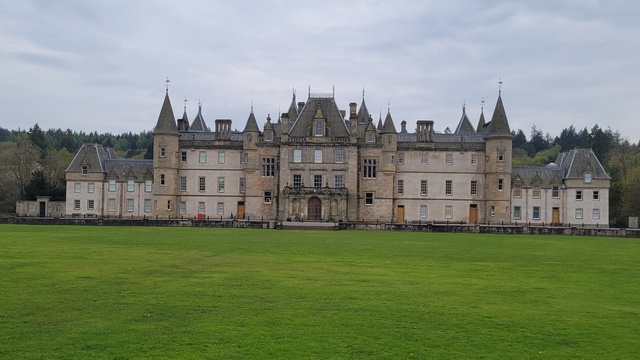
Calendar House
Our first stop in Falkirk was the Kelpies. The following but slightly modified was borrowed from wikipedia
he Kelpies are 30-metre-high (98 ft) horse-head sculptures depicting kelpies (shape-shifting water spirits), located between Falkirk and Grangemouth, standing next to a new extension to the Forth and Clyde Canal, and near River Carron. The sculptures were designed by sculptor Andy Scott and were completed in October 2013. The Kelpies are a monument to horse-powered heritage across Scotland.

The canal. This brought back a lot of memories. I think it was in 2003 that Ed and I joined some friends and spent a week in a canal boat in western England.

The Kelpies


Ed and I rented an Airbnb in Falkirk in Calendar Park, which was once an estate. One of the out buildings has been turned into living accommodations and we're staying in one of the units. It is quite lovely. One of the benefits is that we can walk out the door and go for a walk, which is what we did. I thought this tree was really interesting looking.

Calendar House
2023/05/02: The British Museum and More Walking
Category: General
Posted by: The Agnew Family
Ed and I have travelled in several countries (most recently Egypt) where guides have told us --- this is a replica of the artifact that is in the British Museum. Since we are here in London we though let's see if we can find some of these "original artifacts". We did.
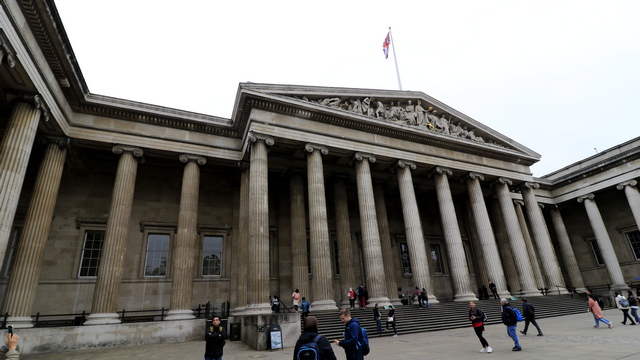
The front entrance of the British Museum. The museum is several floors in height and takes up a few city blocks --- it is huge. We spent 4 hours in the museum and could have probably spent 4 days in it.
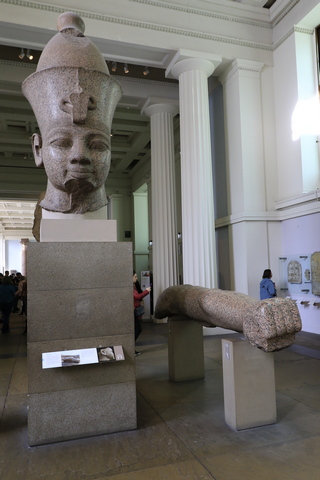
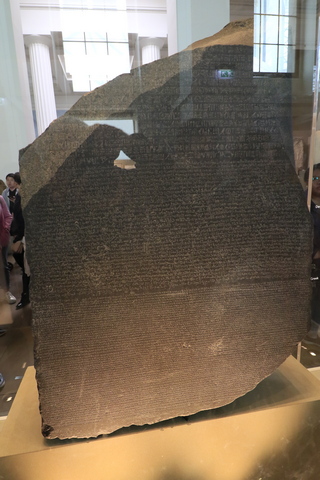
The head and arm of the statue of Amenhotep III is in the British Museum while the torso remains at Karnak where Ed and I saw it. The Rosetta Stone (pictured on the right) doesn't look like much but it has a lot of historical importance (the Rosetta Stone has the same message written in three different languages, Ancient Egyptian hieroglyphs, Demotic script, and Greek script; this helped scholars to translate hieroglyphs). This is the original Rosetta Stone, Ed and I saw a replica in the Cairo Museum. When British forces defeated the French in Egypt, the stone and over a dozen other antiquities were handed over to the British under the terms of an 1801 surrender deal between the generals of the two sides. It has remained in the British Museum since.
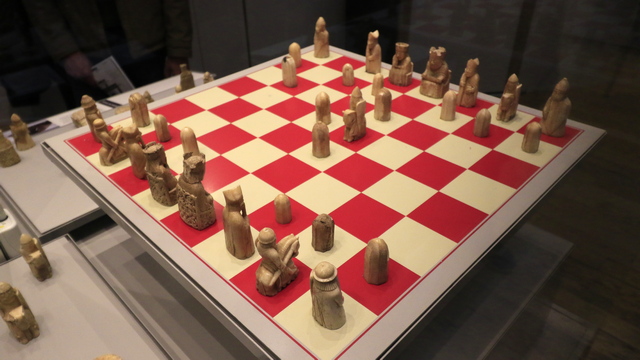
These carved chessmen were found on the Isle of Lewis, one of the places Ed and I are going to visit. The Lewis Chessmen were carved in the 12th century but found in a horde in 1831. These are among the earliest examples in which both bishops and queens are found.
I guess we hadn't spent enough time on our feet after spending 4 hours wandering around the British Museum as we decide to walk to the Tower of London --- about 4 km away if you take a direct route --- we didn't. It was a fabulous walk with lots of surprises.
On the walk was the banking district with some amazing old buildings mixed with modern new structures.
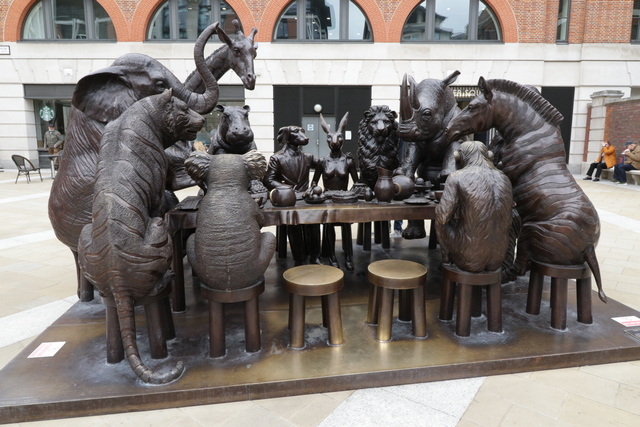
The 'Wild Table Of Love' Animal Sculpture In Paternoster Square. This statue is a temporary and will be leaving May 2023 .... got here just in the nick of time.
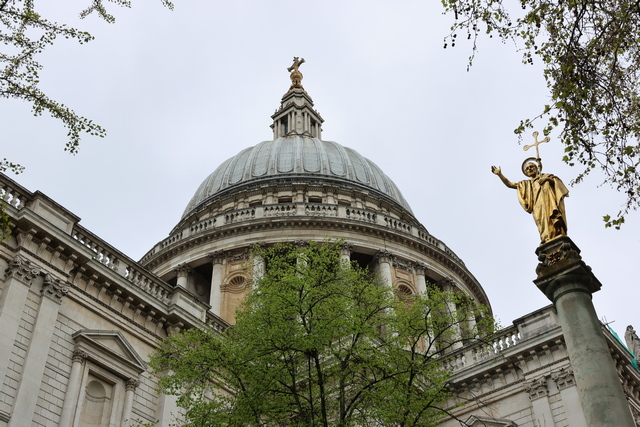
The dome of St. Paul's Cathedral. The cathedral's most distinguishing feature is its lead-covered dome, one of the world's largest and tallest domes.
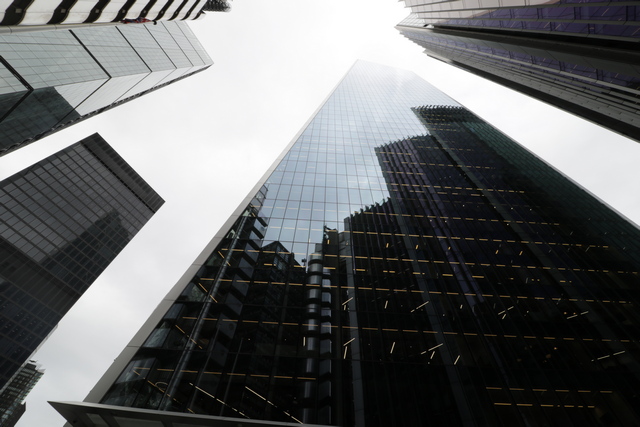
Across from the Lloyd building, which is an amazing structure and worth googling, are several very tall glass buildings that seem to go on forever. You get some interesting imagery with reflections of other buildings. While we were standing and staring at this building, a security guard came outside and told us to go a couple of buildings down where you could take an elevator to the 16th floor and wander a roof top garden get some great views of the city.
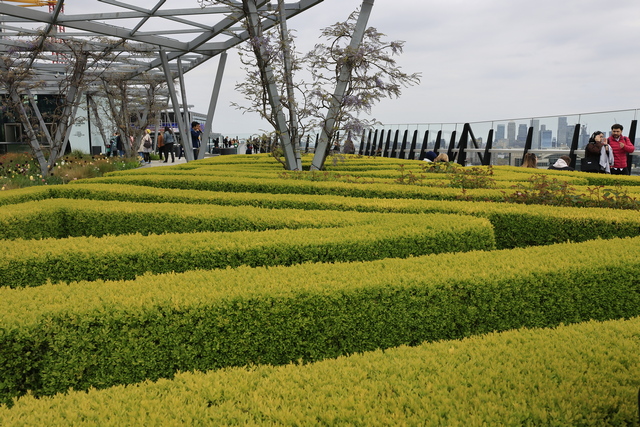
The roof top garden --- it even has a water feature. Trimming the hedge must be a chore.
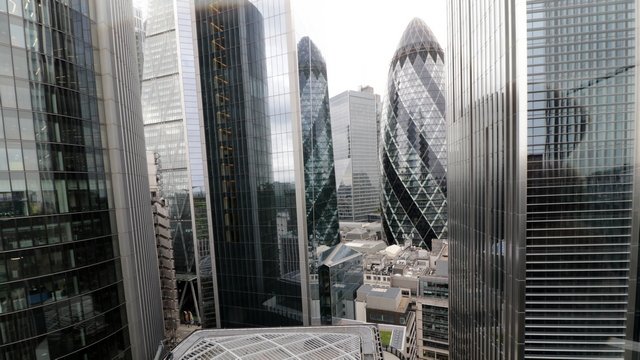
The Gherkin is the round, spiral like building on the right (the left is a reflection). Another building worth googling. From a quick read, it is energy efficient (the shape and all the glass supplies passive solar heating in winter), the shape makes it stable in the wind, and all the glass makes it bright with large open spaces. This building was opened in 2004.
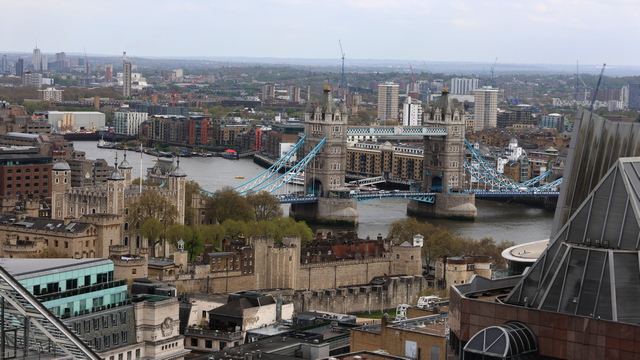
The Tower of London (on the left side about half way up in the photo) and the Tower of London Bridge from the roof top garden.
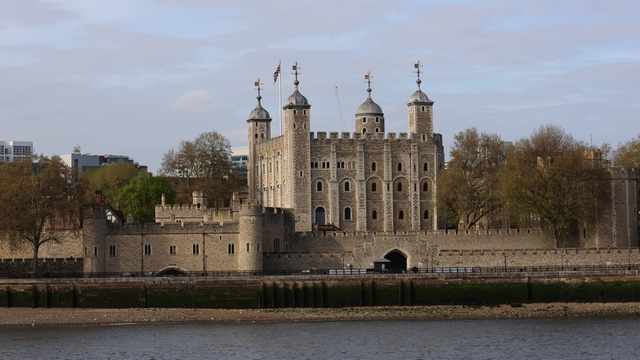
By time we got to the Tower of London it was closed but we walked across the bridge and started walking back towards the hotel along river. From this side of the river you get a great view of the Tower of London --- we even got a bit of sun.
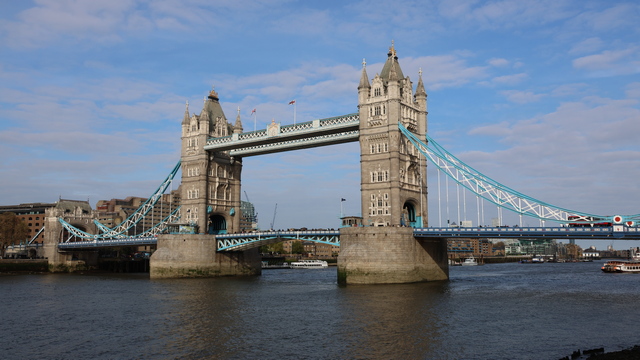
The Tower of London bridge.
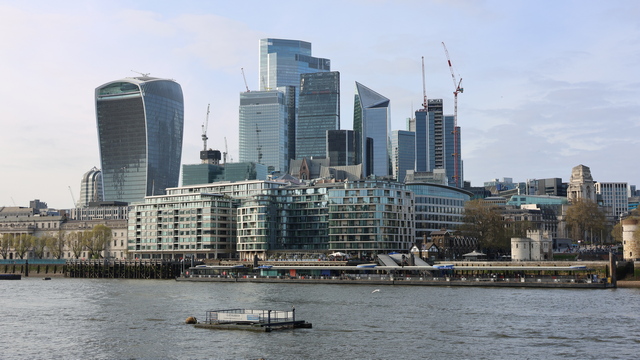
A view of the financial district.
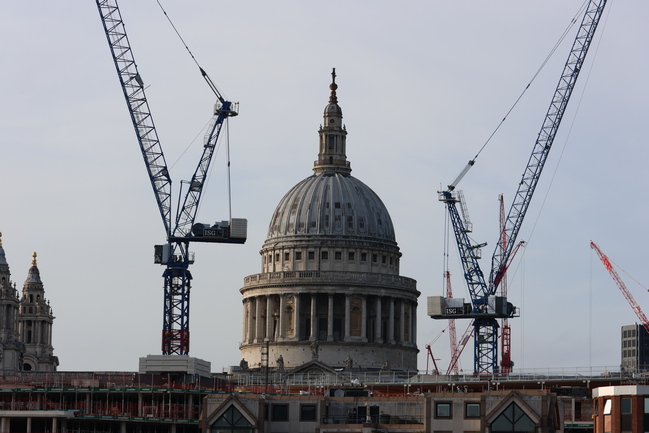
Another photo of St. Paul's dome. I wonder how long it'll be before you can't see the dome from the far side of the river.

The front entrance of the British Museum. The museum is several floors in height and takes up a few city blocks --- it is huge. We spent 4 hours in the museum and could have probably spent 4 days in it.


The head and arm of the statue of Amenhotep III is in the British Museum while the torso remains at Karnak where Ed and I saw it. The Rosetta Stone (pictured on the right) doesn't look like much but it has a lot of historical importance (the Rosetta Stone has the same message written in three different languages, Ancient Egyptian hieroglyphs, Demotic script, and Greek script; this helped scholars to translate hieroglyphs). This is the original Rosetta Stone, Ed and I saw a replica in the Cairo Museum. When British forces defeated the French in Egypt, the stone and over a dozen other antiquities were handed over to the British under the terms of an 1801 surrender deal between the generals of the two sides. It has remained in the British Museum since.

These carved chessmen were found on the Isle of Lewis, one of the places Ed and I are going to visit. The Lewis Chessmen were carved in the 12th century but found in a horde in 1831. These are among the earliest examples in which both bishops and queens are found.
I guess we hadn't spent enough time on our feet after spending 4 hours wandering around the British Museum as we decide to walk to the Tower of London --- about 4 km away if you take a direct route --- we didn't. It was a fabulous walk with lots of surprises.
On the walk was the banking district with some amazing old buildings mixed with modern new structures.

The 'Wild Table Of Love' Animal Sculpture In Paternoster Square. This statue is a temporary and will be leaving May 2023 .... got here just in the nick of time.

The dome of St. Paul's Cathedral. The cathedral's most distinguishing feature is its lead-covered dome, one of the world's largest and tallest domes.

Across from the Lloyd building, which is an amazing structure and worth googling, are several very tall glass buildings that seem to go on forever. You get some interesting imagery with reflections of other buildings. While we were standing and staring at this building, a security guard came outside and told us to go a couple of buildings down where you could take an elevator to the 16th floor and wander a roof top garden get some great views of the city.

The roof top garden --- it even has a water feature. Trimming the hedge must be a chore.

The Gherkin is the round, spiral like building on the right (the left is a reflection). Another building worth googling. From a quick read, it is energy efficient (the shape and all the glass supplies passive solar heating in winter), the shape makes it stable in the wind, and all the glass makes it bright with large open spaces. This building was opened in 2004.

The Tower of London (on the left side about half way up in the photo) and the Tower of London Bridge from the roof top garden.

By time we got to the Tower of London it was closed but we walked across the bridge and started walking back towards the hotel along river. From this side of the river you get a great view of the Tower of London --- we even got a bit of sun.

The Tower of London bridge.

A view of the financial district.

Another photo of St. Paul's dome. I wonder how long it'll be before you can't see the dome from the far side of the river.
2023/05/01: London
Category: General
Posted by: The Agnew Family
A note regarding the photos. When it's overcast thus making the lighting flat, Ed and I shoot a lot of HDRs. This is a technique where the camera is set to shoot three identical photos with different exposures, then the photos are run through a computer program that merges the 3 photos together generally resulting in a photo with good depth and colour. It was overcast in London today, except for a few hours starting late this afternoon. This means we've been shooting a lot of HDRs. Given the amount of time it takes to process the HDRs we've decided to do this when we get home and have access to Ed's fast computer. What this means to the blog is the really good photos will be added when the trip is over. I'll pick the best unprocessed photos for the blog in the mean time.
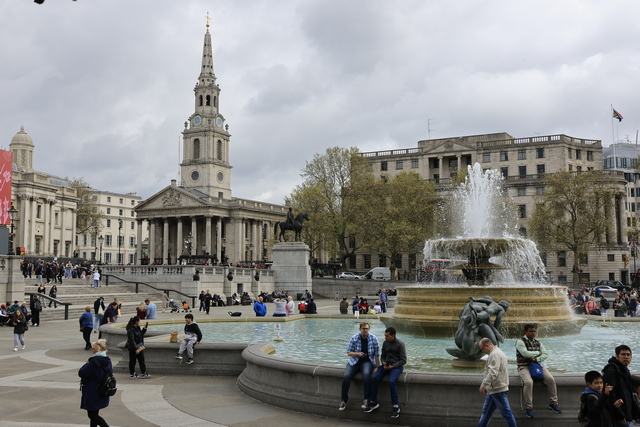
One of the places we walked to today was Trafalgar Square. What an interesting place --- statues, water fountains, an old church and the High Commission of Canada is right across from it.
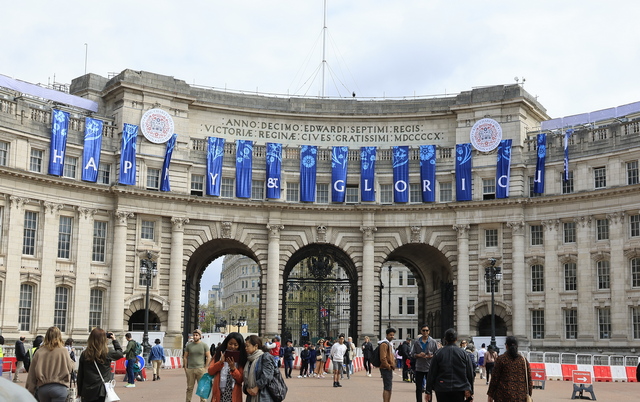
Walking from Trafalgar Square to Buckingham Palace takes you through Admiralty Arch which is the ceremonial entrance to The Mall which is the ceremonial road leading to Buckingham Palace. This photo is looking towards Trafalgar Square. The banner reads HAPPY GLORIOUS.
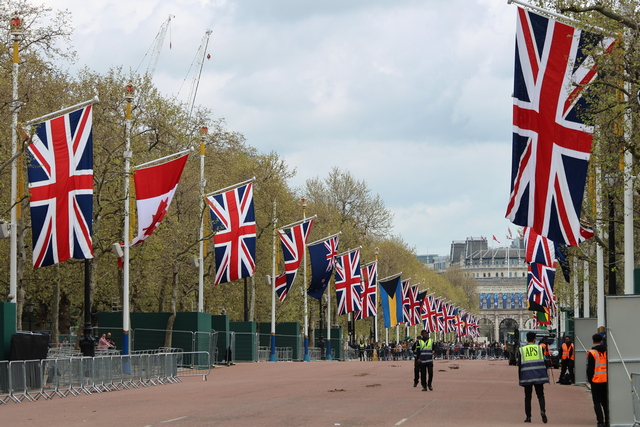
Looking at all the flags lining the Mall from Buckingham Palace.
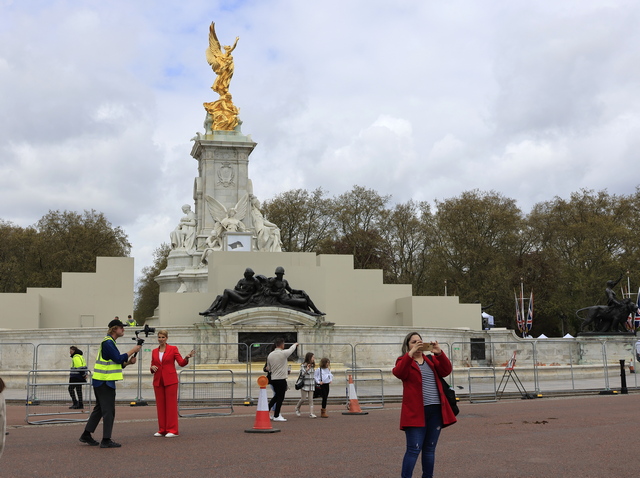
It's very evident that King Charles's coronation is this Saturday. The area around Buckingham Palace is full of tents for the press, viewing platforms for the press and media trucks. Some of the platforms are obscuring the beautiful statues in the area. We saw a number of reporters filming segments. The woman in the red pant suit was one of them. From a tourist point of view It's too bad some of the sites are affected but it is kind of interesting to see history in the making.
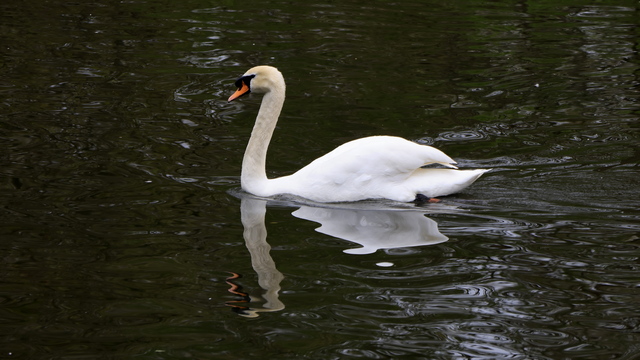
As The Mall is closed, the current walking path takes you past St. James Park lake with many different birds and
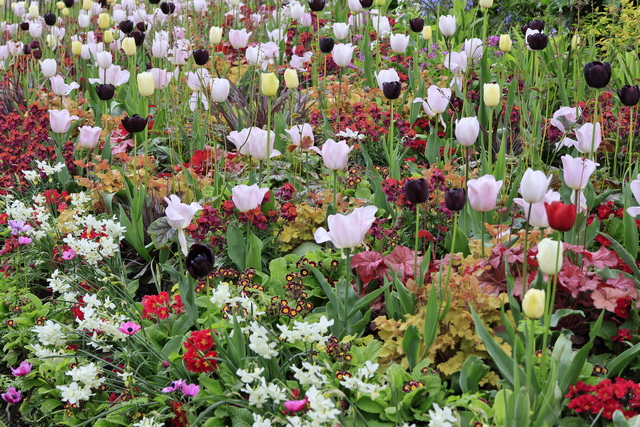
many beautiful gardens along the pathway bordering the lake.
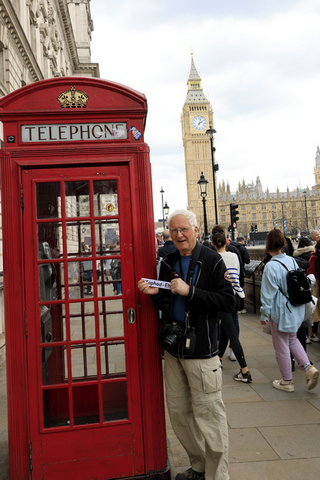
Having your photo taken while you are standing by an old telephone box with Big Ben in the background is apparently the thing to do. We had to stand in line to take this photo of Ed for a geocache. To claim that he found the cache he had to send in his photo. He found several caches today including a couple of them just after another cacher found them. One couple was from France and the other couple was from Finland. Geocaching really is a global hobby.
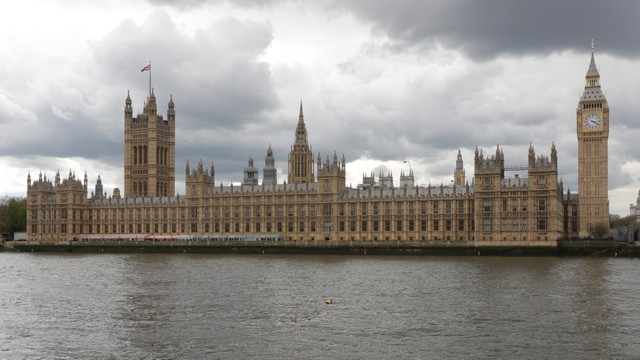
Looking across the River Thames to see Big Ben and the Palace of Westminster (the house of parliament).
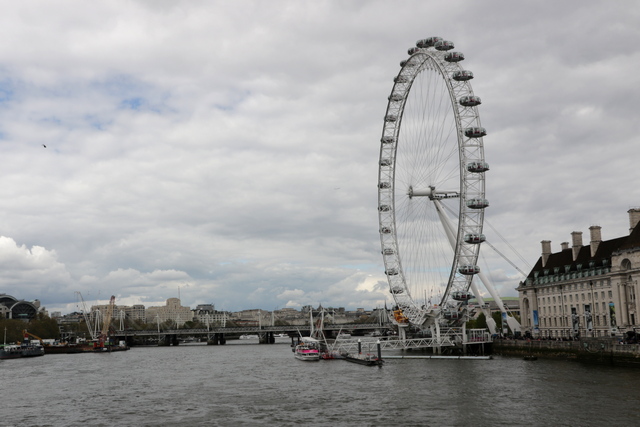
Across the River Thames and the Westminster Bridge is the London Eye, a cantilevered observation wheel.
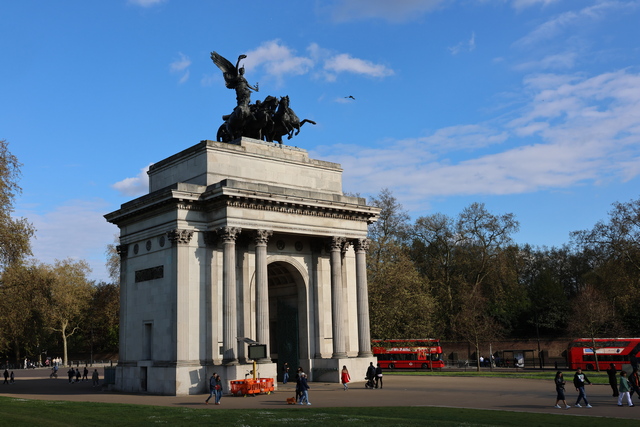
The Wellington Arch looked really nice in the sun with blue sky.
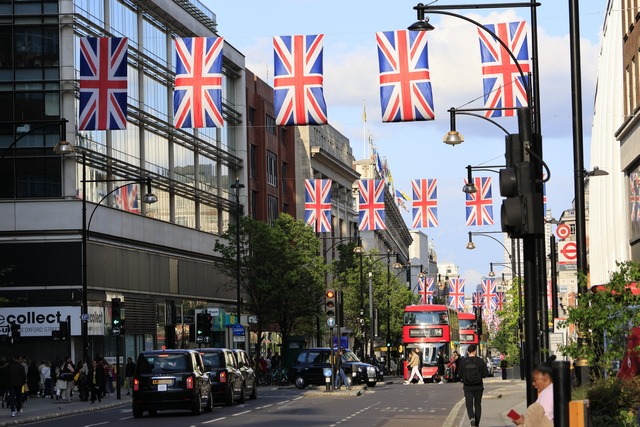
We were walking down Oxford Street on our way back to the hotel. Ed decided the street with the flags was worth a photo. We saw a lot of streets with flags today, I don't know if that's usual or if it's for the coronation on Saturday.

One of the places we walked to today was Trafalgar Square. What an interesting place --- statues, water fountains, an old church and the High Commission of Canada is right across from it.

Walking from Trafalgar Square to Buckingham Palace takes you through Admiralty Arch which is the ceremonial entrance to The Mall which is the ceremonial road leading to Buckingham Palace. This photo is looking towards Trafalgar Square. The banner reads HAPPY GLORIOUS.

Looking at all the flags lining the Mall from Buckingham Palace.

It's very evident that King Charles's coronation is this Saturday. The area around Buckingham Palace is full of tents for the press, viewing platforms for the press and media trucks. Some of the platforms are obscuring the beautiful statues in the area. We saw a number of reporters filming segments. The woman in the red pant suit was one of them. From a tourist point of view It's too bad some of the sites are affected but it is kind of interesting to see history in the making.

As The Mall is closed, the current walking path takes you past St. James Park lake with many different birds and

many beautiful gardens along the pathway bordering the lake.

Having your photo taken while you are standing by an old telephone box with Big Ben in the background is apparently the thing to do. We had to stand in line to take this photo of Ed for a geocache. To claim that he found the cache he had to send in his photo. He found several caches today including a couple of them just after another cacher found them. One couple was from France and the other couple was from Finland. Geocaching really is a global hobby.

Looking across the River Thames to see Big Ben and the Palace of Westminster (the house of parliament).

Across the River Thames and the Westminster Bridge is the London Eye, a cantilevered observation wheel.

The Wellington Arch looked really nice in the sun with blue sky.

We were walking down Oxford Street on our way back to the hotel. Ed decided the street with the flags was worth a photo. We saw a lot of streets with flags today, I don't know if that's usual or if it's for the coronation on Saturday.